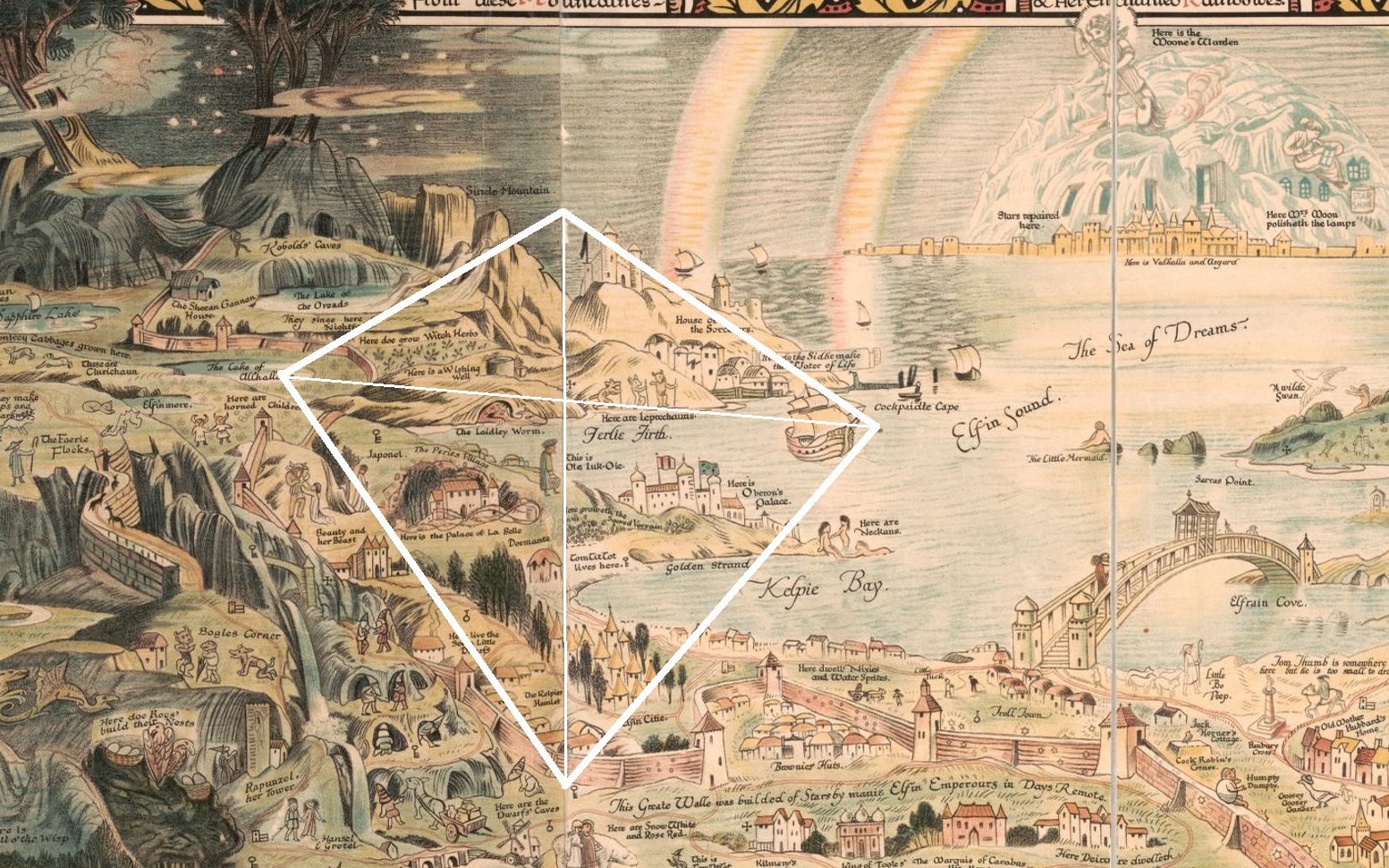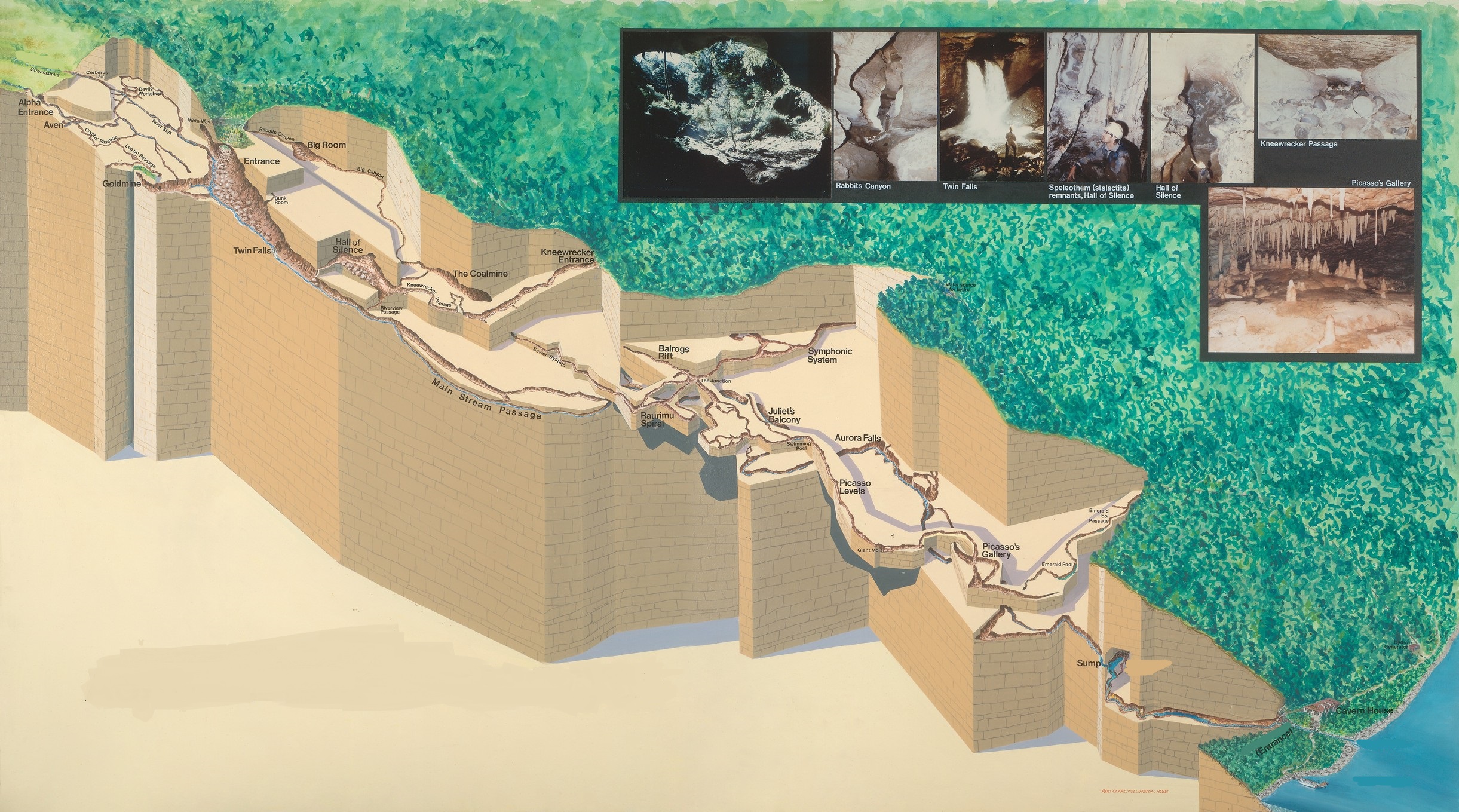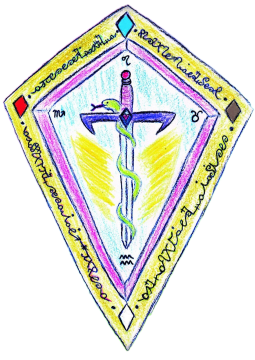
Resources of the Air Realms
Resources of the Air Realms

02. Noël & Jeremy - Pegasus (Lyric Video)

03. Valerie Dore - King Arthur

04. Earth, Wind & Fire - Fantasy

05. The Cure - The Caterpillar

06. Kate Bush - The Sensual World

07. Noël & Jeremy - May We Meet Again

08. Shpongle - Around the World in a Tea Daze (Live London '13)

SONGS OF THE AIR REALMS
02. King Paris - Booji Lala
03. Talking Heads - Papa Legba
04. Led Zeppelin - Going to California
05. Steeleye Span - Thomas the Rhymer
06. Donna Summer - Fairy Tale High
07. Tiny Tim - Livin' in Sunlight, Lovin' in Moonlight
08. Gary Stadler - Dance of the Wild Faeries
09. Charles Manson - Maiden With Green Eyes
10. Robert Plant - Let The Four Winds Blow
11. Jeremy Garner - The Fairy Ring
12. Gary Stadler - Are You Coming With Us?
13. Current 93 - Tamlin
14. The Orb - Little Fluffy Clouds
15. Pauline Anna Strom - Morning Splendor
16. Billy Idol - Kings and Queens of the Underground
17. Led Zeppelin - Over The Hills and Far Away
18. Led Zeppelin - Bron-Y-Aur Stomp
19. Led Zeppelin - Houses of the Holy
20. Led Zeppelin - All My Love
Contents
#1 & 2. Little Tuck & Little Bo-Peep
#3. Cinderella
#4. Mary, Mary, Quite Contrary
#5 - 11. Little Red Riding Hood, the Chymical Wedding, Thomas Rhymer, Tom Tit Tot, Sleeping Beauty, Tom Thumb, Jack & Jill, & Maui
#12 & 13. Cock Robin, Old Mother Hubbard, Taffy, and Compass Secrets
#14, 15, & 16. Humpty Dumpty, the Imp Tree, and King Thrushbeard
#17. The Blue Bird
#18 & 19. Pegasus and Centaurs
#20. Elfin Music
#21. Peter Piper, Mrs Bond & the Pixies
#22. Notes on Avalon and the Underworld
#23. Hidden and Underground Treasures
#23. Hidden and Underground Treasures
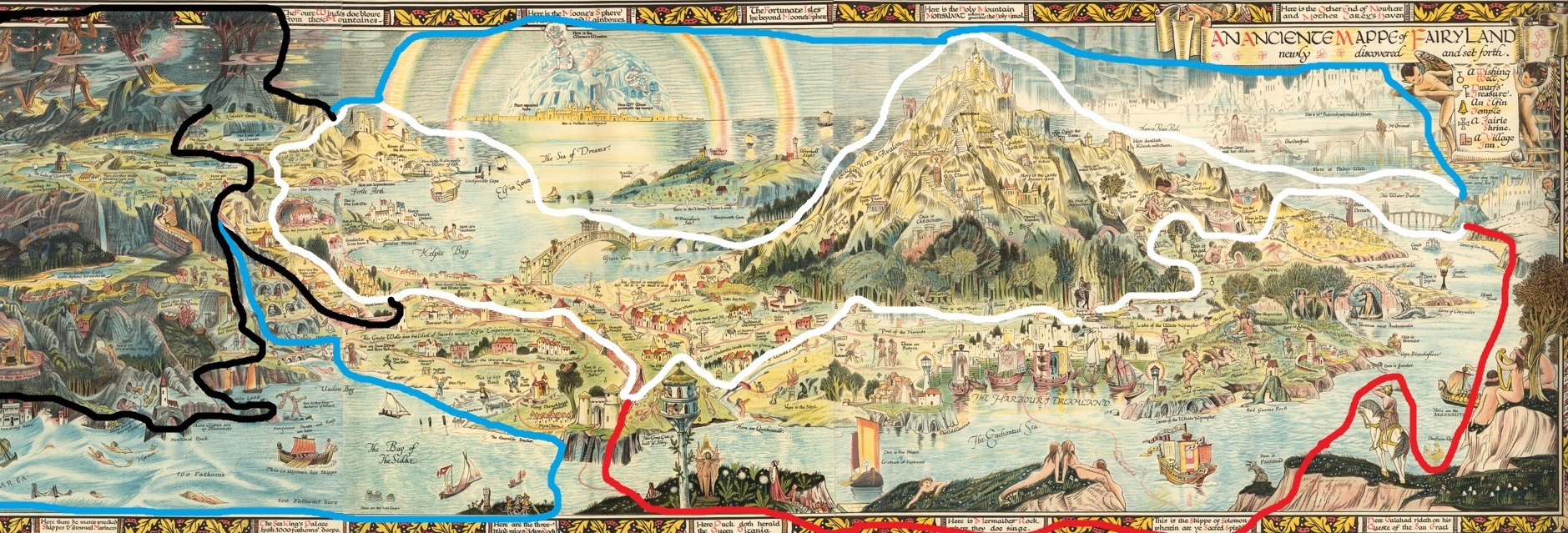
The Air Realm is the most haphazard, confusing, and shifting of all the realms - so that some locations may somewhat differ by the day, but there are enough clues, signs, and landmarks that you are most likely to discover in some form, and these are usually included on the map.
The Mountain of the Holy Grail area over to the right of the map seems to be its own location within the Air Realms - and during my 40 Day Journey to the Faerie Worlds, this was one area that I explored only very minimally so that I will not yet be able to write as much about that section as the rest of the map.
All that I wrote (before seeing the map) in "The Book of Air - Vol. I" about that location is this: "Nine Priestesses rule over the Air World and Garden at different locations, and protect the cauldron or the Holy Grail which resides between the Spring Eastern Air World and the Fall / Autumnal Western World, near the great ocean."
The large palaces depicted in the top right corner of the map are representative of what can be found in the Water/Autumn Realms and are indeed depicted on the map right next to the Mountain of the Holy Grail.
This mountain on the map is referred to as "Avalon", which I also reference in The Book of Air as being associated with Morgan le Fay (who I met in these worlds and who is depicted near the entrance to Avalon on the map). I describe the significance of Lancelot and a certain apple tree due to an experience in which I found a magical apple tree in the Air Realms, and after eating the apple was soon led into utter confusion/madness within the other worlds.
Upon my return to the physical plane, I was very shortly after contacted by a woman called "Morgana" who proclaimed her own connection with Morgan le Fay (explaining that she has been channeling her energy here and there, ever since having had a Near Death Experience) - and she then proceeded to show me her artwork of an apple tree - which looked exactly the same as the one I had just seen in Faerieland.
I describe Morgan le Fay's house in "The Book of Air - Vol. I", (again, before having ever heard of the Map of Faerieland), as a "very church-like building" and I describe Morgan herself as being very "queenly" and "royal", and "dressed in quite frilly looking clothing and with a few others standing nearby". I also describe her as an "enchantress" who "put me under some kind of strange spell" before proceeding to "heal me in a most profound and effective way".
Morgan le Fay's house on the Map of Faerieland is also clearly depicted as being "church-like", with a crucifix depicted at its peak:
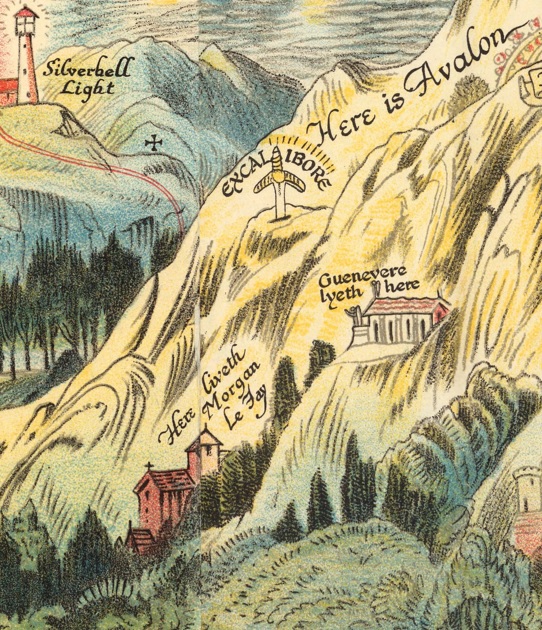
It is my belief that the Faerie "Underworld" highly likely dwells beneath this whole mountain - based on how it is depicted on the map - though this is presently also a relatively unexplored region to myself.
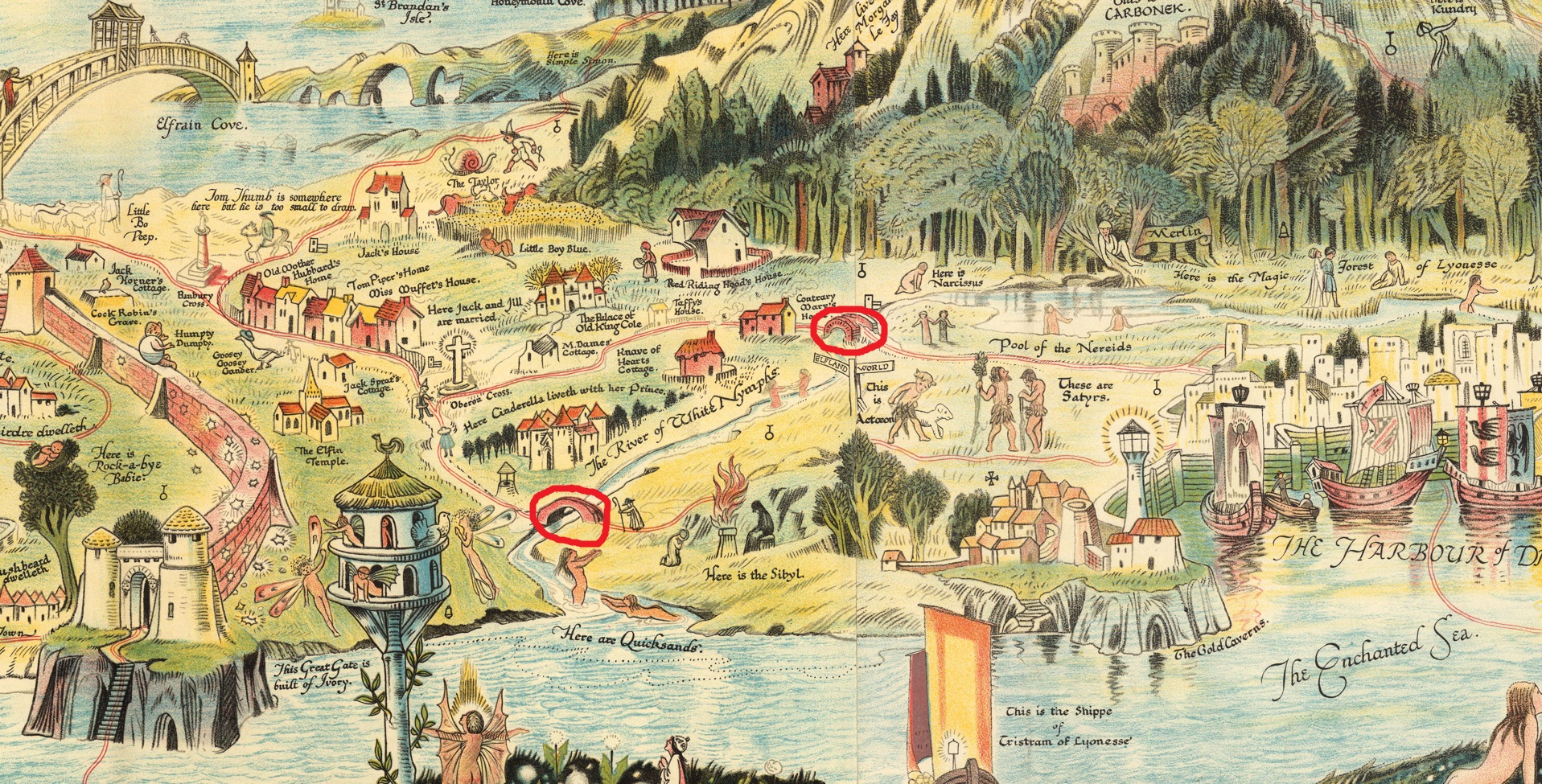
Bernard Sleigh explains that "It" lives:
"in the Trolls' Hut, over Elfrain Bridge, the third hut going inland..."
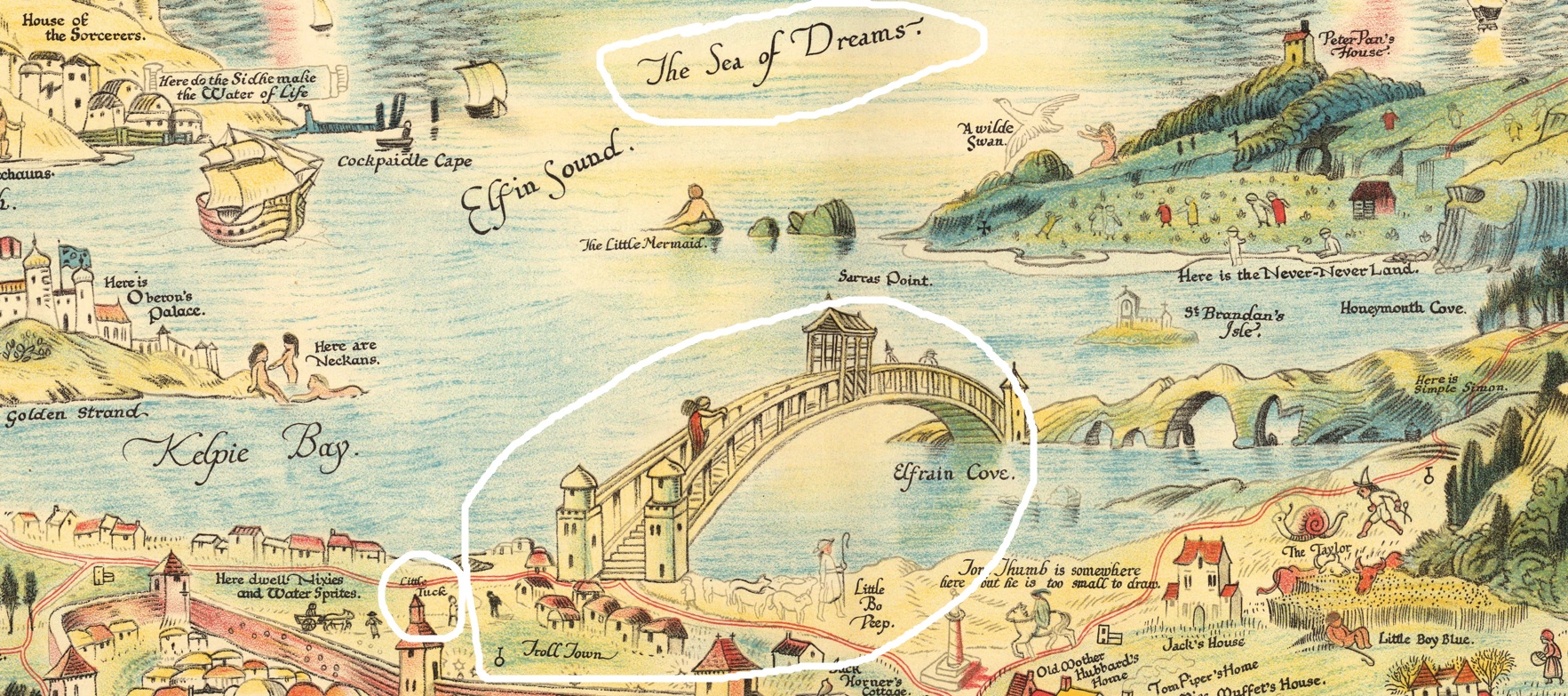
In the "Fire Realms" there is the "Harbor of Dreamland" which Sleigh describes as "crowded" and "bustling", where one waits "long to obtain your passport stamped and sealed, and to have your eyes touched with the magic ointment".
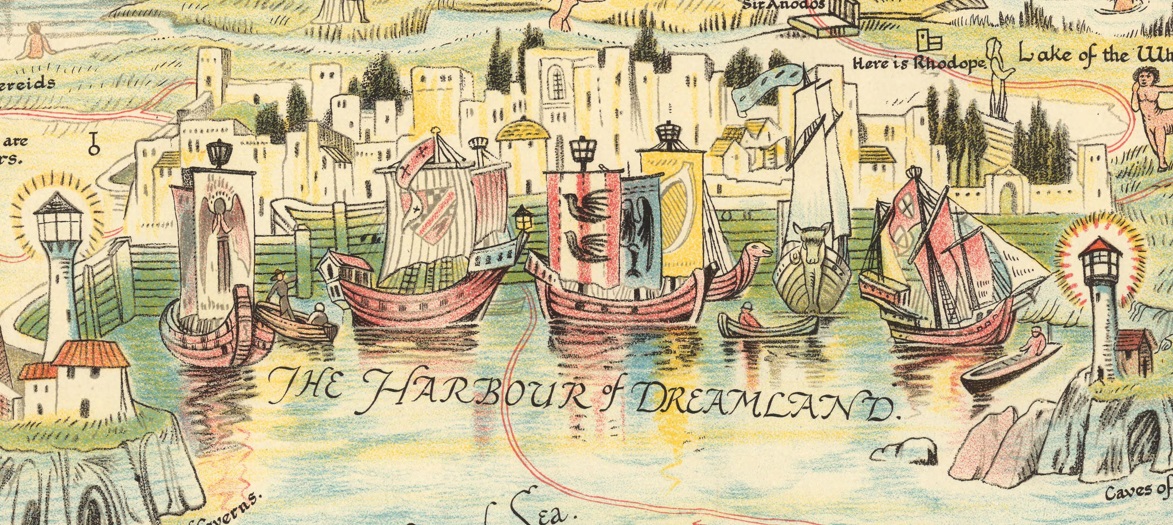
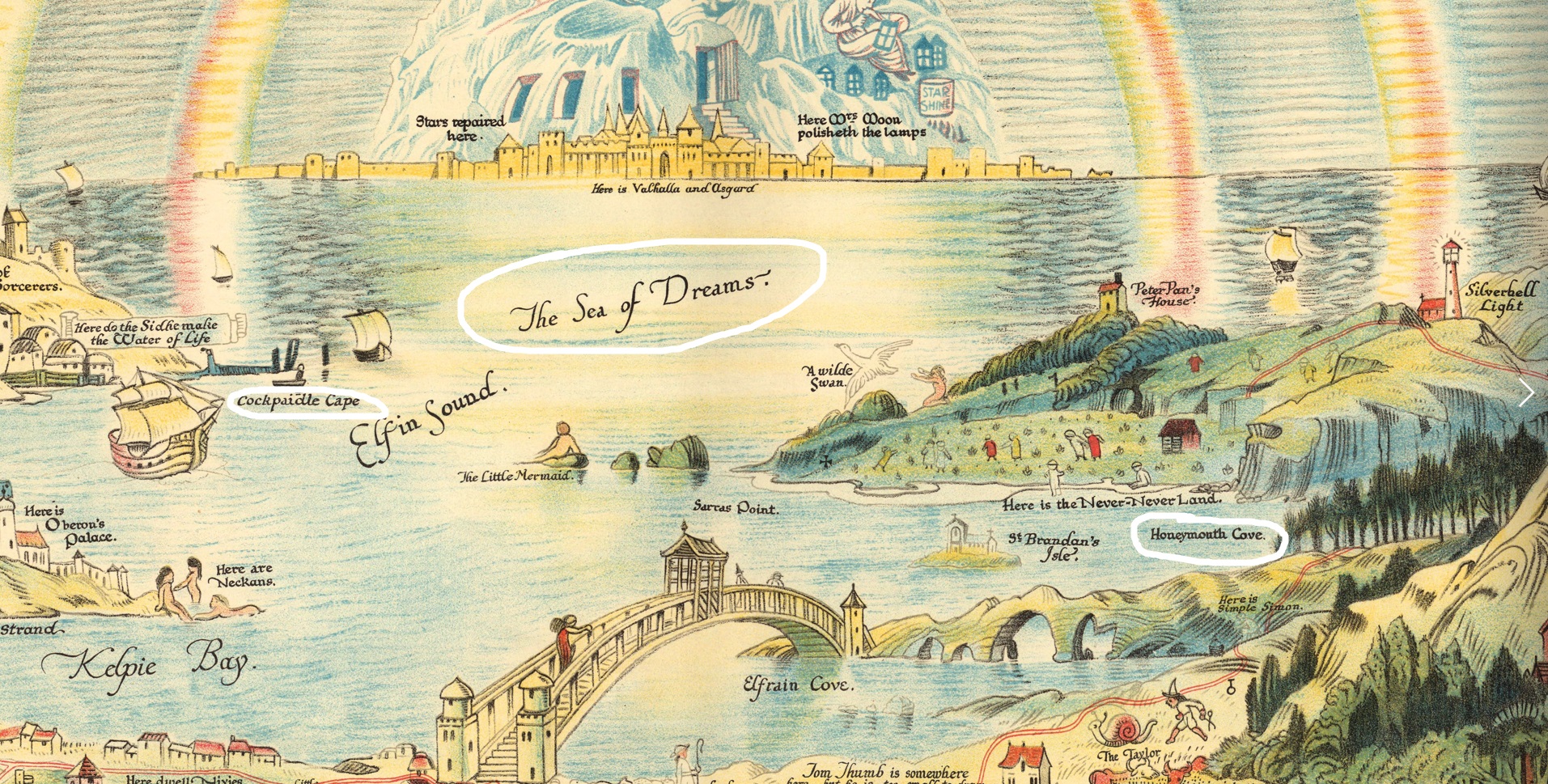

The map says "here are the many valleys of sleep" which I believe must also refer to those in deep dream states as well.
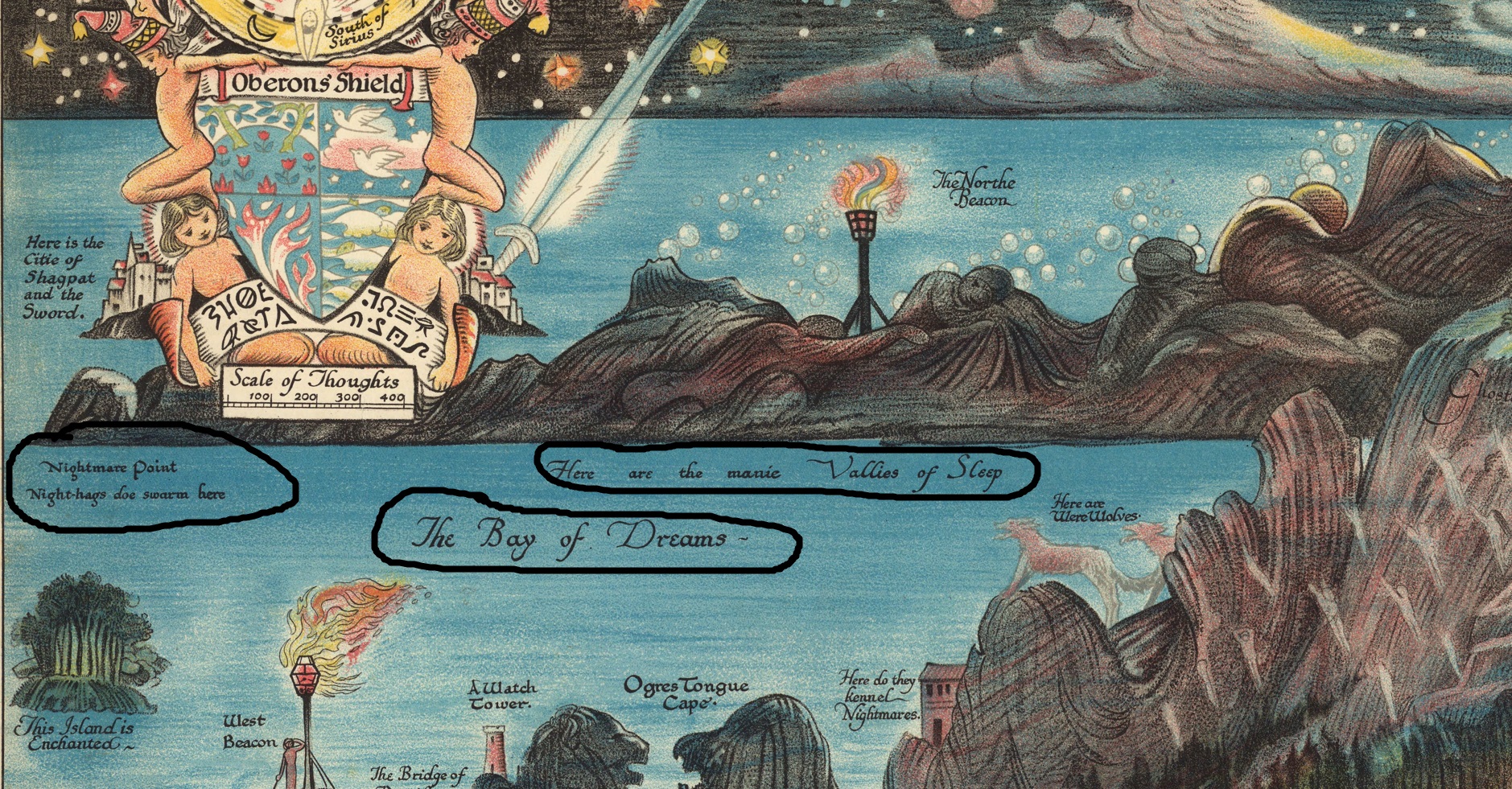
Though J.R.R. Tolkien gradually made changes to many of these faerie references - removing many of these keys or rewriting their places - several of them still survive in posthumously published (by his son Christopher) works such as in "
Back to "Troll Town" though: this part of the landscape is as good as an impenetrable wall, for if you even happen to make it past the trolls (after the Watchers in the Guarded Forest before the bridge - not to mention the angel seen on the bridge also guarding the way), then you will find "Little Tuck" on the Map of Faerieland.
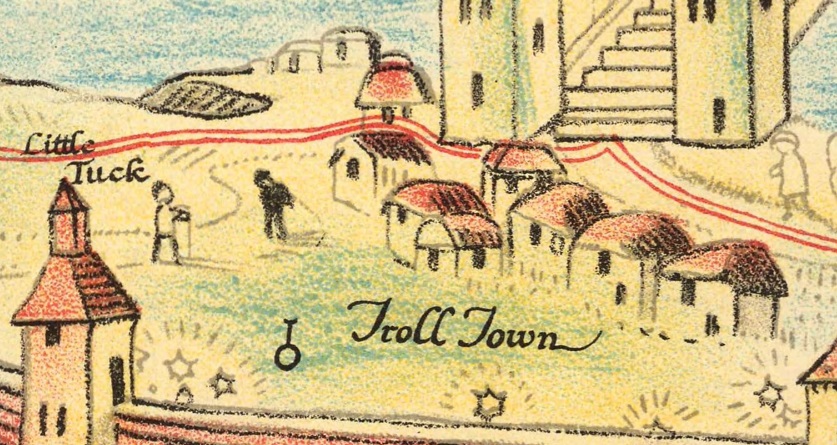
The name given for him in the Hans Andersons' Book (though technically not his real name) is "Little Tuk". He is having to study for a geography lesson but puts the book under his pillow and goes to sleep. After he goes to sleep at night and experiences a great many adventures and much knowledge of the faerie realms (symbolically separated into their various regions under the guise of other locations) then he awakes with no recollection of any of the dreams - but he does know all the information he needs for the lesson. The day just before he had helped a "washerwoman" until it was dark, which was why he could not study the lessons.
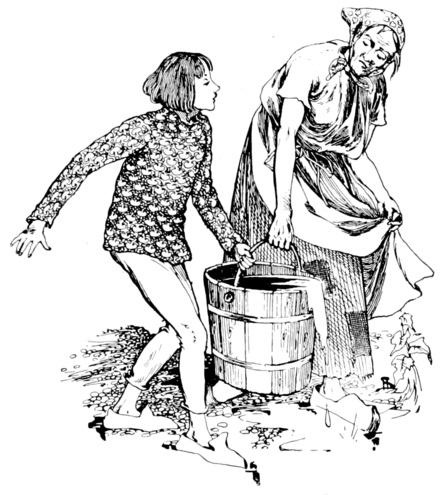
Memory loss in folktales (as well as in UFO/Alien experiences) is a very commonly reported phenomenon. Along with entirely lost sections of time, it is common for people to forget some of the most powerful experiences upon waking. It is quite possible to train ourselves over time to have more chance of remembering dreams however - and then we may recall adventures in these hidden landscapes and unlock even deeper mysteries for the future.
It may be that Bernard Sleigh did intentionally spell "Tuk" as "Tuck" on the map, to represent the meaning of "tucking" the edges of something in so as to "hide or secure them" or to "keep something in a secure place", as well as a double meaning of being "tucked in" bed, where the memories of the adventures of the night may be lost the next day.
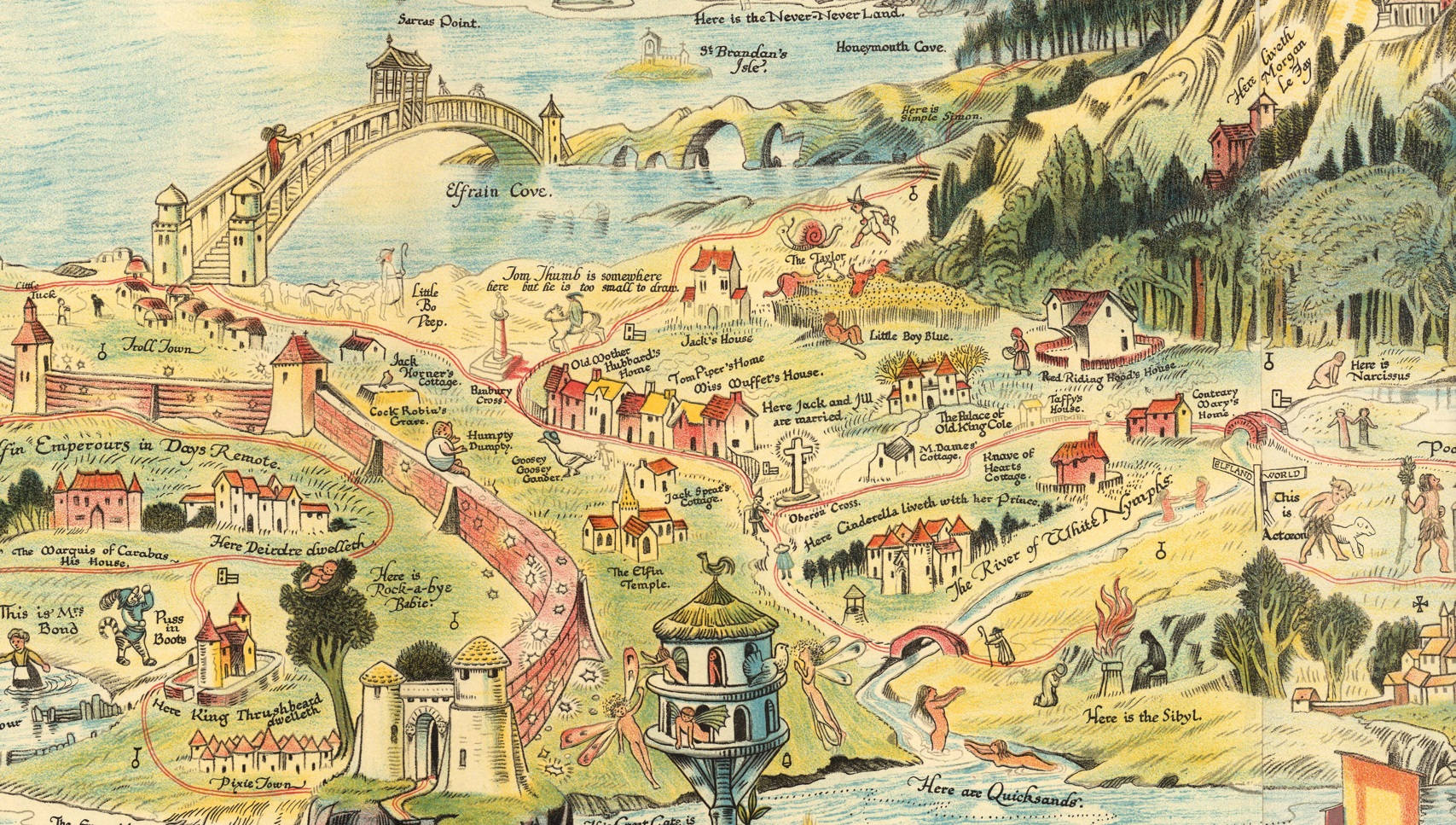
These roads also lead into the Fire Realms which are entirely accessible to the realm of sleep.
Dreams that take place in Never-Never Land (without crossing Elfrain Bridge) are more likely to be remembered.
Alternatively, if you wish to explore not only the outskirts of the Air Realm - but beyond the Great Gate and Impenetrable Wall into Faerieland itself, you must consult with Hermes at the Troll Huts. He is your key to having an unforgettable experience in Faerieland and is himself known as the bringer of dreams and a night guardian.
This is perhaps why "Hypnos" (being the "God of Sleep" and origin of words like "Hypnosis" - and who may have once been regarded as the same as Hermes), is depicted much like him with the winged helmet, winged feet, and holding a staff.
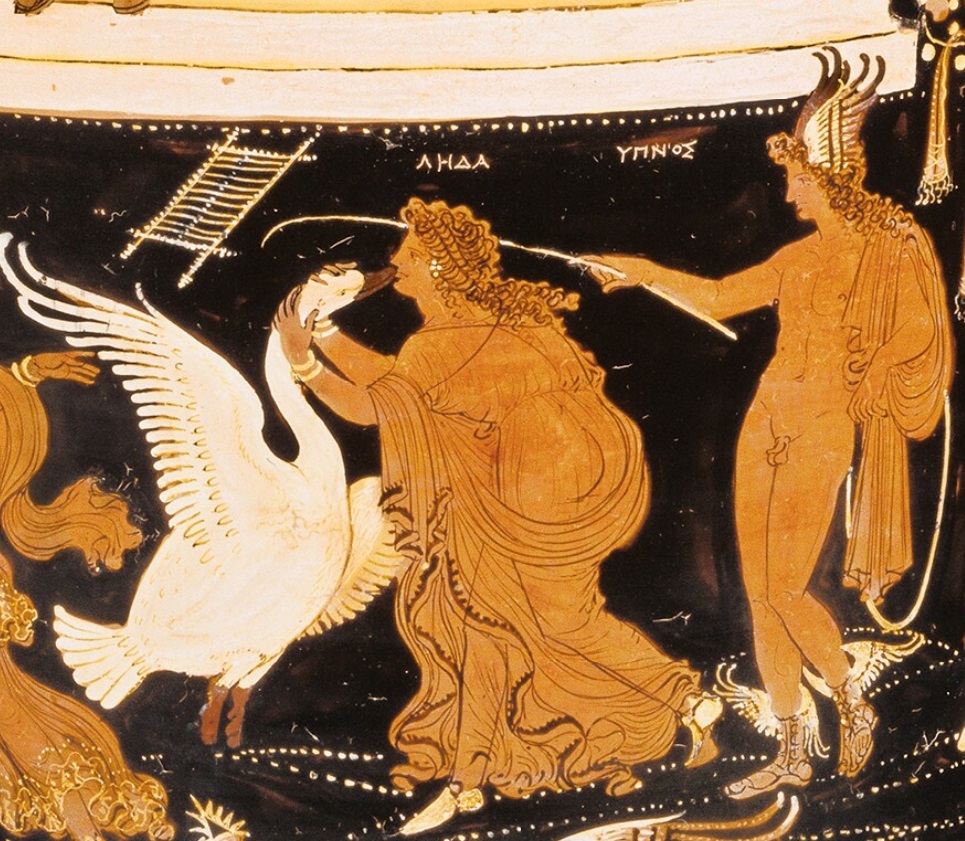
Bernard Sleigh says "Once your guide is secured, the tour of the island to the East of the Great Wall is a thrilling and glorious undertaking; but what you see will depend upon your sympathy with the little people and with those stronger, beautiful spirits of Greek lore..."
Hermes is the one who puts those to sleep who should not see (such as is represented by his dealing with Argus Panoptes (a watcher) - who Hermes lulls to sleep before beheading), while awakening the children into magic landscapes. Hear my song "The Death of Argus" for more.
Going back to the entrance from Never-Never Land (across Elfrain Bridge) there are really only four (or five) main options available which I will explain - but one of these is to go past "Little Bo-Peep", except that this will result in the same dilemma one meets with "Little Tuck".
People will often count sheep to fall asleep so the theme is already somewhat synonymous - though the idea of gathering and keeping track of your dreams in order is represented here.
Little Bo-Peep loses her sheep and can't find them, and feels that if she leaves them alone, then they'll come home dragging their "tails" behind them. But then Little Bo-Peep falls fast asleep and dreams of hearing them bleating, until she wakes up and realizes it's a joke and that they are still fleeting from her. (the fleeting memories of the air world which will escape). Then even with determination to find them again (or to remember the dreams of the night), she "found them indeed, but it made her heart bleed, for they'd left their tails behind them".
Tails in this case is a humorous double meaning of "Fairy Tales" - meaning that it is no use to remember vague recollections of fleeting imagery if you remember none of the stories, tales, or events which actually took place during the night.
What then happens is that during the day you may catch glimpses of certain things which remind you of the night before - and may start to piece little visions together. Though it is highly probable in doing so that the order may all get mixed up, and the task is very difficult.
Bo-Peep finds all their tails hanging on a tree to dry, then heaves a sigh and wipes her eye - and then tries her best to tack them on to the right sheep (which is a near impossible task).
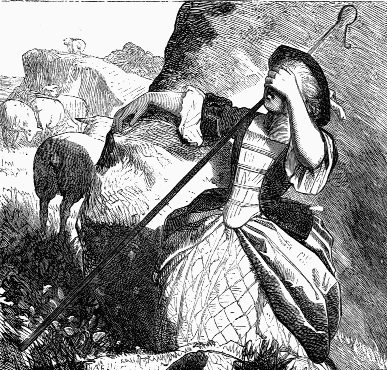
"BO" is a very ancient word with deep correlations to the Faerie Queen herself who (as I have more deeply described in my "Guide to Faerieland" book (in the "Mystery of the Primrose"), my "Faerie Magic" book, and in my "Book of Air - Vol. I", takes on a symbolical form of the Cow Goddess. (Hermes also saves the Goddess in white heifer/cow form from watchful eyes).
There is the Irish "Bo Find" (white cow) who transformed Ireland from a barren land into a green and fertile one with her sisters Bo Ruadh (red cow) and Bo Dhu (black cow). Clearly the White Cow is the Maiden, the Red Cow is the Mother and the Black Cow is the Crone of the Triple Goddess of Faerieland. She is the Faerie Queen (known in Ancient Egypt as "Hathor").
Bo is a very ancient word for "cow" - hence "bovine", and the Faerie Queen (as in Hinduism) is a Sacred Cow - nurturer and provider. The word "galaxy" is also related to "galag" (milk), hence the "Milky Way", etc. Common and countless are the tales of faeries and the cows.
Therefore "Little Bo-Peep" - caught a "peep" ("to look, especially through a narrow opening and often from a place of secret concealment"), of "BO" or the "Faerie Queen" and the hidden or secret mysteries of Faerieland. Thus "Little Bo-Peep" is placed to the right of "Troll Town", with "Little Tuck" placed to the left - as symbolic images of the forgetfulness of these dreams that one may acquire if they manage to stray into the sacred faerie realms in their sleep.
Incidentally, Little Bo-Peep is facing the completely opposite direction to the Faerie Queen's Castle (shown as "Oberon's Palace" on the Map of Faerieland). She is already clearly lost - which is a most common experience of any who stray into the wayward Realms of the Air.
As further confirmation of these conclusions - in Sleigh's original version of the map, this very same bridge was entitled the "Bridge of Dreams".
These are then the available options:
Option #1. Go past "Little Tuck" and erase your memory of anything you experience.
Option #2. Go past "Little Bo-Peep" with the same effect.
Option #3. Get attacked or trapped by trolls.
Option #4. Go back across Elfrain bridge to Never-Never Land.
Option #5. Meet Hermes in Troll Town and ask him to be your Guide to Faerieland.
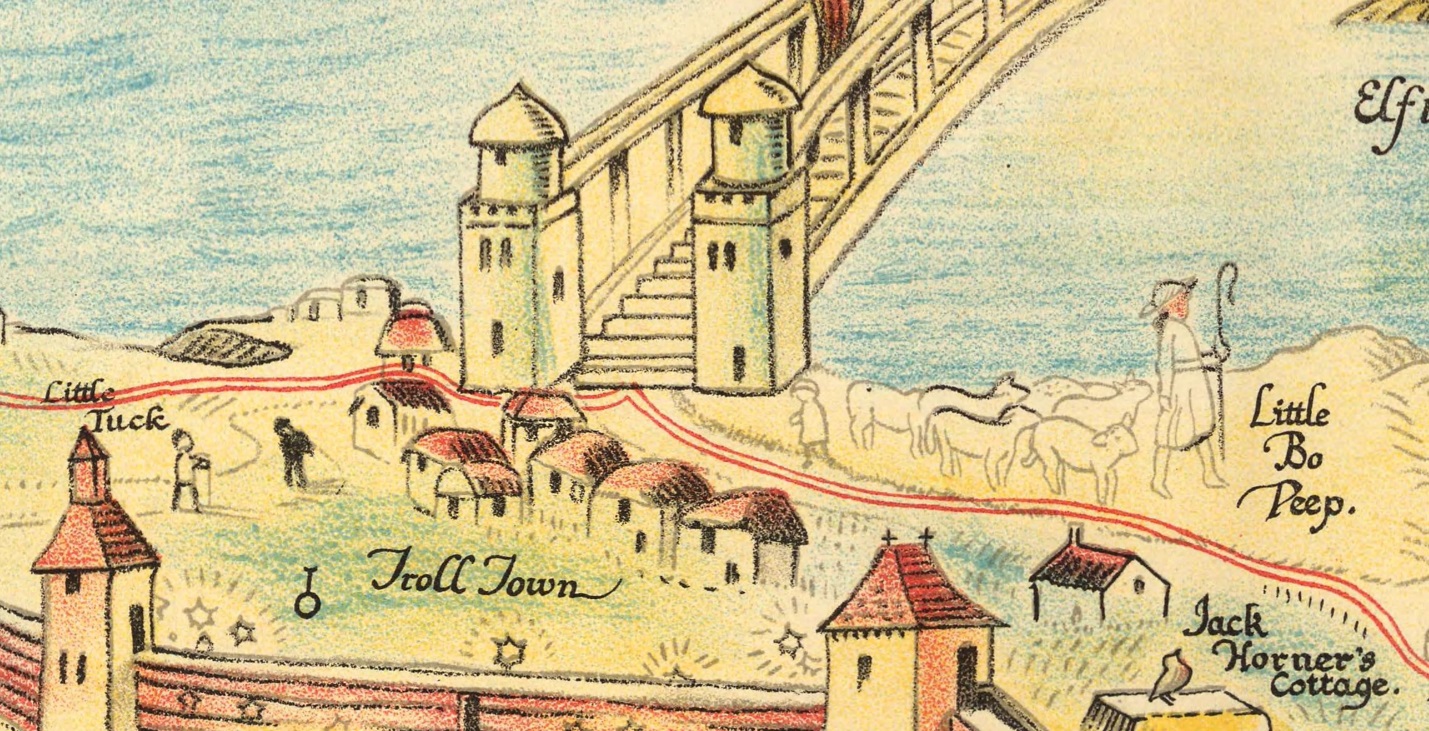
Book #3. Grimm's Household Tales
Chapter 21. CINDERELLA
The first and clearest symbol of the Air/Spring Realm is when Cinderella is gifted a branch from a hazel bush. Just as the symbol for the Fire Realms is the sword/dagger - the symbol for the Air World is the wand/staff. The staff of Mercury/Hermes is also said to have been made with Hazel Wood to aid him in his travels between the human and spiritual realms.
As I explain in my book "Faerie Magic", the word "wand" stems from Proto-Germanic "wend" which is "to turn" or "to wind". The notion is of a bendable and flexible stick. The word "wind" has the double meaning of "twisting/turning/binding" and also "wind" as in the air element.
In one of Fiona Macleod's books it is written: "he waved a withe of hazel he had in his hand" (a "withe" being a flexible branch), and when asked what for he responds:
"It is to open a door that is in the air."
The word "wand" is also connected to the word "want" and will assist us in bringing our desires (as it did for Cinderella). In the story of Cinderella, she plants a hazel-bush branch in the ground, watering it with her tears until it grows into a handsome tree. Then when she prays beneath this tree, a little white bird appears (symbol of the fairies of the air realms), and throws down anything that Cinderella wishes for from the tree.
We therefore have an undeniable symbol at the very entry into "Elfland" on the faerie map - of the Wand/Spear/Staff symbol that is associated with the Spring/Air/Gorias/Faerie Realms.
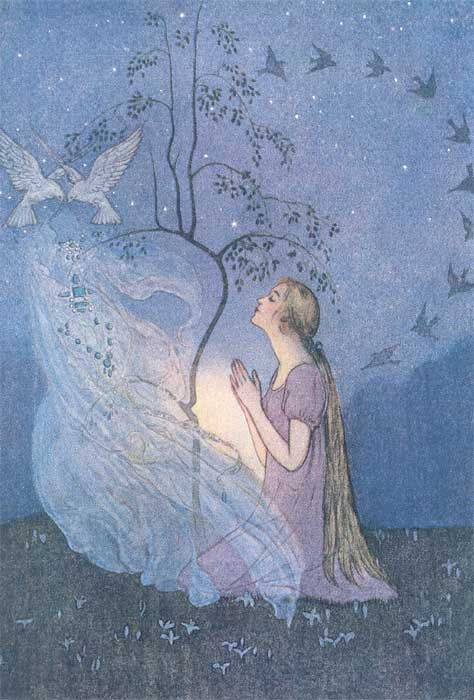
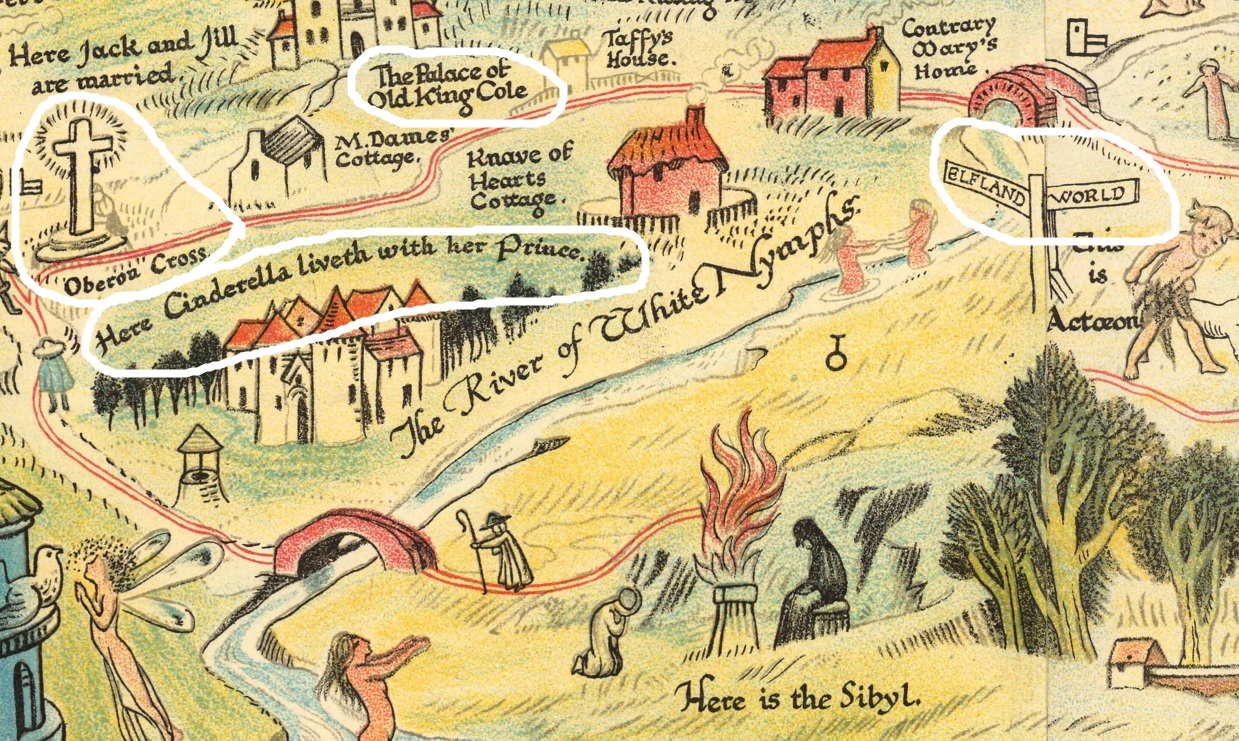
She is also a symbol of the white "maiden" who is the symbol of Spring and the Air Realms. "It's just a spring clean for the May Queen..." - Led Zeppelin, Stairway to Heaven
Though she is dirty among the ashes, she washes herself clean (spring cleaning: Imbolc, the festival of Spring is from Irish "imb-fholc" which means to "wash/cleanse oneself", referring to a ritual cleansing).
"Cinderella first washed her hands and face clean, and then went and bowed down before the king's son."
When the two sisters attend the wedding (one on the left side and one on the right side), the white birds of the air realms pluck out an eye each. Then later on their way back, the birds pluck out their remaining eyes - punishing them with blindness. This is very symbolic of what was discussed in the previous "Little Bo-Peep" section - where Hermes puts out the eyesight of those not permitted into the realms - and guides those that are. There is the left path with Little Tuck and the right path with Little Bo-Peep - both representing forgetfulness/blindness (though the figures did nothing particularly wrong and are used as symbolic representations only). The middle path then can lead to Hermes and he has the power to awaken the second-sight.
"In my experience, the first path forward (the middle path) was certainly the most healing and purifying. For it was this path which led me through the beautiful forest and to the baptismal waters of healing and gems – where I was renewed, replenished and saw the white doves of descending knowledge." - The Book of Air - Vol. I
For example: "The song the pixies were all singing when I had first entered the house was "Mary, Mary, Quite Contrary" and they all seemed to love this song very much."
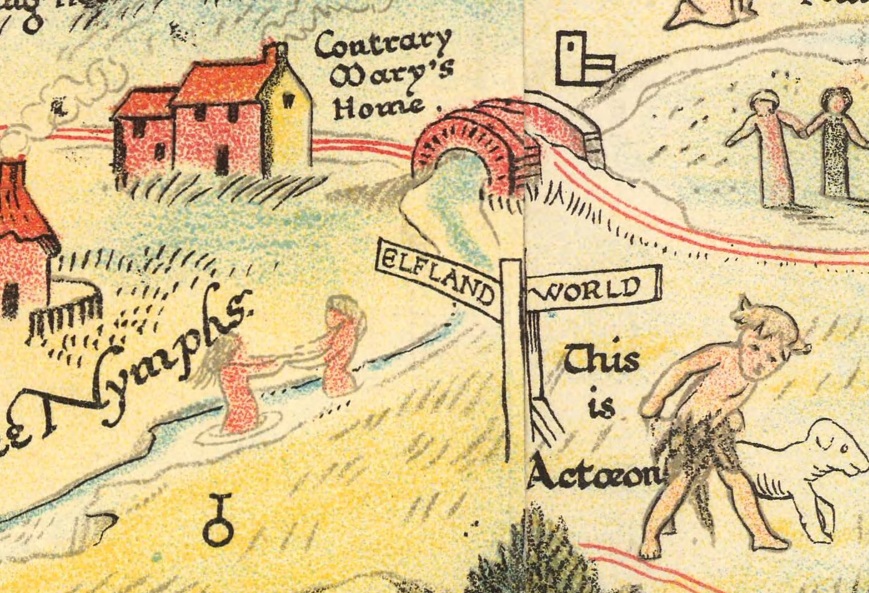
In Rome there were festivities between the days of April 28 and May 2nd that were in honor of the Youthful Flora – Goddess of Flowers.
So May Day, Maidens, Primroses, and the Virgin Mary are all connected.
It is interesting then to again consider the Nursery Rhyme:
“Mary, Mary, Quite Contrary,
How does your garden grow?
With silver bells, and cockleshells,
And pretty maids (or cowslips/primroses) all in a row.”
The word “contrary” means “opposite” so when we see the words “Mary, Mary, Quite Contrary...” then it also seems to imply the question of how can her garden grow if she is not really doing the normal thing (or anything at all for that matter) to grow it?
It is not irrelevant to remind the reader of the Isle of Apples which is described in
This Isle of Apples is ruled over by Morgan le Fay, who is chief priestess of nine magical queen sisters who dwell/rule there.
These Nine Priestesses rule over the Air World and Garden at different locations, and protect the Cauldron or the Holy Grail which resides between the Spring Eastern Air World and the Autumnal/Fall Western World, near the great ocean."
Book #5. Little Red-cap
"Chapter IV. Maui Snaring the Sun"
The first is a story perhaps better known to us as "Little Red Riding Hood" and at first glance it might appear to be something more suited for the "Fire Realms" with its red color - but soon I will explain: this is a very fitting story for the Air World, where it is drawn on the map.
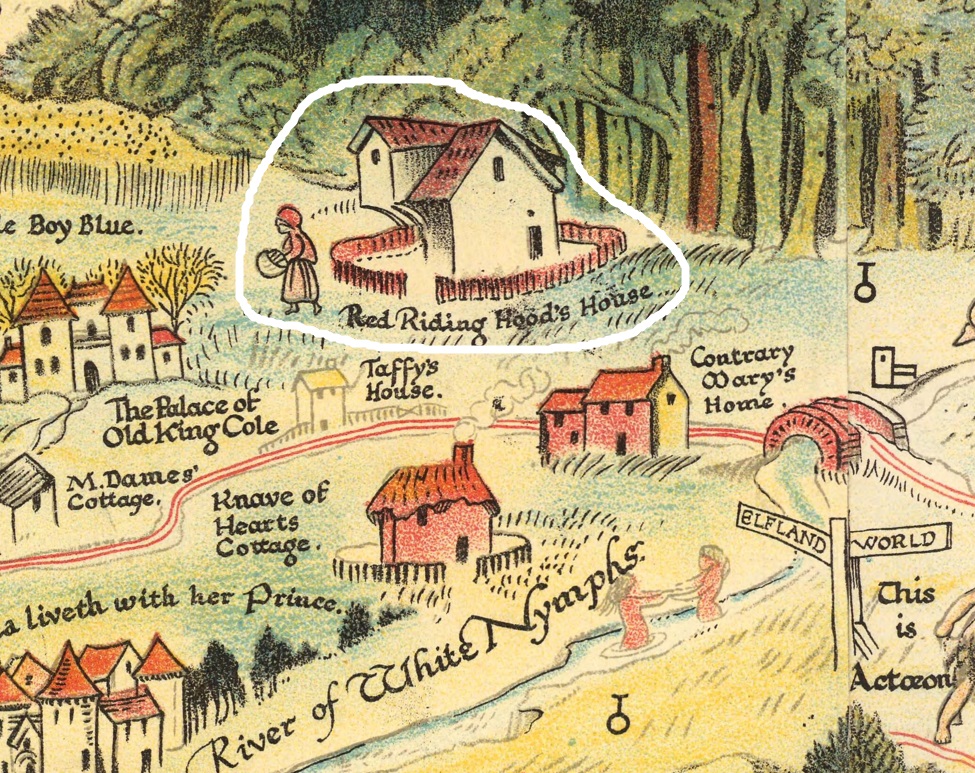
"It must also be related how a few days afterwards, when Little Red-cap was again taking cakes to her grandmother, another wolf spoke to her, and wanted to tempt her to leave the path; but she was on her guard, and went straight on her way, and told her grandmother how that the wolf had met her, and wished her good-day, but had looked so wicked about the eyes that she thought if it had not been on the high road he would have devoured her." - Little Red-cap, Household Stories
This reminds us of what Bernard Sleigh writes in his Guide to the Map of Faerieland:
"You will find the best routes marked out with lines, as red and as fine as the silken clue that guided Theseus through his Cretan labyrinth. If you stray not from the path, you too will be as safe."
I alluded to this same theme throughout my "Book of Air - Vol. I" on multiple occasions - for the entire land can be extremely bewildering and has many choices and pathways to take - but the one who continues on the heart's path, finds their way to the center of the labyrinth. During my travels, I took just about every road I could find - walking into danger and learning a great deal from the journey: but the advice is to take the middle and the straight path only (at least at first).
An Excerpt from my "Book of Air" says: "The straight and middle pathway to the heart is the road into Faerieland. Daedalus's instructions for navigating the labyrinth are to: "Go forwards, always down, and never left or right.""
I also wrote: "Just as it is required to travel on the straight path into the west beyond the confines of the physical realm to enter Tír na nÓg – Valinor is also only reached by the “Straight Road” and in special ships which are capable of passing outside of the spheres of Earth."
I then further discuss the importance of the Rosicrucian text "The Chymical Wedding of Christian Rosenkreutz" to this journey, which outlines these same pathways which are also clearly referenced in the "Ballad & Romance of Thomas Rhymer & the Elfland Queen".
In the Chymical Wedding of Christian Rosenkreutz (founder of the Rosicrucian Order), we see clear references to the Queen of Elfland or the Faerie Queen - and he is given the four paths of the "Crossroads" symbol, synonymous with the Air Realms, to potentially reach the castle of the Faerie King and Queen (all in allegorical form).
The book says: “By us the Bridegroom offers you a choice between four ways, all of which, if you do not sink down in the way, can bring you to his royal court. The first is short but dangerous, and one which will lead you into rocky places, through which it will scarcely be possible to pass. The second is longer, and takes you circuitously; it is plain and easy, if by the help of the Magnet you turn neither to left nor right. The third is that truly royal way which through various pleasures and pageants of our King, affords you a joyful journey; but this so far has scarcely been allotted to one in a thousand. By the fourth no man shall reach the place, because it is a consuming way, practicable only for incorruptible bodies. Choose now which one you will of the three, and persevere constantly therein, for know whichever you will enter, that is the one destined for you by immutable Fate, nor can
you go back in it save at great peril to life.”
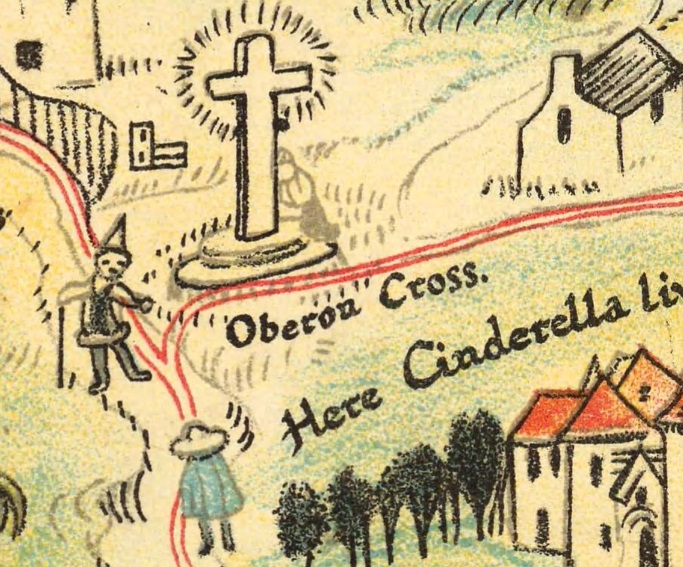
“O see you not yon narrow road,
So thick beset with thorns and briars?
That is the path of righteousness,
Though after it there's few inquires.
And see ye not yon broad, broad road
That lies across yon lily leven?
That is the path of wickedness,
Though some call it the road to Heaven.
“And see ye not that bonny road,
That winds about the fernie brae?
That is the road to fair Elfland
Where you and I this night must go.”
She further describes how taking the correct path will lead to the castle of the Faerie Queen:
“See you yet a fair castle that stands on yon high hill? Of town and tower it surpasses all: on Earth there is none like it. In truth, Thomas, that is mine own, and the King's of this country.”
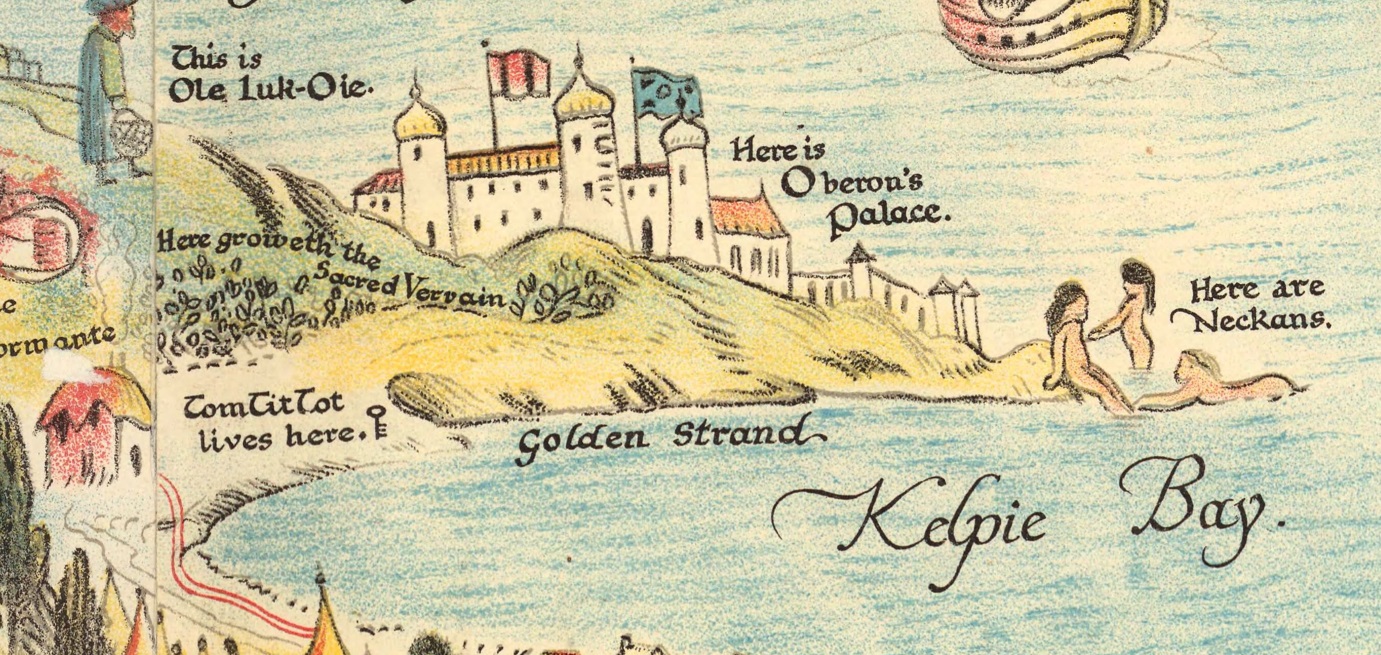
First of all it is necessary to understand that in "Middle English", the color "red" was actually characteristic of "PURE GOLD" or objects made of gold.
Some have speculated that it may have had something to do with an ancient practice of testing the purity of gold by heating it ("fire is one test of its goodness, as, when submitted to intense heat, gold ought to assume a similar color, and turn red and igneous in appearance; a mode of testing which is known as "obrussa."" - Natural History, Pliny), but whatever the case may be: in Middle English "Red Gold" was considered to be "Pure Gold".
Notice in the image above that Bernard Sleigh has drawn a little "key" next to the house of "TomTitTot". This key represents "dwarf's treasure". We know that TomTitTot is a very small "little black thing with a long tail". He is also very good at spinning thread.
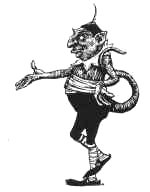
This is a clue to the hidden dwarf's treasure.
In the "Guide to the Map of Faerieland" we read this: "In the Heart of every child, is hidden away a little golden key which unlocks the door of a silent, clean swept room full of changing lights and mystic shadows. There, every child that is born into the world enters at times to gaze eagerly upon the one great window, pictured with ancient legends, and glowing with many colors: amber and scarlet, lapis blues and strange greens."
Oberon's Palace is at the "Heart" of the Labyrinth. On the Faerieland Emblem you can see where each of the cities and directions correspond to the points on the kite-shape and how when you travel them in this particularly sacred order, it will form the "Eihwaz" rune. ᛇ
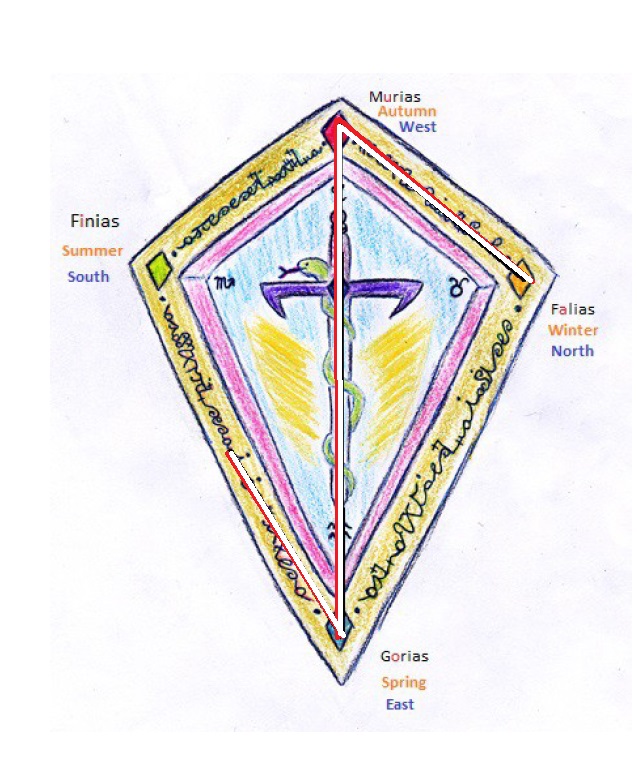
(Distances in Faerieland are very difficult to explain in writing and there is a great deal more infinite-feeling space within the Air Realm than what there appears to be on the map itself).
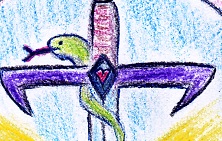
Ariadne falls in love with Theseus and gives him some "thread" on his way to slay the minotaur, so that he can find his way back out of the labyrinth by retracing his steps with the use of Ariadne's Thread.
The color of this thread has been debated between "Red" or "Gold" or perhaps also "White". In Thomas Bulfinch's "Age of Fable" - the color of the thread is not described, but it is called a "CLEW OF THREAD". This is an archaic variant of the word "CLUE", but it is actually what balls of thread were called.
It certainly serves a double purpose on the Map of Faerieland - for here we are given a "clue" of its color, when Sleigh (right next to TomTitTot who is associated with spinning threads) writes: "GOLDEN STRAND".
We also read in the guide of the "GOLDEN key" (found at the "heart"), and he writes that the great window glows with many colors such as "Amber and Scarlet". Amber being very close to "GOLD/YELLOW" in color, and scarlet being close to "RED". He is intentionally connecting these two colors as being synonymous with one another as these two merge into each other.
Let us see further clues of this nature in the Guide to the Map: "At one time or another of its life, every child that is born of woman sets trembling fingers to open wide the flashing casements - to stand gazing, awed and silent, upon a sea and sky of gold and crimson..."
Here (as with the "amber and scarlet" before) we are seeing him again connect gold with red (crimson being a reddish color).
He also writes "Go, if you can, always in the early Spring, for then the whole land is blushing with wild roses, shimmering with golden, thornless broom, or white with wild waving lilies..."
The word "blushing" implying "red" roses - followed by thornless golden/yellow "broom" - so that again these colors are seen side by side.
The final CLUE/CLEW is this: "You will find the best routes marked out with lines, as red and as fine as the silken clue that guided Theseus through his Cretan labyrinth."
A great "clue" is revealed here - for he specifies the "silk" thread to be of a "RED" color - (which it is clearly shown as being throughout the whole map). And yet at the very "heart of the labyrinth", next to TomTitTot (the weaver of thread) - we clearly see the peculiar words "Golden Strand". The word "strand" referring to the "shore of the sea" but of course being another term for "thread" - brought to mind by the associated "weaving" fairy tales nearby.
Very near to the house of TomTitTot is also the house of "Sleeping Beauty" which is called the "Palace of La Belle Dormante" which is the original French name for this well known fairy tale - which has strong connotations to the weaving "spindle" and similar themes about threads.
In the story, Rosamond falls asleep for 100 years while using the spindle (after she had been earlier cursed), and everything in the house falls asleep also until the whole palace is entirely overset by thorns and brambles. Most that tried to take that path would then die by the dark and dangerous thorns until after 100 years when a prince did get through the thorns and awaken her into love.
This palace stands to the left direction of the Faerie King and Queen's castle - and is placed there perhaps to represent the "yon narrow road, so thick beset with thorns and briars? That is the path of righteousness, though after it there's few inquires." - which is spoken of in the Ballad of Thomas the Rhymer.
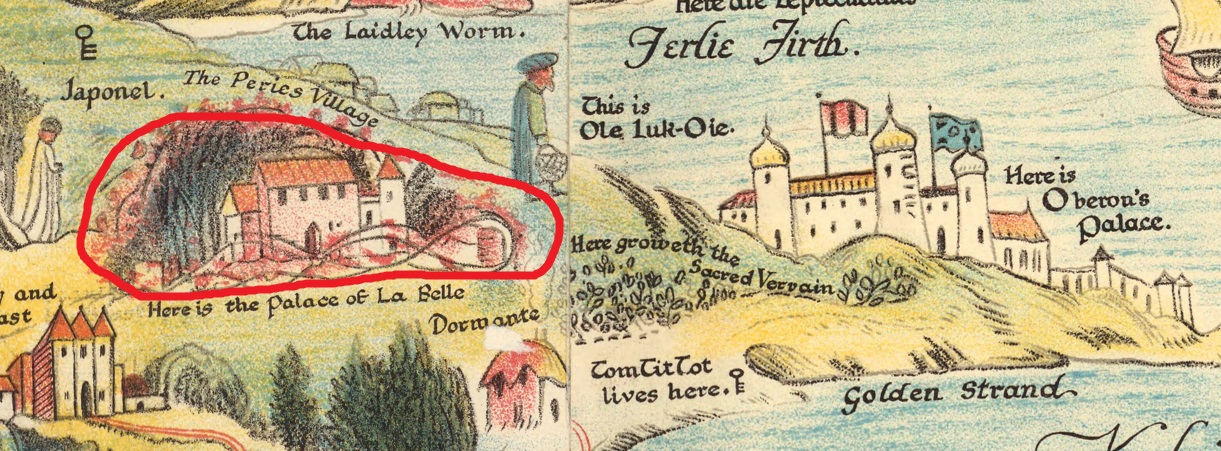
The "Rosa Mundi" (or Rota Mundi) is a term that occurs in the early manifestoes of the Fraternity of the Rose Cross or the Rosicrucian's. The original symbol of this was a Rose crucified upon a Cross.
ROTA = Wheel.
ATOR = Hathor Cow Goddess (the faerie queen in symbolic "cow" form).
TARO = another term for "Tanya" which means "Fairy Queen" - Slavic name for Tatiana, perhaps hence Shakespeare called the "Fairy Queen" by the name of "Titania"?
TORA = the first five books of the bible. Perhaps connected to the "five" skeins in TomTitTot, or the "five" magical beans in Jack and the Beanstalk, or the Fire, Air, Water, Earth, and Spirit, or the "five" vowels of speech, etc.
ARTO = Corn/Maize
ORAT = Speak/Say
ORTA = Rise/Ascend
ATRO = Fall/Descend
AORTA = HEART
All mysteries of which are clearly depicted in the "Wheel of Fortune" tarot card shown below:
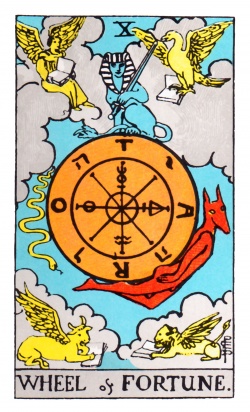
The Three Fates are Clotho (the spinner), Lachesis (allotter), and Atropos (the unturnable or inflexible one - often associated with death or cutting the cords).
The word "fairy" comes from Vulgar Latin "Fata" ("Goddesses of Fate") or Latin Fatum "Fate".
Upon the Faerie Emblem seen below (channeled through me and drawn by Keti Zasheva), the cities are color coded.

By tracing this particular order (SOUTH, EAST, WEST, NORTH = SEWN) upon a diamond, then you will receive the "Eihwaz" (ᛇ) rune which carries the hidden secrets of life and death and is related to the Yew Tree. It is connected with the Nine Worlds, the serpentine Kundalini, and the mysteries of the Edenic Gardens (with four rivers extending out from the heart center). By traveling from fIndias to gOrias to mUrias to fAlias you unlock the secret order of: IOUA (the first vowel in each city).
There is some belief that "IONA" was once mistaken by early scribes for "IOUA" when they mistook the "U" for an "n". Fiona Macleod wrote: "St. Adamnan, ninth abbot of Iona, writing at the end of the seventh century, invariably calls the island Ioua or the Iouan Island."
Fiona - who carries this sacred formula in her own magical name - wrote extensively on the sacred land of Iona and it was her name (and some other keys) which unlocked the hidden formulas for me to travel through the Four Cities of Faerieland (and the fifth central city).
This fifth city is concealed in the "F" of her name, if you were to view it as the Anglo-Saxon Rune "Ansuz" (ᚨ = also transliterated as Æ).
This is the Sacred Word - the Power of Speech and of Vowels.
Once you go from Fire, to Air, to Water, to Earth, and travel across the Heart of Faerieland through "Spirit/Akasha" before heading back to "Fire" - it produces the "Dagaz" rune (ᛞ) for "DAY". This appears like the transformative shape of a butterfly - and of an hourglass tilted in such a way that time itself has come to a stop (represented in Sleeping Beauty by stillness).
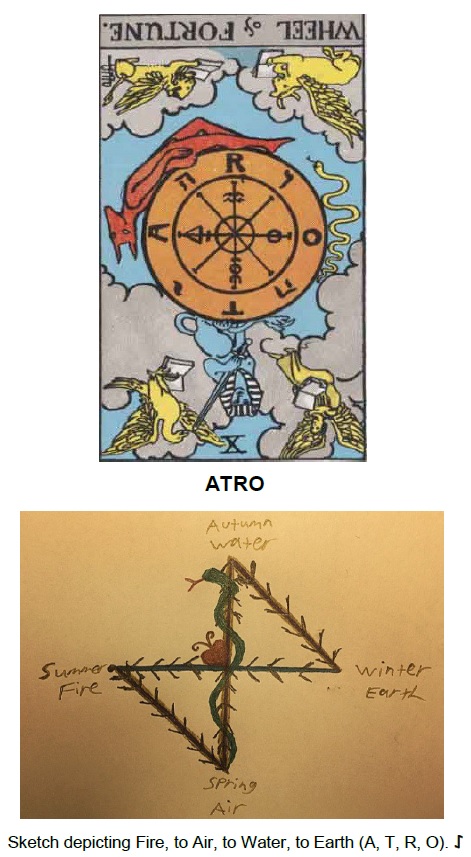
When Thomas the Rhymer lay with the Queen of Elfland she changed into haggard form - but later back into more beautiful and youthful form. The Triple Goddess teaches with purpose. Read my "Book of Earth - Vol. I" to comprehend the mysteries behind these transformations.
Fire, Air, Water, Earth spells "FAWE" which is "fain, glad, delighted, rejoice, or to make pretty". Perhaps it is related in some way to "Finis" for "finish" - when you return to the "Fire Realms" (or "Finias" at the end of the journey). It is quite a similar word to "FAME", "FATE" and "FAE".
Once you have descended from the Heavens to the Earth - you can also rise back up again, which is "ORTA" (the opposite of Atro, meaning "rise/raise, lift up") or through the "middle".
OTRA = "the other", "the second", "the other of two", "again", "repeat", "redo", and perhaps not unrelated to the concept of an "OUTRO".
There are many pathways one might take in these very bewildering lands with varied effects.
Sleigh explained that the early Spring is a great time to travel in the Faerie Worlds due to the land "shimmering with golden, thornless broom" and where the waterways are safer, with the "dangerous Western currents going to sleep and leaving the quiet seas as peaceful as a mountain tarn". So let us too pass by the path of thorns or the bewildering entrapping brambles while Sleeping Beauty remains asleep - as we travel the secret path to the Heart of the Labyrinth.
Did I mention that Bernard Sleigh quoted from "Ode to a Nightingale" by John Keats during the same Guide to the Map of Faerieland?
"Charmed magic casements, opening on the foam,
Of perilous seas, in faery lands forlorn..."
And that the context of this writing explains that Ruth "stood in tears amid the alien corn" listening to the song of the Nightingale. That the Nightingale is a Blackbird with secret song?
That the Night-in-Gale charms through the dark with strange voices on enchanting winds?
Do we remember how Christian is led off the "straight path" to the Faerie Castle, by chasing a "filthy raven" or black bird (instead of the path of the white dove) in the Chymical Wedding?
That "ARTO" is a Basque term for "corn" or for "MAIZE"? (of which Ruth stood in tears amid).
Aer yuo lsot yte? :P

After a short silence she added: "Every way that leads there is the right one.”
This explains that the girls real name was "Blanchette". I only found any of this to begin with because a strange fairy whispered in my ear this morning the words "Cape Blanchette" and the next story I intended to be studying today was no other than "Little Red Riding Hood".
The name "Blanchette" is derived from "Blanc" which is French for "White" and "Bright".
This re-telling of the story explains that "Little Golden-hood" had a hooded cloak which was "gold and fire colored" and which was "one of those magic caps that they used to have in former times for making oneself invisible or invulnerable".
The story itself offers very little extra information, but it is interesting considering what we have been discussing in relation to the colors "red" and "gold" - and why Bernard Sleigh also speaks of the "red and fine silken clue" but later appears to imply the thread as being golden.
The word "silk" is itself of interest here too, for it not only connects with the theme of "corn" and "maize" (corn silk), but is also informal British for a "King or Queen's Counsel". A King (or queen's) counsel is apparently a status which is granted by the crown and because members wear silk gowns of a certain design, the award is informally known as "taking silk".
The relevance of corn we have already partially gone into - but fairies have a very long history with the use of corn. In
In my "Book of Earth - Vol. I", it is speculated whether the term "Corn-on-the-Cob" might have originated as a double-meaning from the act of Kobolds or Cobolds leaving behind stacks of corn for humans as gifts to balance out what they had taken from them.
"This is interesting in relation to Cobolds because the Head of the Gnome Household (those who would be farming or stealing the corn away from the human farms) would often leave behind stacks of corn for farmers, that I speculate may be the origin of: “Corn-on-the-Cob”. Just as we have heard the term “these drinks are on the house” to refer to free gifts or offerings paid for “by the house”. Being respectful of us, they would leave behind stacks of corn when they took too much (“Their robberies notwithstanding, they ofttimes occasion great stacks of corn...” - Robert Kirk)." - The Book of Earth - Vol. I
Clearly we have one of many examples here of fairies stealing away corn - perhaps not just for the food, but for the "corn silk" - for they can be great weavers. It is said that the fairies of New Zealand (the Patupaiarehe) are who taught the early Maori the art of how to weave.
As far as the Minotaur at the Heart of the Labyrinth goes - this is perhaps a symbol of how we must overcome the Guardian of the Threshold of ourselves in order to truly comprehend the Knowledge of the Triple Goddess or the Faerie Queen. The Guardian of the Threshold is a monster that guards the way into higher realms (represented well in The Lord of the Rings by the Balrog who Gandalf the Gray must face (fire), before falling from the bridge (air), to the depths below (water) and then emerging from the mountains and caves (earth) as a reborn Gandalf the White.
We also see this guardian represented in the story of Jack and the Beanstalk.
In "Faerie Magic" I explain this: "What also becomes evident is that the giant Ogre himself is in
fact simply an independent reflection of Jack. All of his fears, his darkness, his shadows, his doubts, are hidden within the giant ogre. This is confirmed to us when the story later explains that the “OGRE fell down and broke his crown and the beanstalk came toppling after…” a line which is familiar to all those who know the story of Jack and Jill who went up a hill to fetch a pail of water and “JACK fell down and broke his crown and Jill came tumbling after.” The author is therefore hinting to us that the OGRE is JACK himself. This is further confirmed when the Ogre’s Wife in the story (who by default would therefore be “Jill”) comes out on Jack’s third visit to “fetch a pail of water” while he hides behind a bush. Thus the Ogre’s wife is Jill and the Ogre is Jack. Jack therefore has to face his own self in giant and darker form in order to gain the golden gifts of the higher worlds."
Those who have figured this out will understand that Jack and Jill are therefore married - because this is something not spoken of in the story itself (though Shakespeare alluded to it when he said "Jack shall have Jill, nought shall go ill") . Bernard Sleigh alludes to it on the map also where he writes: "Here Jack and Jill are Married". Right next to "Miss Muffett's House" which is perhaps a symbol of one who is running from their fears (the spider / "cob" web) instead of facing them as Jack did with the Ogre. Cobwebs guard ways to Kobold Dwellings.
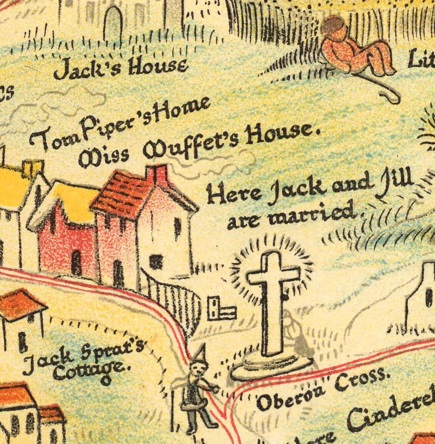
Oberon Cross is representative of the crossroad path which leads to Oberon's Palace - or the Castle of the Faerie Queen. A little further beyond this cross though is the "Banbury Cross".
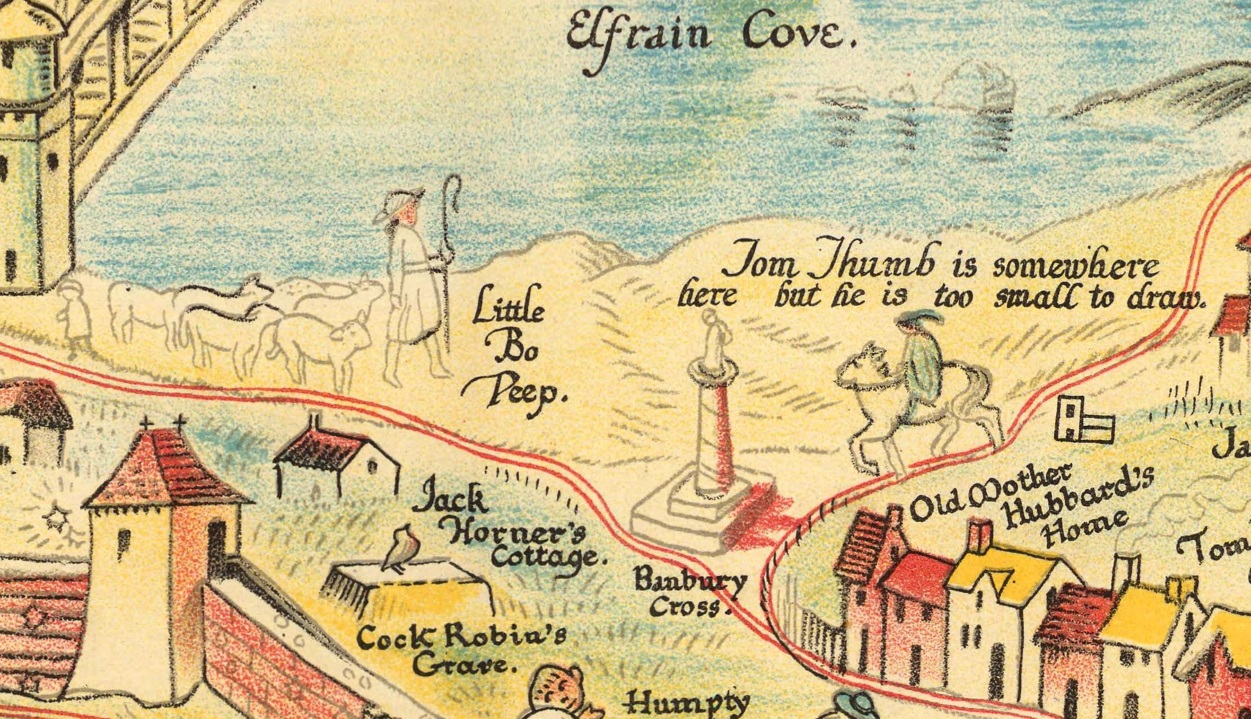
To see a fine lady upon a white horse,
Rings on her fingers and bells on her toes,
And she shall have music wherever she goes."
Compare this to the description of the "Queen of Elfland" who met Thomas the Rhymer and took him to Elfland.
"True Thomas lay o'er yonder bank,
And he beheld a lady gay,
A lady that was brisk and bold,
Came riding o'er the fernie brae.
Her skirt was of the grass-green silk,
Her mantle of the velvet fine;
At every lock of her horse's mane
Hung fifty silver bells and nine."
We also read of her "milk-white steed".
So here we have a fine lady upon a white horse, with sounds of bells and music around her and right next to "Tom" Thumb - perhaps as symbolical references to these Elfland events.
Of course "Tom Thumb" is in fact a very small creature the size of a thumb - but just as the story of Cinderella did not explicitly state "here is the white wand of Gorias" - but instead hid this information in the guise of the hazel wand and the white doves within the story, it seems that each tale has been woven into the map at very specific locations to represent something of even deeper knowledge. Thomas Rhymer thought he had been only a short while in the Land of Faerie - but had in fact been there for seven years, which is a common experience.
In this chapter we have taken many bewildering pathways - for entering into the Air Realms (especially these outskirt lands) is one of the most confusing and haphazard locations of the Faerie Worlds. Thus like "Little Bo-Peep" we may find ourselves searching in many directions, to place imaginary tails upon the animals we were never actually looking for in the first place. But somewhere along the way, we may pick up the long lost and enchanting thread, until we will discover the central and true message within. This shall be our Land of Heart's Desire.
"Golden sun upon the rolling pomegranate hills,
Rosy-Red, the Secret Fire glows within us still,
Winds of Summer warm the dormant faculties of man,
Visions pour into my soul of long forgotten lands.
Woven opalescent threads, translucent imagery,
Deep in the water, deep in the fire, in sacred harmony,
Dreams of wondrous life surround, ancestral spirits all around,
In the arms of the goddess we belong, for her we sing this song..."
The Lost Enchanters, Jeremy Garner
Note: when I was earlier given the words "Cape Blanchette" upon waking, I was then led to the story in Andrew Lang's Red Book collection about "Little-Red-Riding Hood" being called "Little Goldenhood" and carrying the name "Blanchette" (for that story) - which further led to the discoveries in Bernard Sleigh's "Guide to the Map of Fairyland" which peculiarly writes of "gold" and "red" together multiple times:
The word "cape" was presumably used to draw my attention to her "hood" which I was not yet aware of being referred to in the original fairy tale as a "red-cap". But also this name was perhaps used to draw my attention to "Cate Blanchett" - who is most famous for her role as Galadriel in The Lord of the Rings movies. Galadriel is particularly known for her golden hair - and being dressed in white. The name "Galadriel" itself means "Maiden crowned with gleaming hair or bright radiance" for this reason. It was said that lights from the two trees (silver and gold trees of Valinor which brought light) were captured in her hair. She gifts three strands of her golden hair to Gimli the Dwarf. Galadriel's grandmother was called "Indis" who also had a daughter called "Findis" (both of which remind us of the radiant light of "Findias").
In "Little Golden-Hood" we read:
"Blanchette promised over and over again that she would never more stop to listen to a Wolf - and Blanchette, the little Golden-Hood kept her word. And in fine weather, she may still be seen in the fields with her pretty little hood, the color of the sun. But to see her you must rise early."
When the wolf catches the fire-colored hood in his mouth - he is burned by its red hot coals.
In "The Book of Hermes - Vol. I", I describe how Hermes in the form of "Maui" of New Zealand (and Hawaii), trapped the sun and forced it to travel more slowly and regularly - when before it had been haphazardly moving in the sky which was inconvenient to humans. This is similar to what he did in the form of "Thoth" when he won 1/72nd of the moons light, and extended the 360 day year by five days.
It is also interesting to note that when there is a "sun-shower" - many cultures around this world refer to it in terms of wolves or devils such as a "wolf's wedding" or a "wolf giving birth" - or the "devil's marriage" etc. The same "Book of Hermes" goes into extensive wolf/werewolf connections with Hermes/Lucifer.
Maui braved the great heat of the sun (just as the wolf in the Goldenhood story has to get burned in the process), and eventually captured the sun and commanded it to slow down. Then it took the straight path across the sky - as does Little Golden-Hood - who is seen with her pretty little hood on in fine weather (if you rise early enough to see her sun-colored cap).
"The Elysian fields have a sun and stars of its own."
As another note regarding this topic: the word "moon" was a masculine noun in Old English (hence the "man in the moon"), while the Old English word "sunne" for "sun" was feminine, and the feminine pronoun was used in English until the 16th century...
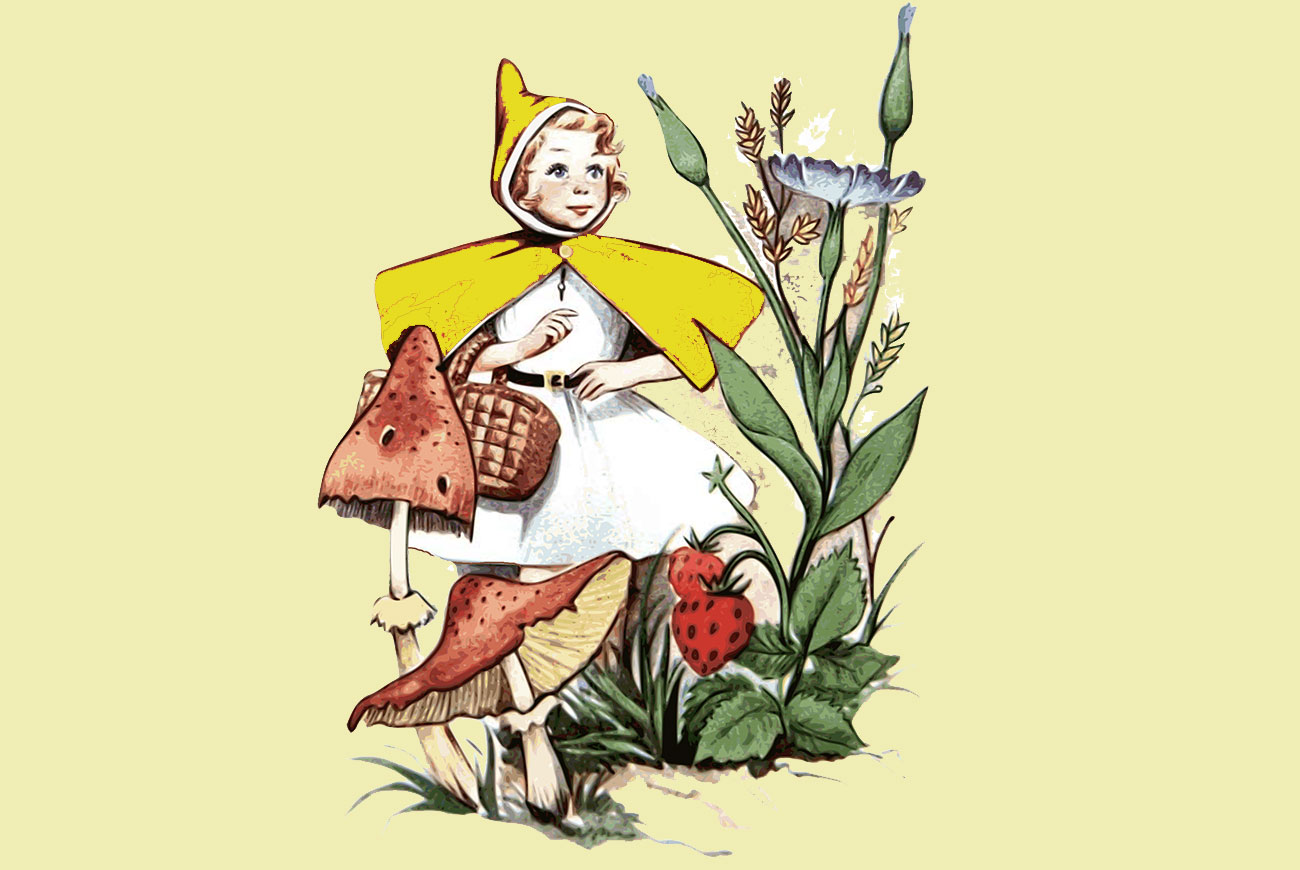
So why is Little Red Riding Hood depicted at the very entrance to the Eastern Air World of Faerieland/Elfland, instead of in the Fire Realms? Perhaps because the sun rises in the east and Little Red-Cap is a personification of the sun herself? This is why she is seen right at the bridge/doorway into the Eastern Lands (where she rises from).

Certainly, we can trace back these fairy tale origins to more ancient forms; many of them which tie in to New Zealand, and are especially found in the Polynesian Legends of Maui and the Sun.
Maui who is considered a trickster (famous for his exploits and cleverness/craftiness), was also said to have brought fire to the world (teaching humanity how to use it), which are all very clear similarities with Hermes who did the same things. He delights in bringing joy and knowledge to humans and in helping us.
In "Legends of Maui, a Demi-God of Polynesia", by Westervelt, it is clear that the author also noticed the clear parallels between Maui and Hermes/Mercury when he wrote: "Maui was the Polynesian Mercury. As a little fellow he was endowed with peculiar powers, permitting him to become invisible or to change his human form into that of an animal. He was ready to take anything from any one by craft or force. Nevertheless, like the thefts of Mercury, his pranks usually benefited mankind."
My "Book of Hermes - Vol. I" explains many of the connections between Maui, Hermes, Wolves, and Lucifer - though there would be far too much to try and summarize all of that right here.
Hermes (who is known on Bernard Sleigh's map as "Fridolene") is the Guide to Faerieland and it is him who is said to have regulated the pathways of the sun which was before haphazard.
In the story of Maui Snaring the Sun - shared in Chapter Four of Westervelt's book, we read:
The Snaring of the Sun book continues:
Legends of Maui:
"“What a big nose you have!”
“The better with which to smell,” her grandmother said. - Red Riding Hood
"But, grandmother, what a terrible large mouth you have got!"
"The better to devour you!" And no sooner had the wolf said it than he made one bound from the bed, and swallowed up poor Little Red-cap."
Legends of Maui:
Book #12.
Book #13. The Secret Commonwealth of Elves, Fauns, and Fairies, by Robert Kirk.
It is first necessary to understand the following, as written in Robert Kirk's book from 1691 "The Secret Commonwealth of Elves, Fauns, and Fairies" which says:
"They are distributed in Tribes and Orders, and have Children, Nurses, Marriages, Deaths, and Burials, in appearance, even as we, (unless they so do for a Mock-show, or to prognosticate some such Things among us)."
This is a very interesting possibility, as Kirk is suggesting here that some of the fairy people might even pretend to marry, go through entire burials, and so forth - simply as a fun game to imitate or mock what humans do - in a humorous and fun way (something which perhaps could be understood by sensing the prevalent energy in "Alice's Adventures in Wonderland").
If this were to happen, it would most likely take place in the Air Realms which is really the "Land of Eternal Youth" - and where Spring and Life and Joy is absolutely manifest there. Therefore just as we might create dramas around these things in the midst of our own lives - it may be that the fairies do this for entertainment also.
The other possibility he suggests is that they may be doing it to predict or even create fateful events or destinies for us here - just as how things will often first appear in the mind/dreams before later manifesting into tangible and physical realities.
During the writing of my "Book of Earth - Vol. I", there was an interaction I had in vision with a gnome in the "Earth Realm" - who did really appear to die, and I asked him "so you can die?" before this occurred. He told me "all passes away into change, but all is reborn". He then to all appearances seemed to die and I watched as his body became more see-through, before fading in the wind completely - leaving a brief image of skeleton and bones which soon went away into dust also. This all took place in a very rapid manner compared to human bodies.
In this case, it did not appear to be for a mock show or comedic reasons - and he also had blood dripping from his mouth onto his beard too. The difference here is that gnomes are much closer to the Physical/Earth Realm - and all of this took place in the Earth division, being associated with Winter, Transformation, Night, and Death. It would be far more likely then perhaps to see this type of thing in that environment amongst certain types of beings - whereas in the Air Realms which are filled with the renewal and happiness of paradisaical life - many of these things are more likely to be performed for fun, play, laughter, or merriment.

First they are married - in a similar type of "mock performance" type of energy:
"The Cock then blew his horn,
To let the neighbors know,
This was Robin's wedding-day,
And they might see the show."
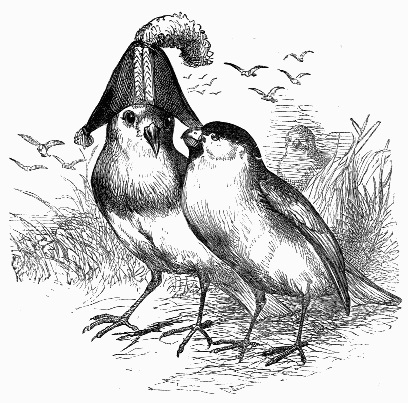
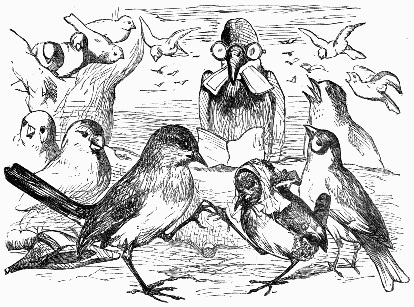
It is possible that their actual mock-show and fun led to real emotions and events/deaths (indicating the "prognostication" that Kirk touched upon"), with perhaps the Cuckoo (like the "cuckoo-clock") being a symbol for "time" - though this is not quite as likely given the context.
More than likely this could have all been part of the mock-show and game - similar to what we call a "Mummers' Play" where amateur actors known as "mummers" will play different characters - two of who will eventually end in combat with one another, with one of them "dying". A doctor-like character then appears and revives or brings the dead back to life.
Considering that the Marriage of Cock Robin is followed by a very similar play/theater style - perhaps indicates that the entire event was part of their games in the Land of Eternal Youth.
"Who'll be the parson?
I, said the Rook,
With my little book
I'll be the parson.
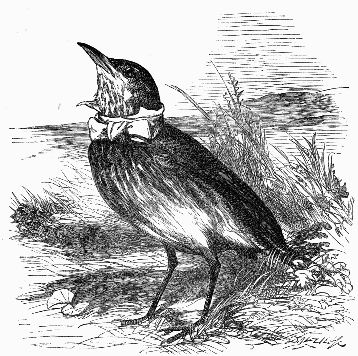
Who'll sing a psalm?
I, said the Thrush,
As she sat in a bush,
I'll sing a psalm.
Who'll toll the bell?
I, said the Bull,
Because I can pull;
So, Cock Robin, farewell!
All the birds of the air
Fell a-sighing and sobbing,
When they heard the bell toll
For Poor Cock Robin.
There have been some theories proposed that there is a relation to the Celtic God "Lugh" (who I connect with Hermes/Lucifer), and who is connected with the bright/red/sun/light.
In Welsh the term "coch" means "red", "rhi" means "lord", and "ben" means "head/leader" - which would be "lord" or "leader" of the "red/sun".
There is a "Welsh" Thief mentioned on the Map of Faerieland by the name of "Taffy". There are some theories that this was a merging of the common Welsh name "Dafydd" and the Welsh river "Taff". In "The Book of Hermes - Vol. I", I go into great detail about the connection between Lucifer and "David" and how the line "I am the root and the descendant of David, the bright morning star" in the Bible - is more likely to refer to David than to Jesus as many have previously thought. David like Hermes was very fair and beautiful, played the lyre/harp, and defeated a great giant (like Hermes beheaded Panoptes). The other who slayed a giant in a similar manner was none other than "Lugh" (mentioned above), who was also a master harpist. The "Coat of Arms of Ireland" is based on a medieval coat of arms once attributed to David. The Gaulish equivalent of Lugh is Lugus (also associated to Mercury and thus Lucifer), is depicted as having three heads. The Irish Emblem often has three crowns or three harps - and Lucifer is often depicted with three heads (such as in Dante's Inferno), or often known as "Thrice-Greatest Hermes", etc.
Hermes/Maui, etc are well known for their roles of being "thieves" - and interestingly the two houses closest and to the east of Red Riding Hood's house on the map - both depict thieves.
If my previous theories about Maui/Hermes/Mercury/Lucifer being represented by the wolf in "Little Red Riding Hood" (with her being the "sun") are correct - then he would indeed be the "ruler/lord/leader" of the "red/golden sun" - as it is Maui who controlled and dominated the sun to do his will in the sky - thus providing more "time" throughout the day, and so on. Therefore this "mock show" taking place in the Air Realms - carries also a deeper message.
Keeping in mind the "enchanted jawbone, by which great enchantments can be wrought" that Maui wished to steal from the old woman - the story of "Taffy was a Welshman" is this:
"Taffy was a Welshman,
Taffy was a thief,
Taffy came to my house
And stole a leg of beef.
I went to Taffy's House,
Taffy was not at home,
Taffy came to my house,
And stole a marrow-bone."
Taffy is depicted right next to the house of "Little Red Riding Hood" as seen here below:
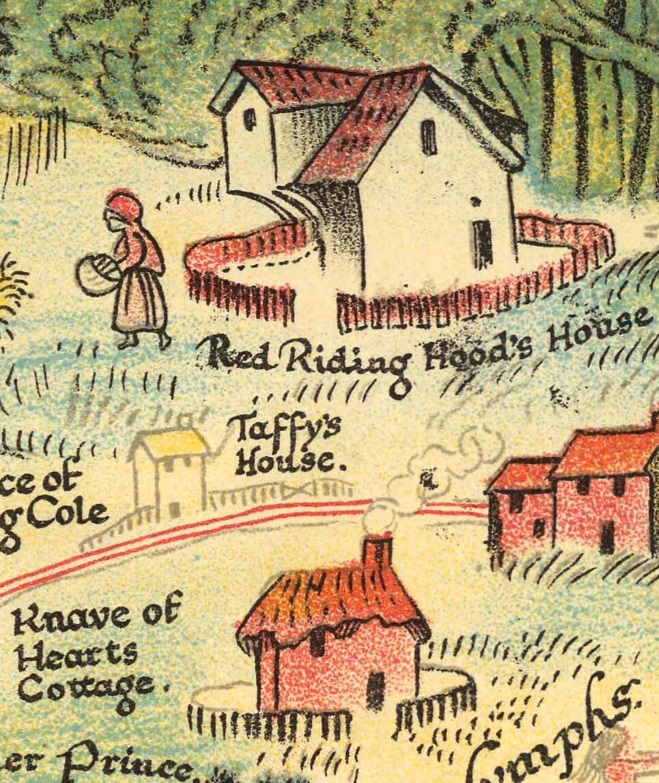
"The Queen of Hearts
She made some tarts
All on a summer's day;
The Knave of Hearts
He stole those tarts,
And took them clean away."
In both the cases of the Knave of Hearts, and of Taffy the Welshman - the thieves are also reprimanded and beaten for their actions.
There are great mysteries on the compass of Sleigh's "Map of Faerieland" shown here:
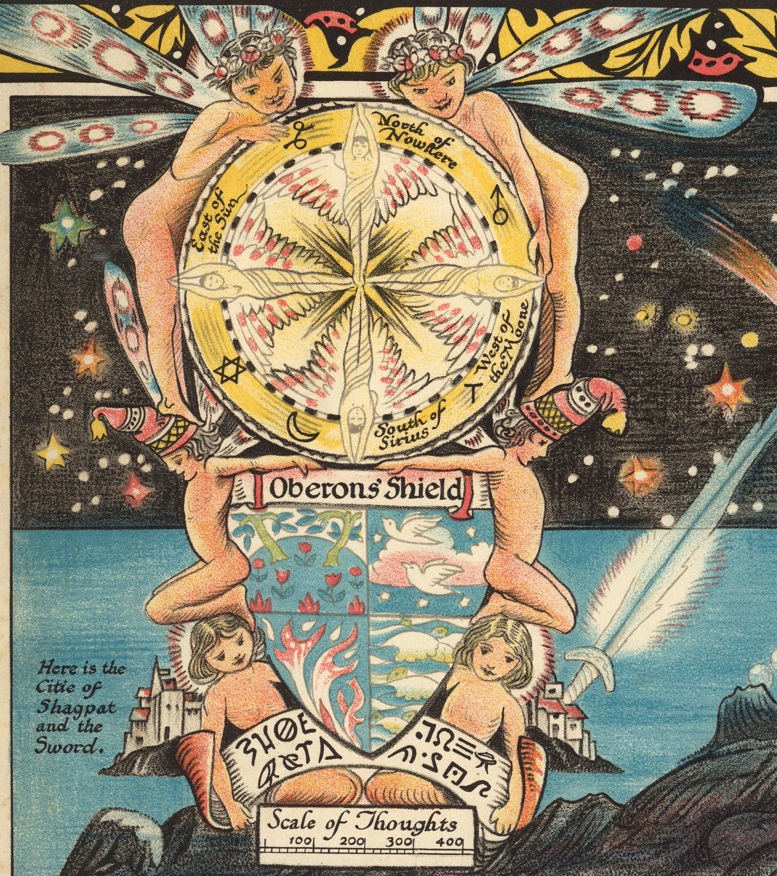
"East of the Sun", "South of Sirius", "West of the Moone", and "North of Nowhere".
It appears from my own adventures in Faerieland that this compass needs to be turned 1/4 in an anti-clockwise direction, if it is to match up to all of the locations depicted on the map.
The way that the two beings either side of it are drawn at the top also appear to be about to turn the wheel in that direction - not to mention the left pointing Venus-like symbol pointing this way too (which surely has more than one meaning).
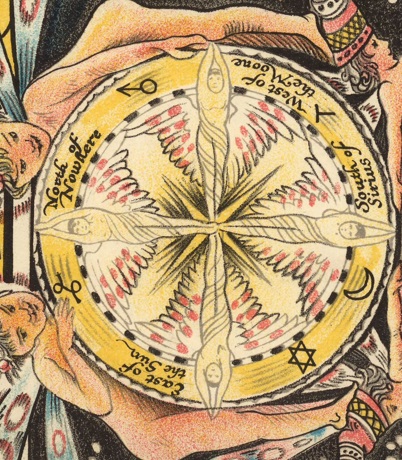
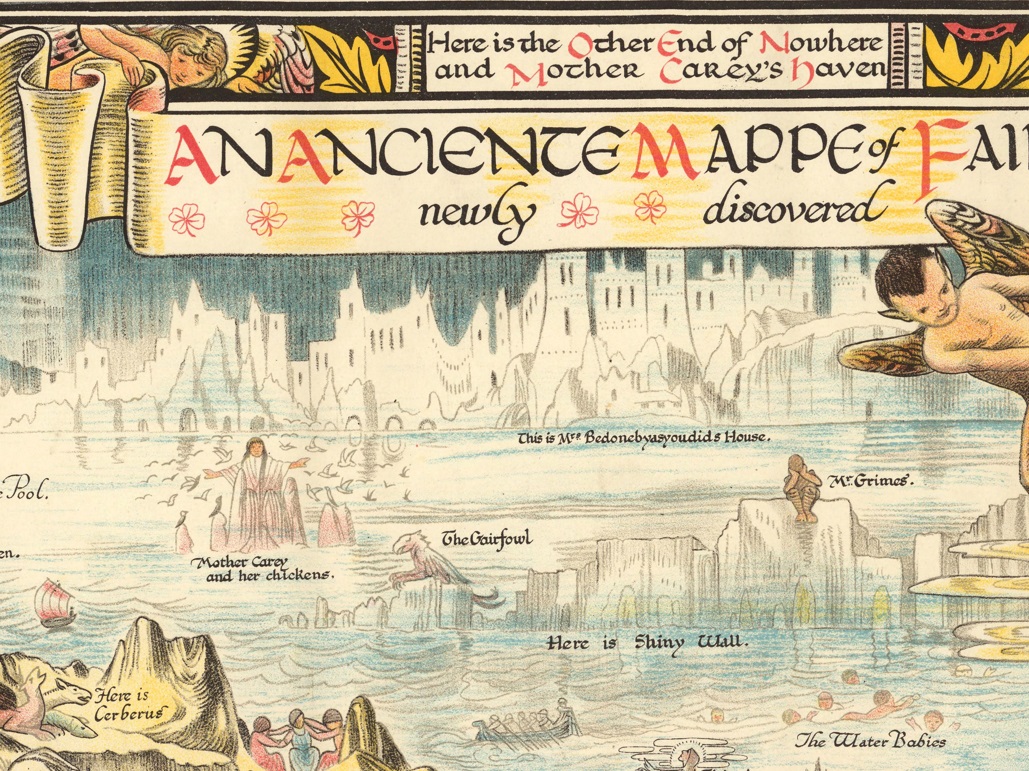
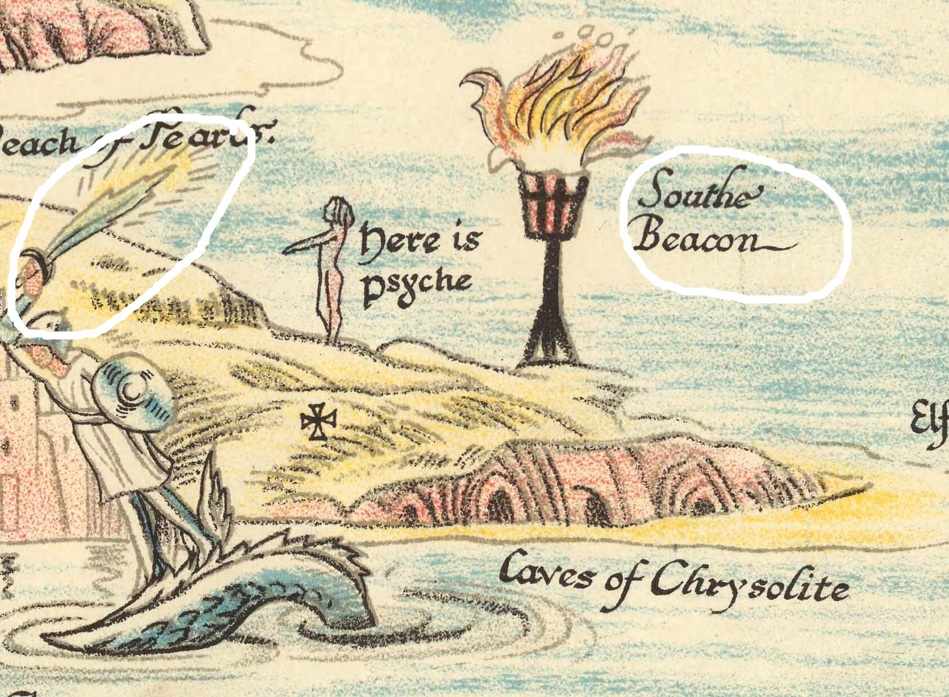


See the next three images to see each of them on their own and followed by them merged...
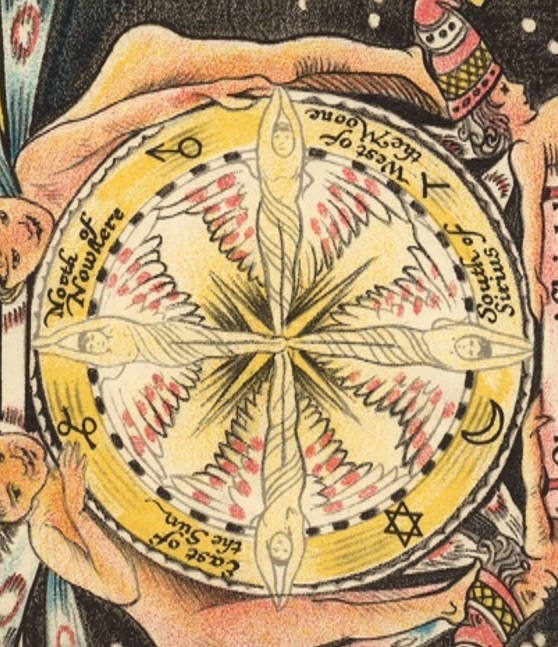
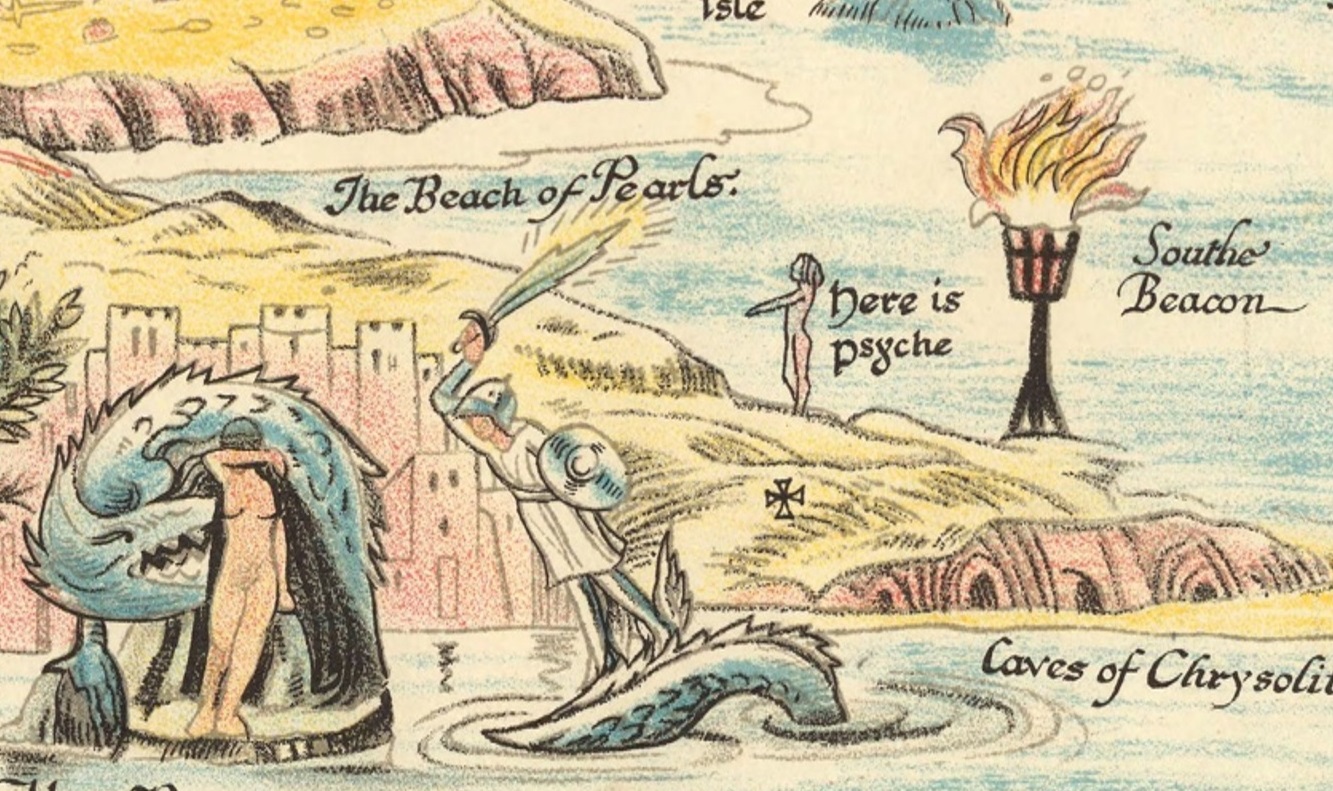
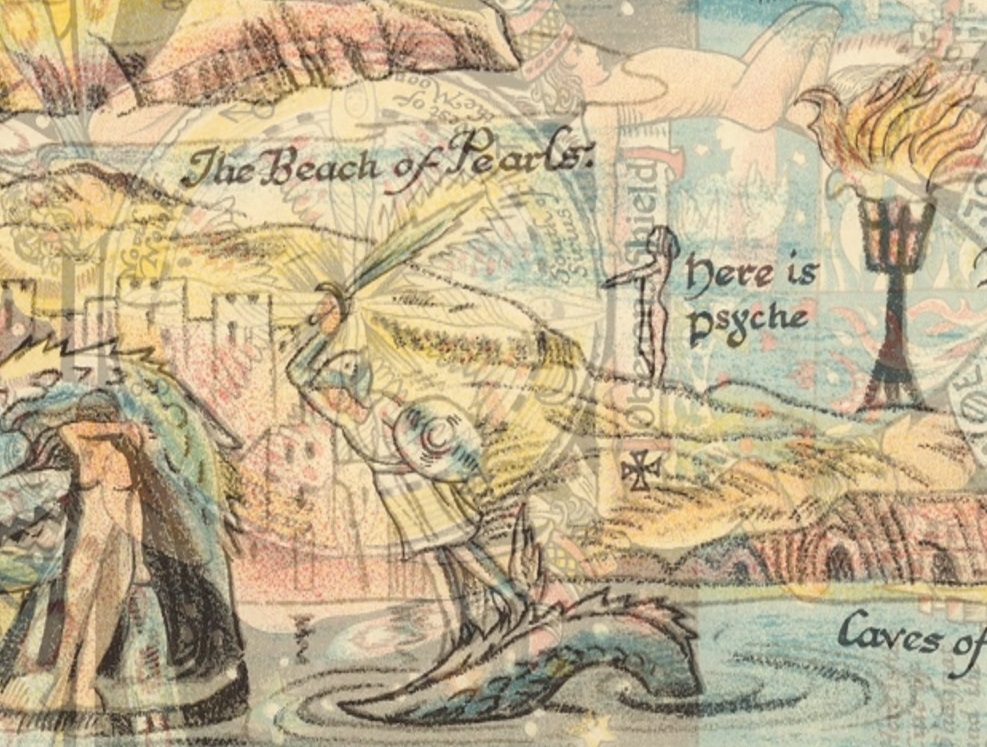
For example, in "The Blue Bird" by Maurice Maeterlinck (which is referenced on Sleigh's map near the "Imp Tree"), there are the following words:
"THE FAIRY:You turn the diamond a little; fromright to left, for instance, like this; do you see?... Then it presses a bump which nobody knows of and which opens your eyes. . . .
TYLTYL: Doesn't it hurt? . . .
THE FAIRY: On the contrary, it's enchanted. . . . You at once see even the inside of things:
the soul of bread, of wine, of pepper, for instance. When you hold it like this, do you see ?
. . . One little turn more and you behold the past. . . . Another little turn and you behold the future. . . . It's curious and practical and it's quite noiseless. . . "

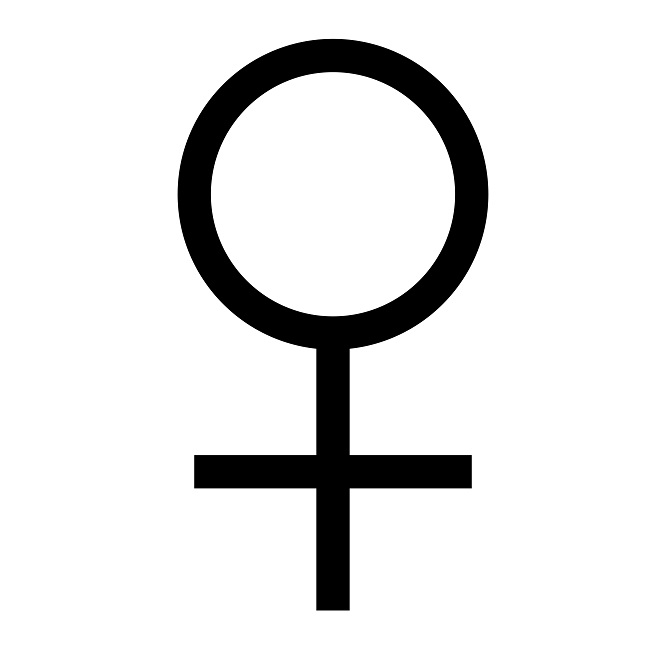
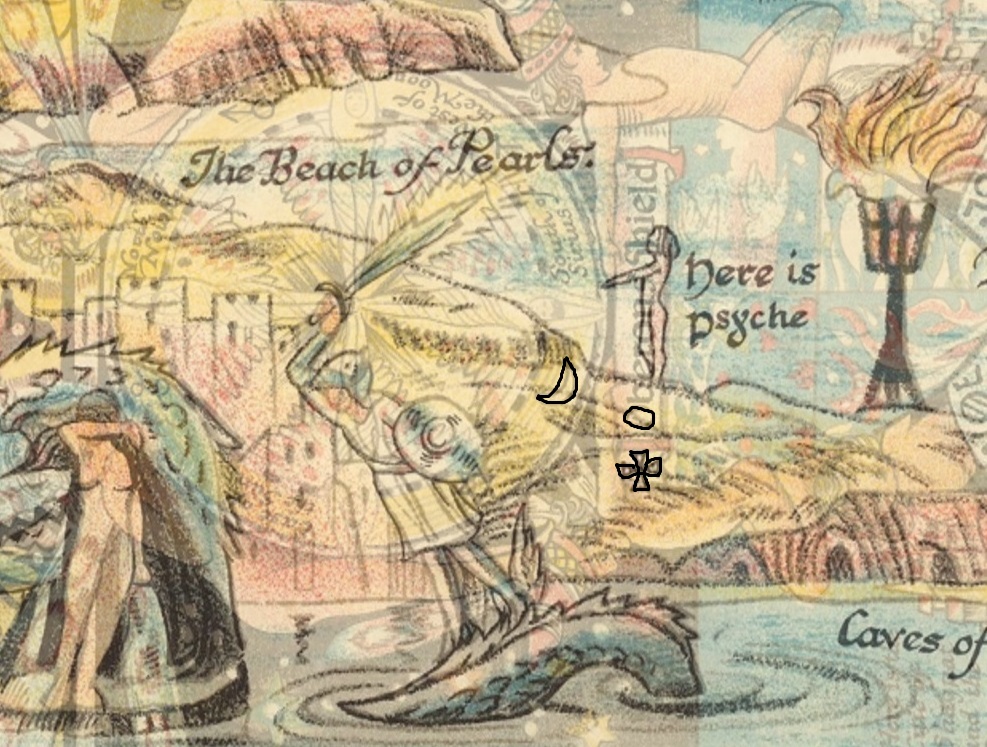
This brings to mind another biblical quote which is "Do not cast your pearls before the swine, lest they trample them underfoot."
We also see that the "Beach of Pearls" is within close vicinity of this scene. Not to mention, "Circe's Isle" being situated right next to that:
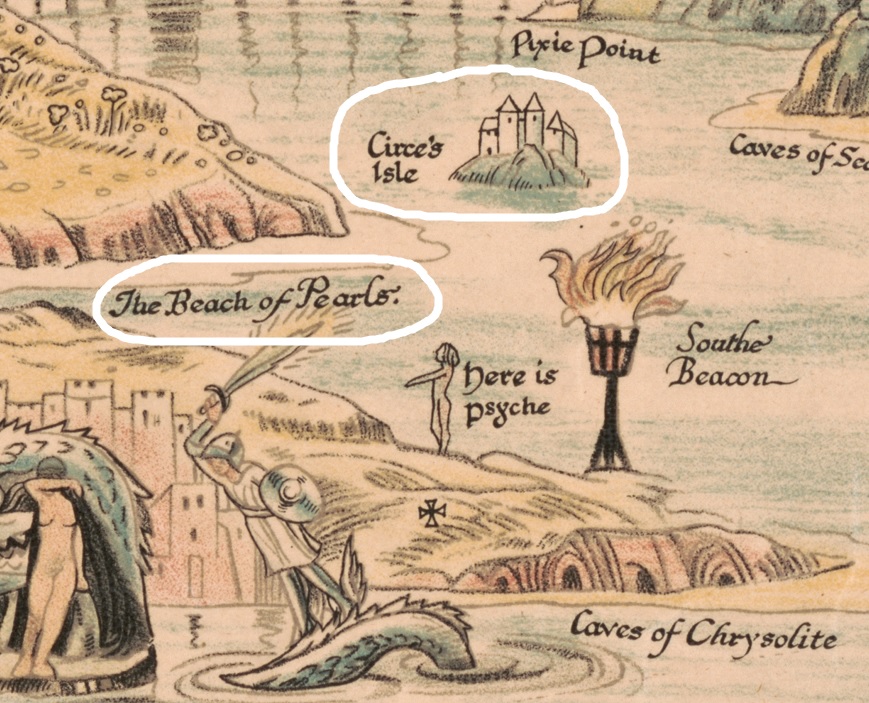
It is Mercury/Hermes/Lucifer who carried Psyche to reunite with her lover Cupid or "Amor":
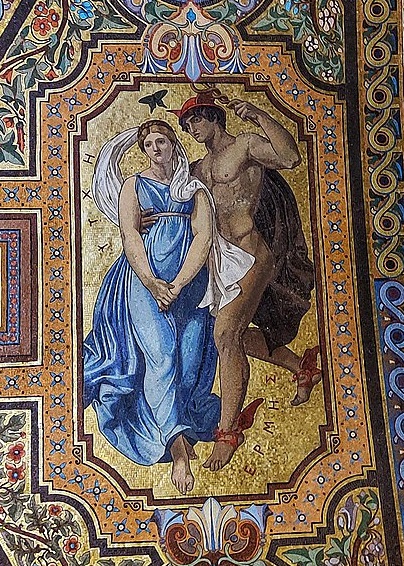
Their names are shown in Greek letters, Psyche's at the top left (ΨΥΧΗ = Psyche), and the name of Hermes at the bottom right (ΕΡΜΗΣ = Hermes).
As mentioned in the "Fire Realms" section, the South Beacon is a hidden entrance into the Faerie Worlds (near to the Beach of Pearls). This is perhaps the "Pearly Gate" referenced in Sleigh's Guide to the Map of Faerieland which says that the map is "dedicated to all children old and young who are seeking passage through the hidden Gates of Ivory & Pearl."
In "The Odyssey" there is a reference to the "Gates of Horn and Ivory". The book mentions that there are "two gates of shadowy dreams", with one being "fashioned of horn" and the other of "ivory". It is explained that "those dreams that pass through the gate of sawn ivory deceive men, bringing words that find no fulfilment. But those that came forth through the gate of polished horn bring true issues to pass, when any mortal sees them..."
Penelope adds that "in any case, it was not from thence, methinks, that my strange dream came" - indicating a third gateway. This would be the hidden Gates of Pearl - which is the secret entryway into the Fire Land in the South (next to the figure of Psyche) which eventually can lead one into the faerie worlds (or the Air Realm), if they are rightly guided by Hermes.
The main gate depicted into the Air World is depicted on the map as the "Gate of Ivory" - which is said to bring lies and deluding deceptions (which can occur around the pixies).
There is a deeper reason for this great gate being described as the "Gate of Ivory" though - and it is the same reason I had to write in my "Book of Fire - Vol. I" that "Hermes shares some things with me here which I am not able to write in this book, but he takes me through secret pathways until we are standing on the other side of the gate, inside the Air World. He teaches me here of the importance of the infinity symbol and connects it to the Two of Pentacles Tarot Card."
Sleigh wrote a book entitled "The Gates of Horn".
Arthur T. Murray wrote: "The play upon the words κέρας, "horn", and κραίνω, "fulfill", and upon ἐλέφας, "ivory", and ἐλεφαίρομαι, "deceive", cannot be preserved in English."
A rosebank version of the map, may help to shed light on this matter, but that is all I can say.
When the wheel is turned a 1/4 direction anti-clockwise then Perseus is aiming his sword at the "North" direction which is associated with death/winter. Before the wheel is turned he would have been attacking the eastern direction which is Spring/Life and would not match.
This way, the words "East of the Sun" are also more accurately depicted on the compass:

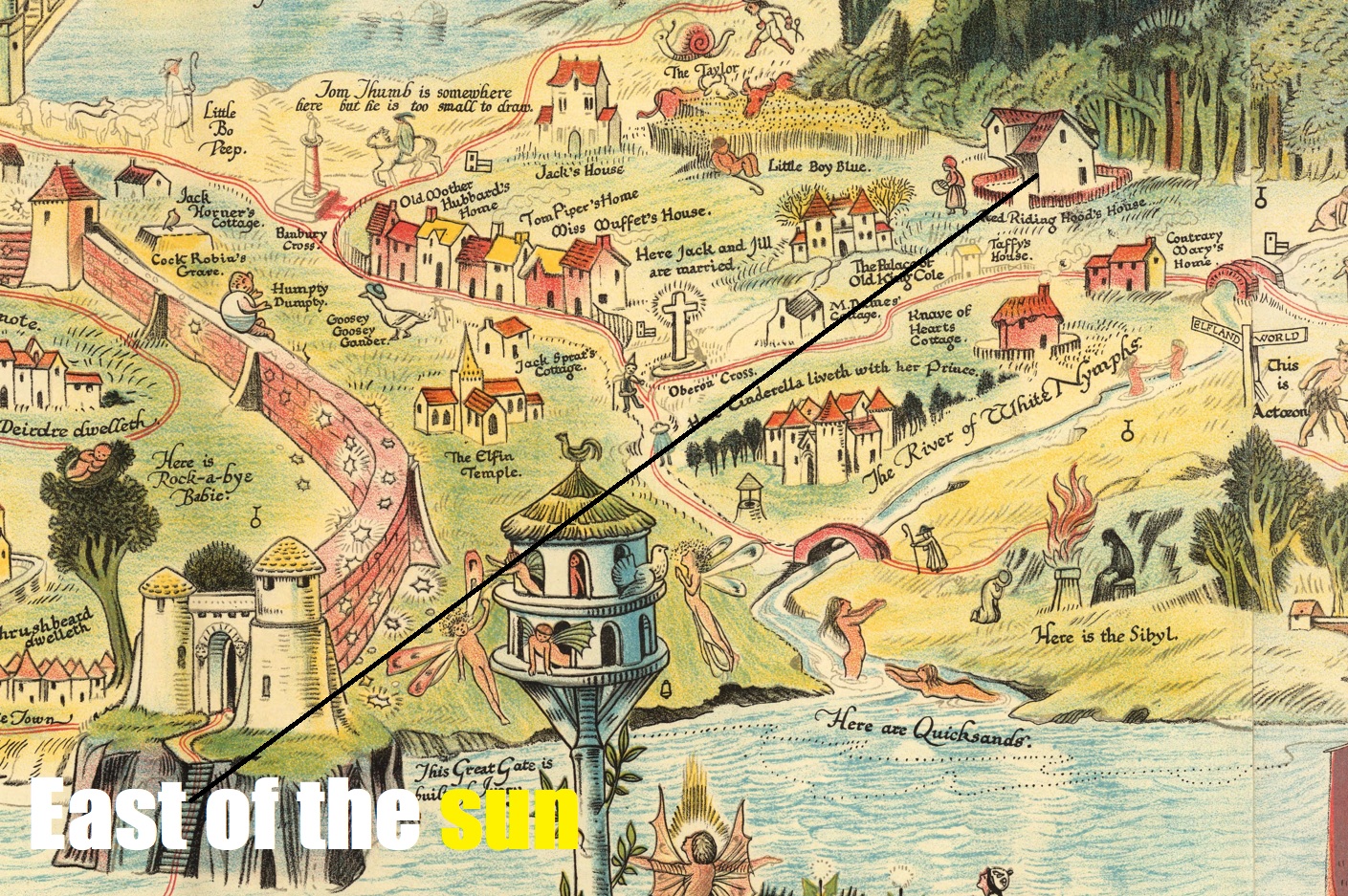
I have earlier already explained how Taffy the "Welshman" is likely connected with "Dafydd" or "David" - which seems further confirmed by the "Star of David" being drawn in that overall direction upon turning the compass 1/4 anti-clockwise.
Another term for the "Star of David", is interestingly the "Shield of David". In the following image, I have turned the compass 1/4 anti-clockwise (based on my own faerie adventures), and the "Star/Shield of David" consequently then appears right above the word "SHIELD".
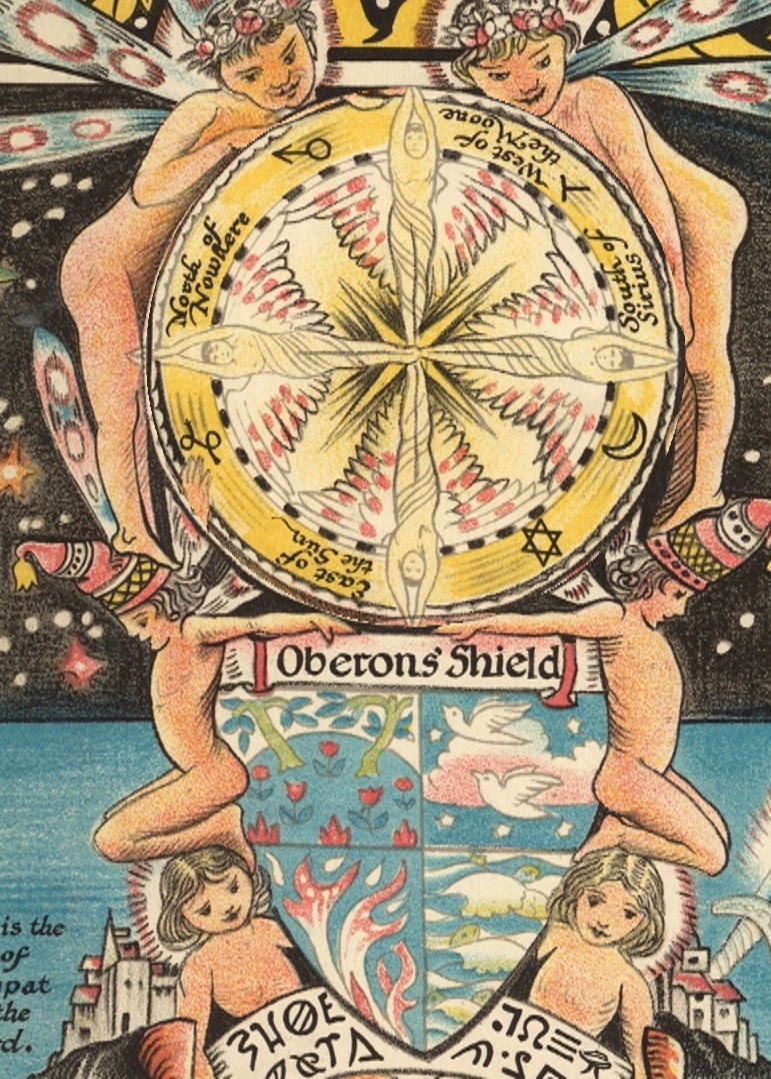
But how can we confirm this?
Oberon's Shield is clearly split into four categories associated with the four elemental worlds.
The top left is "Earth" with its growing trees and fruit.
The top right is "Air" with its white birds in the clouds.
The bottom left is "Fire" with its flames.
The bottom right is "Water" with its swimming turtles.
I maintain that the secret order to travel into the faerie worlds is hidden in the name of "Fiona" when applied to the four cities of fInias, gOrias, mUrias, and fAlias (IOUA/IONA).
This takes us from South to East to West to North (SEWN).
This is why I have written my Books of Fire, Air, Water, and Earth in that precise order - and why this map has also confirmed the very same structure and order from the right to the left (stealing the Fire of Heaven and bringing it down to Earth).
If we trace this secret formula upon Oberon's Shield (from Fire, to Air, to Water, to Earth), then we receive the following symbol:

During my 40 Day Journey to the Faerie Worlds, I was given some instructions to construct a particular talisman connected with Matariki and the Pleiades constellation - which was also purported to "raise winds" and "summon spirits of uncanny knowledge to the wearer".
Upon the first wearing of this talisman (which was created by a metal caster friend under specific instructions and constellations, who reached out to meduring the authorship of my "Book of Fire"), there were indeed some of the biggest wind storms in my home country that I have ever personally experienced - which continued for several days.
Not to mention, I certainly got in touch with those spirits of uncanny knowledge...
But the fairies had given me very specific instructions on the creation of this talisman, and guided me to the works of "Agrippa" to learn more about the symbols associated with it:
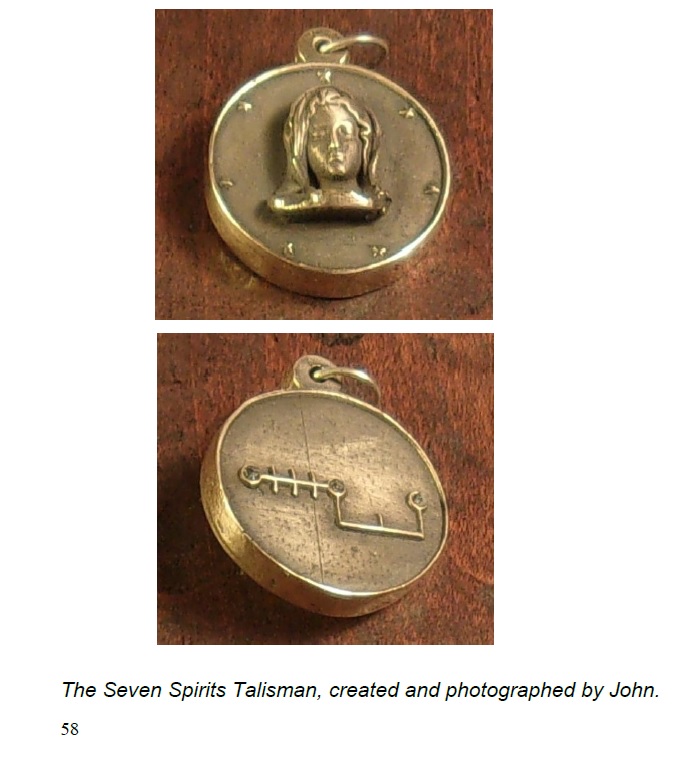
“Under the constellation of Pleiades, they made the image of a little Virgin, or the Figure of a Lamp; it's reported to increase the light of the eyes, to assemble Spirits, to raise Winds, and to reveal secret and hidden things.”
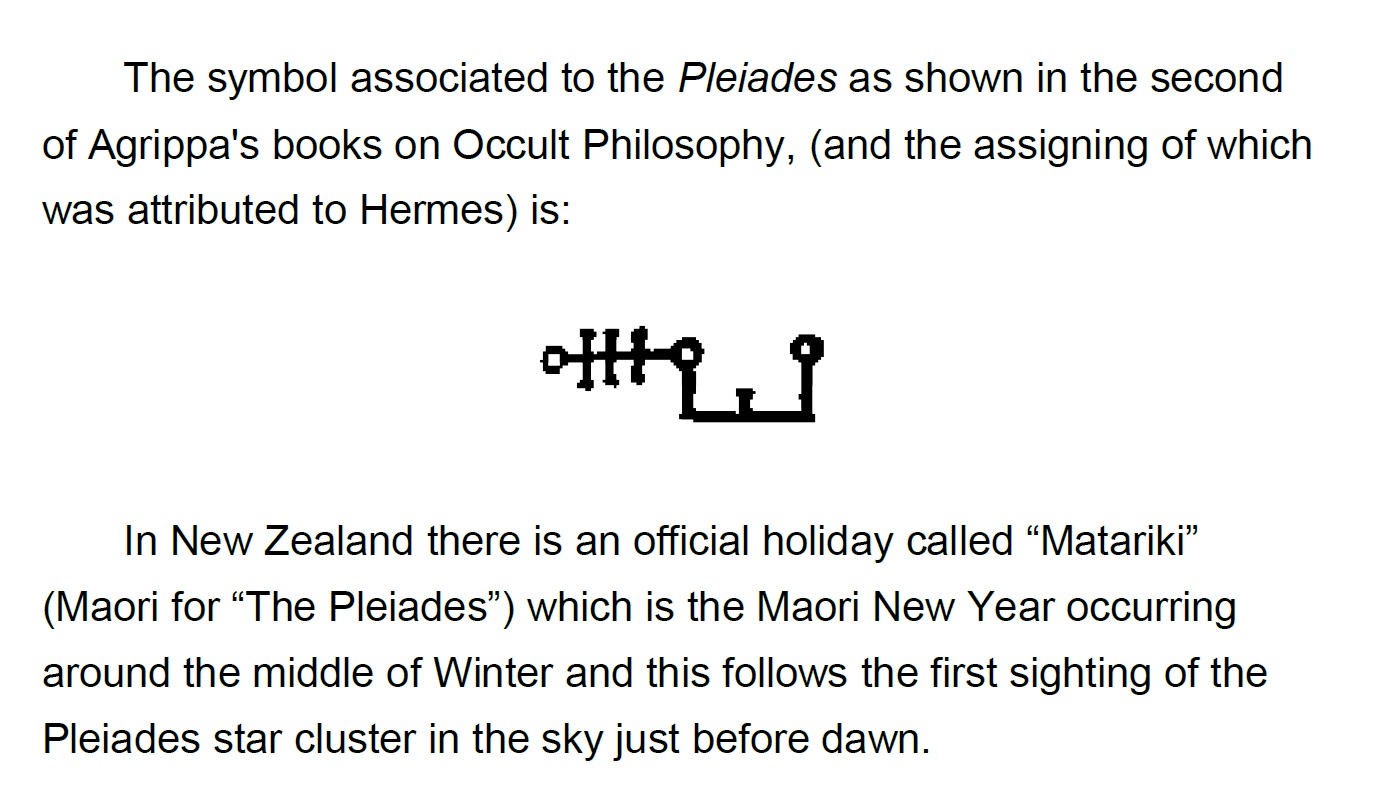
Certainly this is of great interest considering all we have shared on the brightest star, wolves, the "coch/red" leader, and so forth - but indeed of the most interest here is the symbol given:
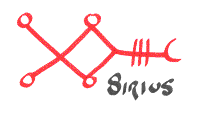
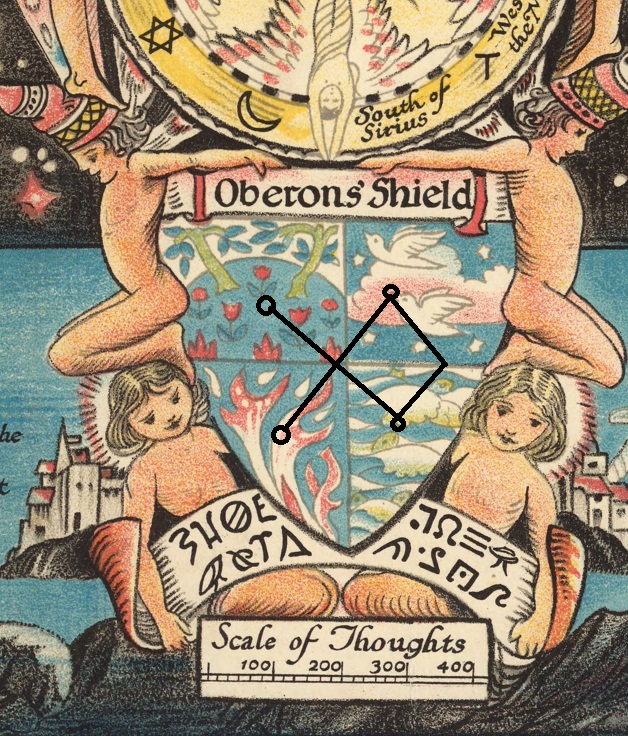
The animal it rules over is the tongue of a snake.
The lesser Dog-Star rules over Agates for stones and Marigold and Pennyroyal for the plants.
Keeping in mind that the compass itself is supposed to be tilted anti-clockwise by a quarter - it would make sense to do the same with the Symbol of Sirius, which results in the following:
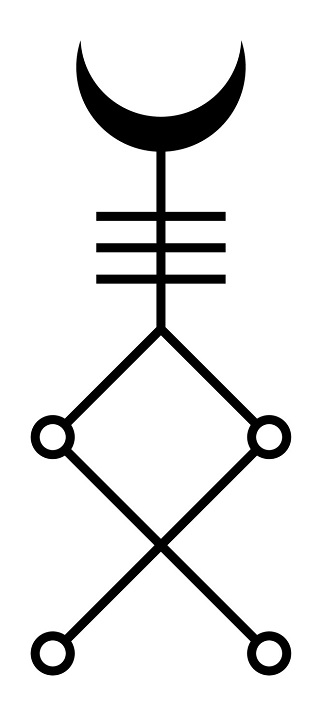
Beneath this then is a specific Nordic Rune (something which Hermes taught me to create when I was writing my "Book of Fire - Vol. I", and recommended that I learn), and that rune is: OTHALA: ᛟ
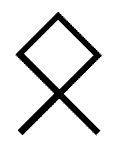
"Dreams of wondrous life surround,
Ancestral spirits all around
In the arms of the Goddess we belong,
For her we sing this song..."
- The Lost Enchanters
Of course one may also form and complete the Dagaz / Butterfly rune into this symbol also, as is symbolically seen with "Psyche" and which I have drawn on my own faerie channelings. When the hour glass is seen this way, then time has perhaps stopped, as you enter eternity.
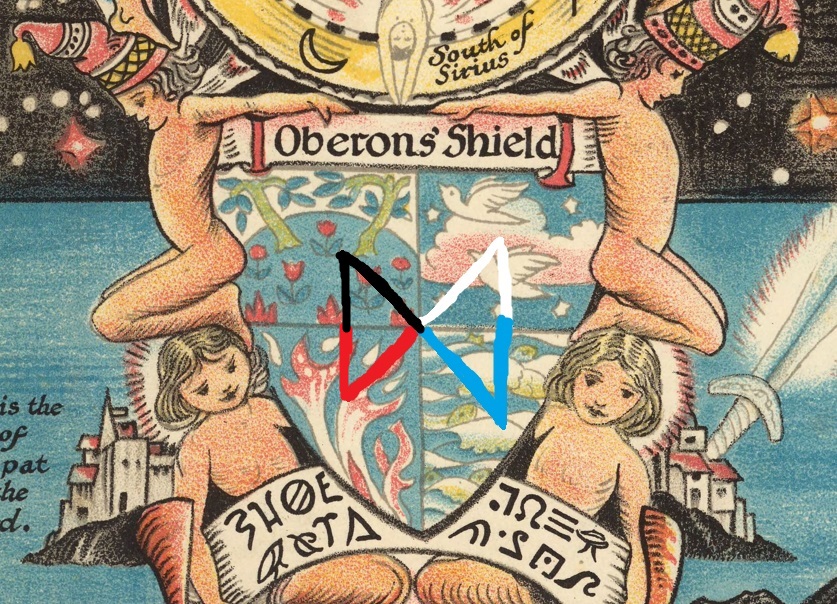
And a Heaven in a Wild Flower
Hold Infinity in the palm of your hand
And Eternity in an hour
A Robin Red breast in a Cage
Puts all Heaven in a Rage..." - William Blake, Auguries of Innocence
Blake's "Auguries of Innocence" poem speaks of the ripple effects of what we do on earth:
"The Game Cock clipd & arm'd for fight
Does the rising sun affright
Every Wolfs & Lions howl
Raises from Hell a Human Soul..."
"Man was made for Joy & Woe
And when this we rightly know
Thro the World we safely go
Joy & Woe are woven fine
A Clothing for the soul divine
Under every grief & pine
Runs a joy with silken twine..."
Fiona Macleod in her "Silence of Amor" writes the following:
"The dim goddess who is under the brown earth, in a vast cavern, where she weaves at two looms. With one hand she weaves life upward through the grass; with the other she weaves death downward through the mould; and the sound of the weaving is Eternity, and the name of it in the green world is Time. And, through all, Orchil weaves the weft of Eternal Beauty, that passeth not, though her soul is Change."
Interestingly, very near to "Cock Robin's Mock Grave" on Bernard Sleigh's Map of Faerieland, is "Old Mother Hubbard's Home". A very fitting place for these same themes of mock deaths - for Old Mother Hubbard is convinced that her dog is dead, to the point where she gets him a coffin - when really he was just joking with her for not feeding him when she should have, and is actually found laughing about it when she returns.
"Old Mother Hubbard
Went to the cupboard,
To get her poor Dog a bone;
But when she came there
The cupboard was bare,
And so the poor Dog had none.
She went to the baker's
To buy him some bread,
But when she came back
The poor Dog was dead.
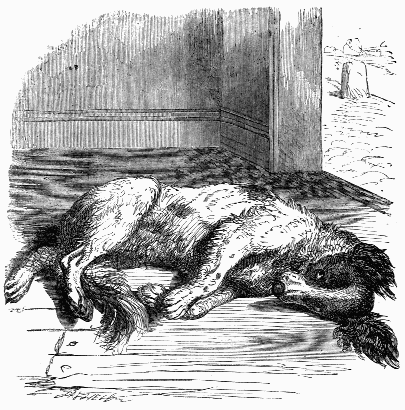
To buy him a coffin,
But when she came back
The poor Dog was laughing...."
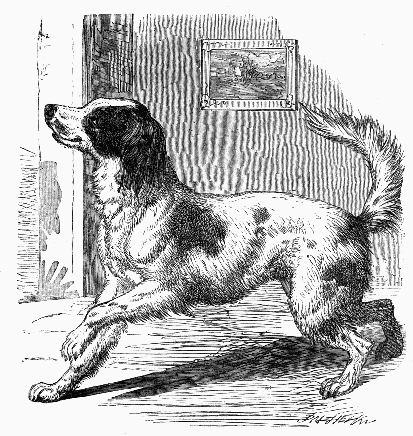
"A dog starvd at his Masters Gate
Predicts the ruin of the State..."
- Auguries of Innocence, William Blake

He then speaks in what could easily be seen as a riddle which explains the very nature of being reborn – for if one were not able to be “put together again” by all the kings horses and all the kings men – then one could be made again fresh.
Perhaps this is why Humpty Dumpty says: “Yes, all his horses and all his men would pick me up again in a minute, they would! However, this conversation is going on a little too fast: let's go back to the last remark but one.” To which Alice says “I'm afraid I can't quite remember it” - which causes Humpty Dumpty to say: “In that case we start fresh.”
They could not return to the conversation which had been lost or forgotten, any more than a broken egg could be put back together again – but a new one could be born – as can a new conversation." And what could this tell us about the wall?
In the Map of Faerieland, Sleigh has drawn "Humpty Dumpty" upon the impenetrable wall into the Air Realms - to represent the necessity of being "born again" in order to enter.
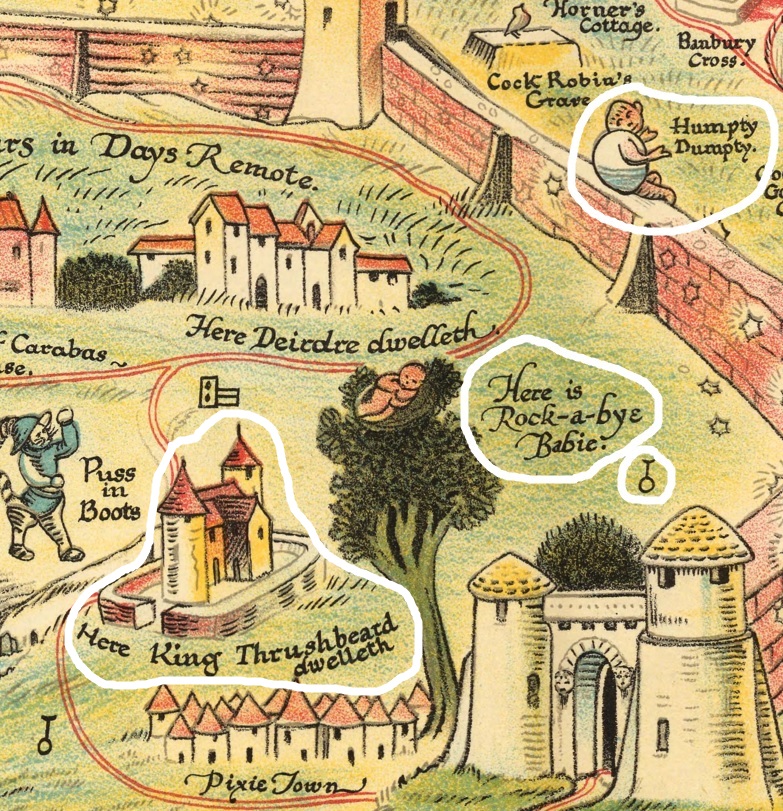
"She followed, half awake and half asleep,
Until she came into the land of faery,
Where nobody gets old and godly and grave,
Where nobody gets old and crafty and wise,
Where nobody gets old and bitter of tongue..."
- The Land of Heart's Desire, by W.B. Yeats
Bernard Sleigh has drawn Humpty Dumpty looking into the secret Air World (Faerieland), and directly past "Rock-a-bye-Babie" (who falls from the tree), toward King Thrushbeards house. The reason for this I shall explain by the end of this chapter.
Due to the peculiar order at which we enter Faerieland (if we are using the "SEWN" formula) - we are effectively moving from the season of "Summer", back to "Spring" - which is not a natural progression as such - but one which requires a return back into a childlike state.
“Truly I tell you, unless you change and become like little children, you will never enter the kingdom of heaven." - Jesus Christ
Notice that all around the outskirts of the "Air Realm" leading to the impenetrable great wall - are mostly "Nursery Rhymes" - the very definition of which is designed for young children or young plants. We are used to hearing these rhymes when we were first born upon this earth.
In "The Book of Fire - Vol. I", when I first meet with Hermes, I describe him as being in slightly older and more pastoral form - similar to some depictions of "Pan":
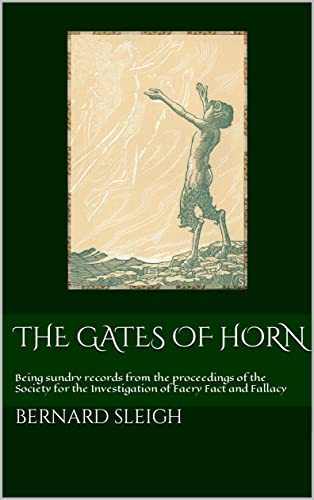
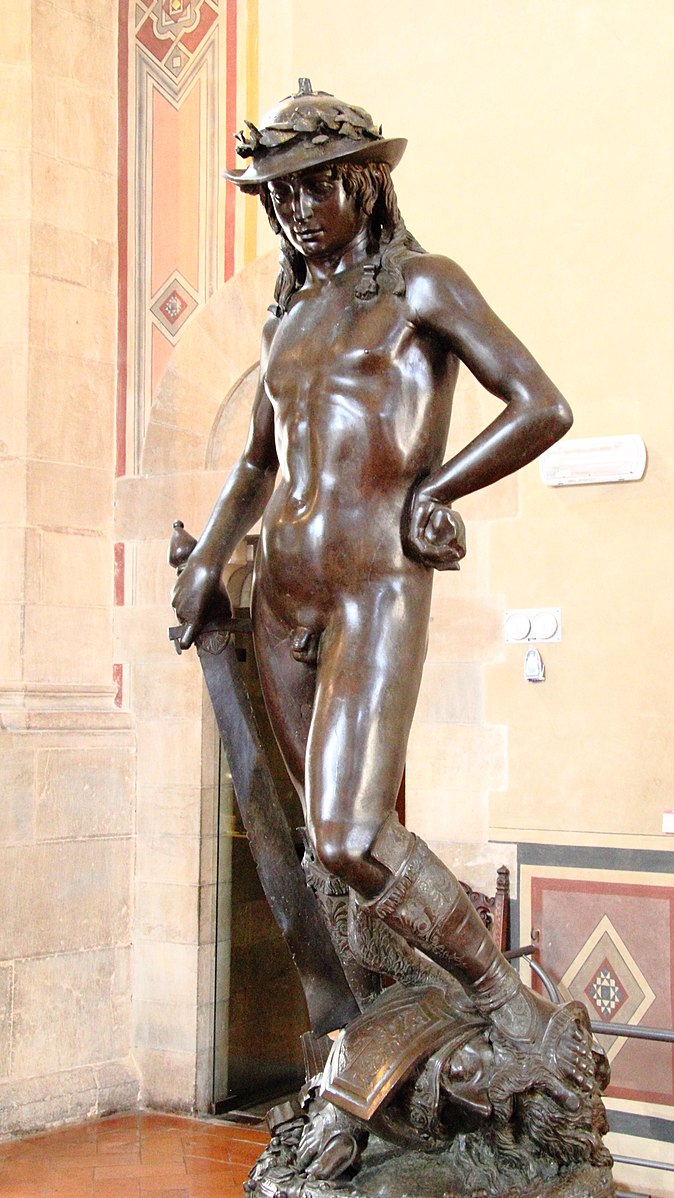
All of this is to represent this transformation that I am referring to which must take place when we "fall" from the heavenly fire of divine inspiration and knowing, into Faerieland.
"When the wind blows, the cradle will rock,
When the bough breaks, the cradle will fall,
A
"The wind blows where it wishes, and you hear the sound of it, but you do not know where it is coming from and where it is going; so is everyone who has been born of the Spirit." - Jesus Christ
Jesus also said "truly I tell you, no one can see the kingdom of God unless they are born again."
To which Nicodemus asks “How can someone be born when they are old? Surely they cannot enter a second time into their mother’s womb to be born!”
And Jesus answers, “Very truly I tell you, no one can enter the kingdom of God unless they are born of water and the Spirit. Flesh gives birth to flesh, but the Spirit gives birth to spirit. You should not be surprised at my saying, ‘You must be born again.’"
Circled in the picture above (with Humpty-Dumpty and Rock-a-bye-Baby) is the symbol which refers to a "wishing well" or a fountain. The first thing that happened upon entering into the "Air Realms" ("behind them brick walls", as Led Zeppelin puts it), with my guide "Hermes", is that he "takes a large glass of the water (from the fountain / wishing well) and hands it to me to drink. I take a large drink of the water before falling to the ground and collapsing into a state of divine ecstasy and interior bliss. I feel such deep feelings of peace I have never felt before and I dream and sink into blissful oblivion."
The very first thing that I write in the "Book of Air - Vol. I" is this: "Hermes looks more youthful than he had in the Fire Lands, and his horns which were once like those of a ram, now appear to be much shorter. He leads me past the fountain near the entrance by the gate, and through an archway connected to the exterior of the white palace and into a beautiful garden path surrounded by the most magnificent scented flowers, plants, and jewels of all kinds. This leads us to a crossroads where there is a clear pathway that goes either to the left, right, or continues ahead. I go on straight ahead until I arrive at a forest entrance. Hermes silently leaves me here and walks back down the path where we came from. I venture into the forest."
Upon entering the forest (which I will omit the descriptions of here), I eventually discover some stairs which "lead down into certain channels filled with the bluest and clearest refreshing water which covers some of the stairs until it leads into a very deep pool of water at the bottom of the stairs. It is easy to see the bottom of the pool, and the surface of the ground is entirely covered in soft and sparkling colorful gemstones."
I also write: "One of the more commonly found gems which specifically shines out the most from the pool floor appears in my mind with the name: BERYL." - which I have since discovered is the stone which is ruled over by "SIRIUS".
Finally I write: "These are the baptismal waters, and as I immerse my whole body down the stairs and into the pool completely I feel myself being entirely cleansed, renewed, healed/replenished. After my head goes into the water and then back out, I see a white dove fly above and very near to me before taking off into the distant deep blue skies. I think of the Holy Spirit, and how Jesus saw a dove after being baptized in the waters, and how this might have held a key or certain information on something that we can each unlock within ourselves."
Then I step out and into "Faerieland", indicating that we must be purified and born again in both "Water" and "Spirit" in order to enter.
When you drink from the "Wishing Well" - depicted as a key from within the Great Gates into the Air World - you sink into trance/sleep/oblivion from where you can be transported to different locations - some of which are transformed versions of things that were already experienced on the outside of the wall - but which are now somehow within the wall, and in an alchemized form.
In my case I was teleported to this other part of the map - in the South, though still within the "Air World".
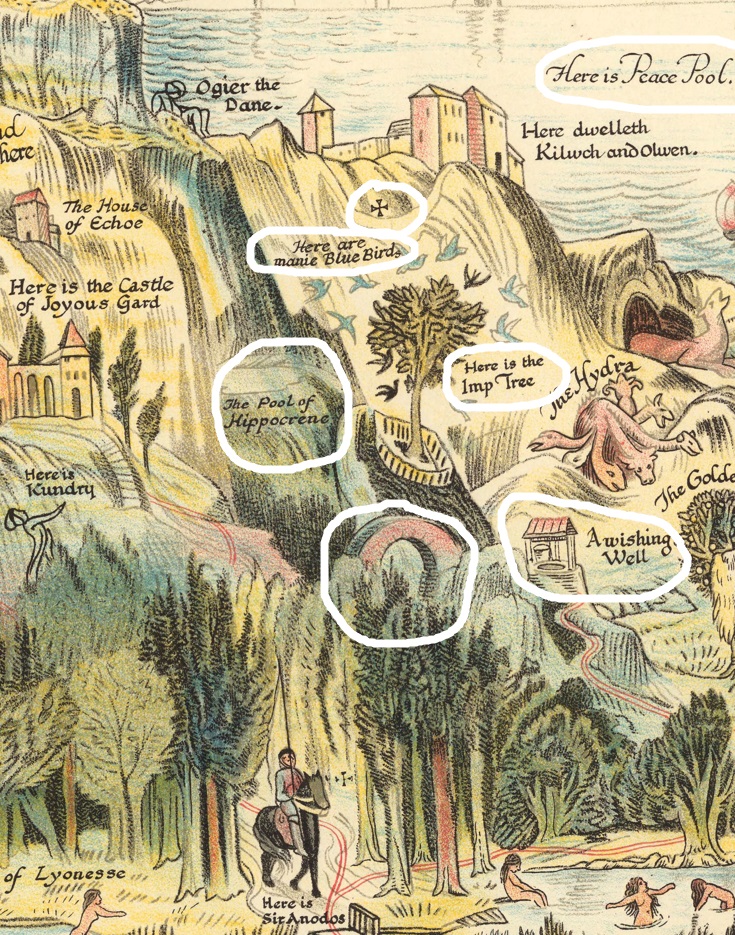
This "Wishing Well" looked exactly the same as the wishing well found within the gates to the Air World (as did all of my surroundings), so that I had no idea I was already somewhere else. Part of the reason for this is that right next to the Great Gate Entrance into the Air Realms, is a "Pixie Town" - something I did not notice, and these lead to bewilderment and confusion.
Things appear quite different from within the Air Realm, compared to what they do outside of it - and this map can only represent so much of that unless it were somehow able to shift and change as the locations themselves do in that realm.
"It has been thought well to make some slight survey of the available paths in this land, where some tracks, though well trodden and seemingly familiar, yet vanish and re-appear- and vanish again in bewildering fashion - baffling and discouraging even to the most earnest traveler." - Bernard Sleigh
But the above image shows the "archway", the "wishing well/fountain", the "imp tree", and the "Pool of Hippocrene" (where I bathed in the water before entering the Faerieland Plains) - and the "many blue birds" somehow remind me of the white dove which flew above my head upon immersing in the "baptismal waters" of what is referred to here as "Hippocrene Pool".
The White Palace is not represented as being connected with the archway, as that is more likely to be somewhere near "Old King Cole's Palace" (if not represented by this itself), and leads to Morgan le Fay's dwelling place near that. Though having already been deceived and led astray by the pixies by the time I reached this landscape - it is difficult for myself to make any clear conclusions on where these aspects were placed exactly in accordance to the map.
I did write about imps near the archway/fountain though at the very end of the Fire Book - upon entering the Air Realms: "I also spy some impish like creatures ahead who are quite small and mischief in appearance, jumping up and down on something before scurrying away into the many trees and hidden places."
To the left of the "pool" on the map, is the entire Holy Grail mountain which I did not explore, yet which is very much part of the guarded Air Realms.
There are long pathways, gardens, crossroads, forests, and so on before reaching what is represented here as the "Pool of Hippocrene" - none of which have clearly been marked out on this map (though many of these locations are very secret to the Air Realms specifically), hence why they are so heavily guarded behind an impenetrable wall and inflexible gate. Because the "Air Realm" also contains landscapes within it of spring, summer, fall, and snow - there are several cross over points between both the outside realms and the inside realms.
The Holy Grail mountain is very likely a much warmer/summery location within the Air Realm for example which is why it is drawn above the South on the map. This is the same with the "imp tree" which is a story that takes place on a "hot afternoon in summer" but is still heavily connected with the Air Realms (with "beauteous ladies dressed in pure white, riding on snow-white steeds", the castles, the faerie king etc). These may also reside in the Underworld or the Holy Grail mountain, for I have not yet deeply explored either of those two locations.
There are crossover points between the realms where a person outside of the Air Realms may meet one that is from there (the cross or "faerie shrine" depicted just above the tree).
An "imp-tree" can actually refer to a young "grafted-tree" which is where tissues of plants are joined so as to continue their growth together. So this is why it is actually representative of a "joined" spot between the Air and Fire Realms (represented by the "Faerie Shrine Cross") - as it is a portal between the two realms. Hence why Heurodis fell sleepy beneath the tree, and was then taken away to the Faerie Realms - because she was at a crossroads / meeting point.
When Orfeo and a thousand knights stood guard around the Imp Tree in an attempt to be able to protect Heurodis from being taken away by the Faerie King, the story in "Fairy Gold", says: "in spite of all, she was snatched away under their very eyes; and in vain were all their efforts to see which way she and her faerie captors were gone..."
This imp tree is depicted on the map right next to the "Hydra" and "Cerberus" which are the entrances to the "Underworld". This resides beneath the Holy Grail mountain and is possibly where the Faerie King himself reigns, though could also lead by secret underground channels to the Air Realm (from the Earth Realms) considering the Faerie Queen's castle is also called "Oberon's Palace" on the map. I have yet to meet Oberon and learn of these mysteries next.
Though they are written in the story to travel through a cleft in the rock - the descriptions of "the fairest country ever seen, where it is high midsummer and broad sunlight. In its midst stands a palace of an hundred towers, with walls of crystal, and windows coped and arched with gold. All that land was light, because when the night should come, the precious stones in the palace walls gave out a light as bright as noonday. Into this palace hall Orfeo entered, in the train of the ladies, and saw there the King of Faerie on his throne." sounds a lot more like "Oberon's Palace" within Faerieland itself, rather than in an Underworld - though perhaps with Underworld Pathways.
Considering that this story is clearly based on the Story of Orpheus and Eurydice's journey into Hades/Underworld - (Hades/Pluto the "giver of wealth", and the "unseen" - synonymous with the land of the dead and the Underworld), the role of the "Faerie King" in this story is the same as that of Hades, which seems to imply an association that King Oberon has with the secret underworld.
The following picture is a stillshot from the music video "Hall of the Mountain King" by the very enchanting band: Savatage.
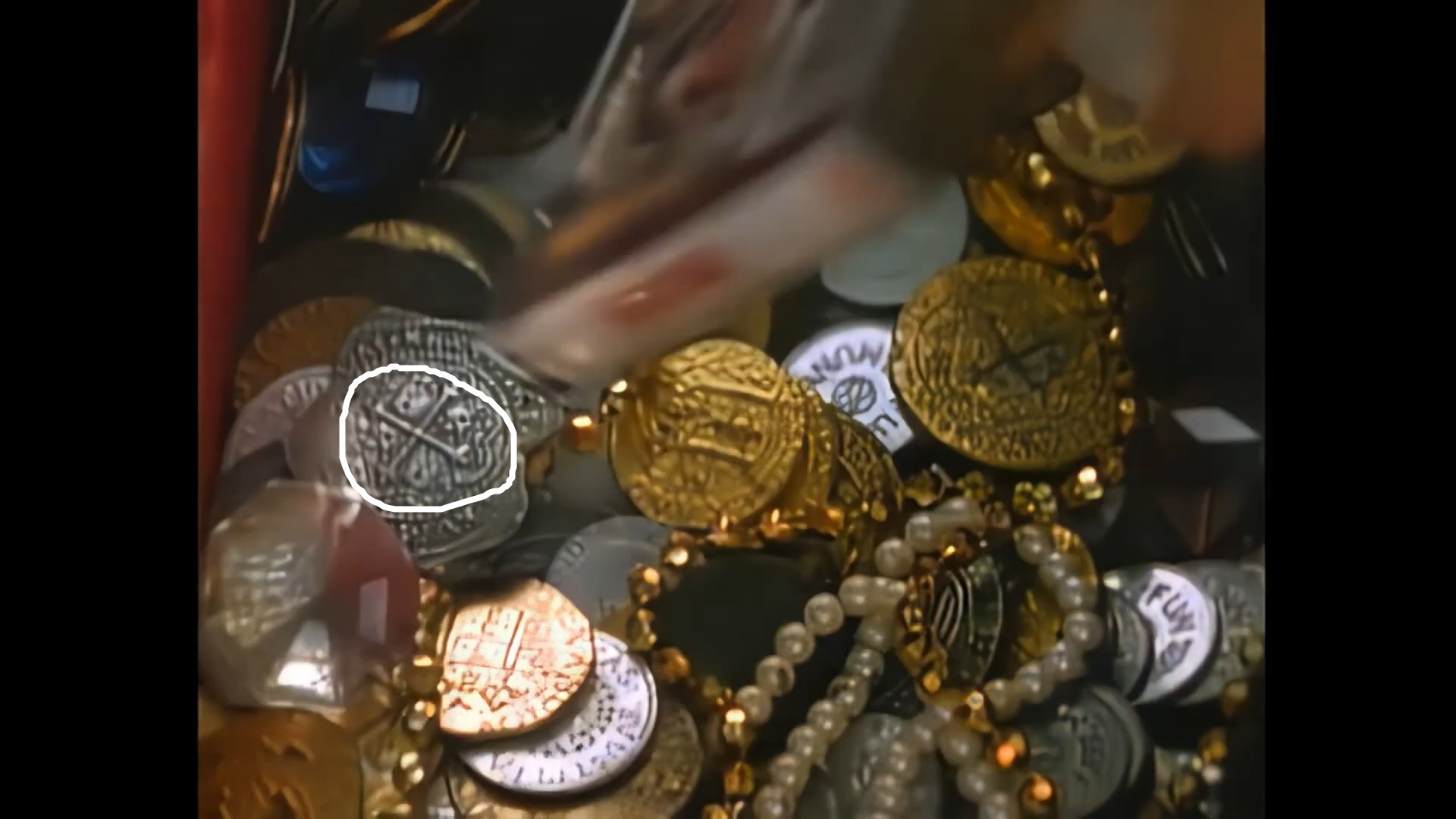


""Impenetrability! That’s what I say!”
“Would you tell me, please,” said Alice “what that means?”
“Now you talk like a reasonable child,” said Humpty Dumpty, looking very much pleased. “I meant by ‘impenetrability’ that we’ve had enough of that subject, and it would be just as well if you’d mention what you mean to do next, as I suppose you don’t mean to stop here all the rest of your life.”" - Through the Looking Glass, Lewis Carroll
"When I found the door was locked,
I pulled and pushed and kicked and knocked.
And when I found the door was shut,
I tried to turn the handle, but—”"
“It wouldn’t look nice,” Alice objected. But Humpty Dumpty only shut his eyes and said:
“Wait till you’ve tried.”
This meant two things at once though - which Humpty Dumpty is very good at doing.
“Give me the joy of sight” I cried
“O Master of Hidden Fire!
By the flame in the heart of the soul,
Grant my desire!”
And a voice said: “Wait till you pass the gate.”
- Fiona Macleod
"What can be seen from the outside is a large wide expanse of open garden, a fountain in the far center, and behind that in the distance can just be seen a large white marble-like building but this is much more visible from within the garden on the other side of the invisible impenetrable wall.
Hermes shares some things with me here which I am not able to write in this book but he takes me through secret pathways until we are standing on the other side of the gate, inside the Air World." - The Book of Air - Vol
The earliest known version of the rhyme from 1797 in Juvenile Amusements says:
"Humpty Dumpty sat on a wall,
Humpty Dumpty had a great fall.
Four-score Men and Four-score more,
Could not make Humpty Dumpty where he was before."
In "Through the Looking-Glass" the last line is "couldn't set Humpty Dumpty in his place again", which Alice points out is "too long" for the rest of the poem. Modern versions have changed it to "couldn't put humpty together again" to avoid this trouble - though they missed the point.
What is truly funny is that they already put him back together again by fixing the rhyme... but unfortunately for them, he was meant to be broken because that was his whole POINT - and unfortunately for us, he has now become broken in his perfection and consequently has still not been put together... In fact, the only way for him to be put together again would be to break the flow of the rhyme again - but then he would still have to be broken, wouldn't he?
“I shouldn’t know you again if we did meet,” Humpty Dumpty replied in a discontented tone, giving her one of his fingers to shake; “you’re so exactly like other people.”
And so this is why nobody, no matter what they do - will ever be able to put Humpty Dumpty back together again, because in order for him to be put back together again, he would have to remain broken. He therefore remains both broken and fixed. It is a "TIE" and a "BIND".
"In autumn (FALL),
When the leaves are brown,
Take pen and ink,
And write it down...”
He is the toughest riddle that can never actually be fixed, even after he has been understood.
"I can manage the whole lot! Impenetrability! That's what I say..."
Perhaps he is still sitting up on that wall, enjoying the Fall - and nobody can bring him down from his high horse. And even if this is complete nonsense, it still somehow cracks me up:P
"Why, if ever I did fall off—which there’s no chance of—but if I did—”"
And thus he is the perfect symbol for the complex wall enclosing the paradise of Faerieland. But you must be as children to enter! It serves you no use to think of the same old rote ways.
You must see everything from a fresh perspective!
DISSOLVE AND COAGULATE.

Due to this perceived failure of a poem they also presumed that Humpty Dumpty must be a failure and falling from the wall - and they visualized him as a silly egg and made fun of him - imagining that he breaks into many pieces, and being unable to perceive him with new eyes.
Contrast this with the story of King Thrushbeard in which a king's beautiful daughter is so proud that none of her suitors are good enough for her - and she criticizes every one of them - not only finding fault, but making them into a laughing stock.
All of the kings men were called to a great feast (not unlike "all the kings horses and all the kings men" in Humpty Dumpty) - from the kings to the princes, dukes, earls, barons, and noblemen, etc. The princess had a mocking epithet for every single one of them, calling one of them too fat, another too tall, another too red-faced, another "not made well enough", etc.
Not unlike those who decided they could "improve" upon their perceived imperfections of Humpty Dumpty.
She created mocking lines even for a particularly good king whose chin had grown a little peaked, saying that it looked like a "thrush's beak". From then on he got mocked and called "King Thrushbeard", but the father of the daughter - seeing how she mocked everyone, swore that she would be forced to marry the first beggar who next walked in the door.
She then had to leave the castle and be with a beggar - and on the way to his hole in the dirt - they walked through King Thrushbeard's forests and meadows and cities - seeing all that she might have had if only she been with King Thrushbeard instead of mocking him (this too is quite symbolic of all a person would receive and unlock of the faerie worlds if they were actually able to stand-under humpty dumpty, instead of above him), but now she must stay with this poor beggar man instead.
Eventually she is forced to have to sell wares at the market where people from her father's kingdom would see her and also mock her ("It's very provoking to be called an egg - very!" said Humpty Dumpty, in Through the Looking-Glass). While she is seated in a corner of the market surrounded by the pots she is selling - suddenly a drunken horse-soldier comes plunging by, and rides straight into the pots, crushing and breaking them into a thousand pieces beneath the horses hooves. ("all the kings horses and all the kings men, couldn't put humpty together again" is the modernized version of the nursery rhyme, which was changed from "Four-score Men and Four-score more, Could not make Humpty Dumpty where he was before.")
Eventually she goes back to work as a kitchen maid at her father's castle - and has several of the pots lining her pockets which she would fill with little fragments and left-overs to take home with her - and one day King Thrushbeard came to the castle to court her. He drew her into the room and suddenly all her pockets burst and the foods and soups were scattered all over the floor (not unlike a broken egg) - and there was great laughter and mocking. But then as she was running away - King Thrushbeard appeared in front of her again and said to her:
"Do not be afraid, I and the beggar-man with whom you lived in the wretched little hut are one. For love of you I disguised myself, and it was I who broke your pots in the guise of a horse-soldier. I did all that to bring down your proud heart, and to punish your haughtiness, which caused you to mock at me." Then she wept bitterly, and said,
"I have done great wrong, and am not worthy to be your wife."
But he said,
"Take courage, the evil days are gone over; now let us keep our wedding-day."
And the two of them lived in happiness, marriage, and splendor.
This is really a typical way that a faerie might teach us something, especially in disguised, lower or unexpected form.
We can see here though how much this story connects with our new interpretation of the story of Humpty Dumpty. That before we criticize, mock and make fun of a poem or anyone for being different in their appearance or thinking or expression - to consider that there may potentially actually be something of higher value to be found in their seeming imperfection.
"So Alice got up, and held out her hand. “Good-bye, till we meet again!” she said as cheerfully as she could.
“I shouldn’t know you again if we did meet,” Humpty Dumpty replied in a discontented tone, giving her one of his fingers to shake; “you’re so exactly like other people.”
“The face is what one goes by, generally,” Alice remarked in a thoughtful tone.
“That’s just what I complain of,” said Humpty Dumpty. “Your face is the same as everybody has—the two eyes, so—” (marking their places in the air with this thumb) “nose in the middle, mouth under. It’s always the same. Now if you had the two eyes on the same side of the nose, for instance—or the mouth at the top—that would be some help.”
“It wouldn’t look nice,” Alice objected. But Humpty Dumpty only shut his eyes and said:
“Wait till you’ve tried.” - Through the Looking-Glass, Lewis Carroll
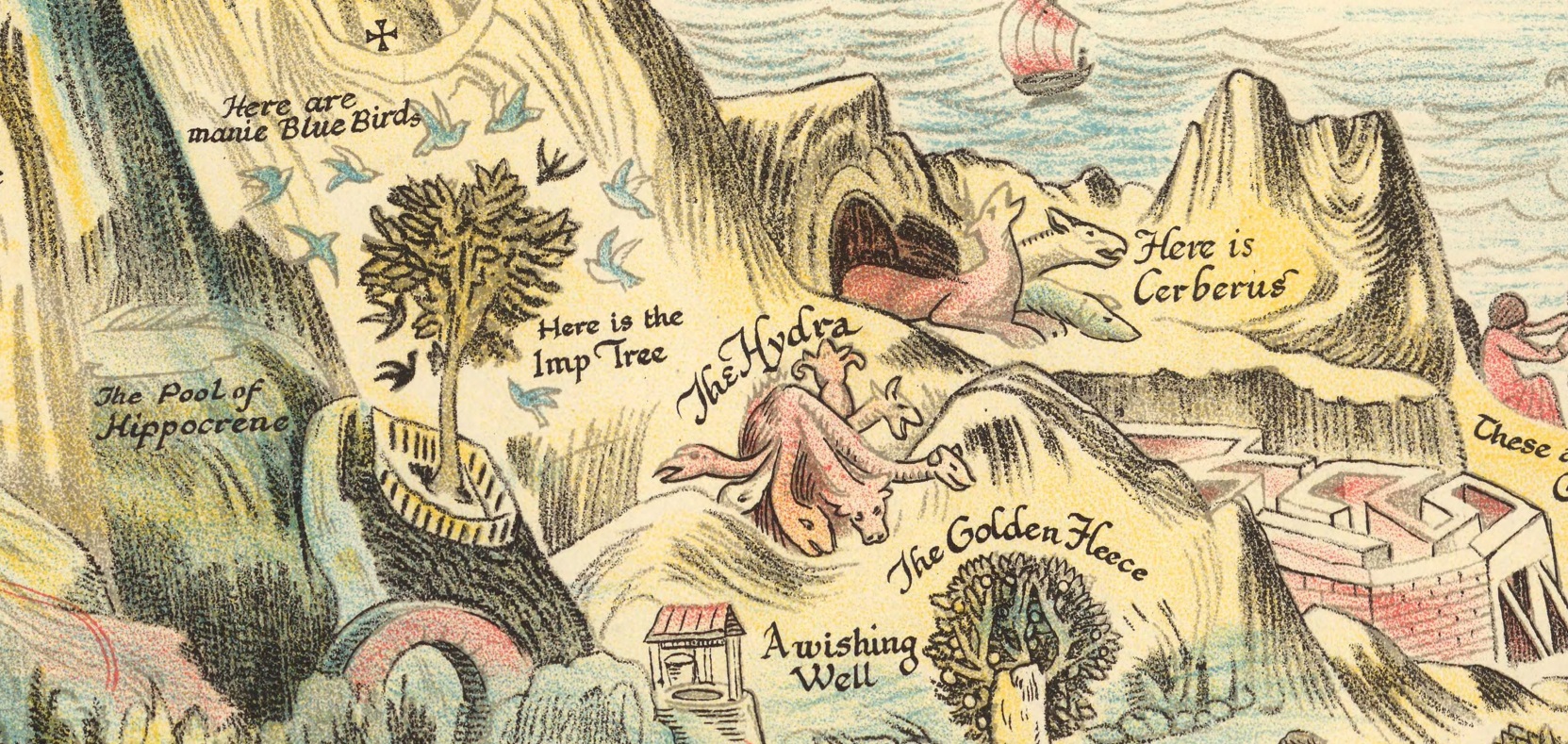
"Can she walk? . . . She can run, she can dance, she can fly ! . . . When she saw the bird, she jumped, just like that, with one bound, to the window, to see by the light if it was really
Tyltyl's dove. . . . And then, whoosh! . . . Out into the street, like an angel ! ... It was as much as I could do to keep pace with her. . . "
So we are seeing the same effects here which I described occurring upon entering the realms of Air/Spring and of partaking in the water/fountains and bathing in the baptismal waters which produced the symbol of a dove flying above alongside deep levels of rejuvenation and healing - all of which is signified by these blue birds of paradise (for the children had been searching for the "blue bird" for the fairy to heal her girl with, but settled on their own dove).
"It's my turtle-dove ! . . .
But he's much bluer than when I went away! . . .
Why, that's the blue bird we were looking for ! . . .
We went so far and he was here all the time..." - "The Blue Bird".
"These are the baptismal waters, and as I immerse my whole body down the stairs and into the pool completely I feel myself being entirely cleansed, renewed, healed and replenished. After my head goes into the water and then back out, I see a white dove fly above and very near to me before taking off into the distant deep blue skies. I think of the Holy Spirit, and how Jesus saw a dove after being baptized in the waters, and how this might have held a key or certain information on something that we can each unlock within ourselves." - The Book of Air - Vol. I
Their dove also takes off and flies away at the end: "If any of you should find him, would you be so very kind as to give him back to us?... We need him for our happiness, later on...."
The way that Arthur Edward Waite puts it in the introduction to "Elfin Music" is this:
"The power of the Fairy King over the royal lady of earth appears to have been given him in virtue of her slumber beneath an elvish tree, which, though growing in her husband's orchard, made the surrounding grass-plot the property of the elvish world."
While Pegasus himself (who flies through all the many dimensions) is depicted in the "Fire" section of the map - the "Pool of Hippocrene" is within the "Air" boundaries - and it is this pool which was actually opened by a kick from the hoof of Pegasus. This is the reference given to Pegasus being associated with the Air Realms.
Because the story of Perseus is more focused around the nature of the Fire Realms - it also makes sense to place Pegasus in somewhat close vicinity to Perseus - due to it being the blood from Medusa's cut off head which produced the winged horse Pegasus.

The poem reveals that Pegasus "once into a quiet village, without haste and without heed, in the golden prime of morning, strayed..."
This speaks of his curious and carefree nature very well - and how he could be known to stray into realms outside the boundaries of the air. He is also depicted quite near to where gifts are produced by the ocean around the dawn.
Though the poem references "autumn", it also describes that the apples in the land in which he strayed were like "living coals" and "burned among the withering leaves" - which seems to indicate a relatively fiery landscape. Keeping in mind that the Summerland is also one of the lands of the dead.
He is referred to in the poem as an "estray", and sold (the entrance to fire world is heavily associated to marketplaces too), he is then captured and put to work - though is described in a very faithful/trusting/innocent/pure/patient form (which he is - much like the luckdragon in "The Neverending Story" might be described). During the night, Pegasus escapes and flies again high into the stars and no one can find where he departed to or from (into Air Realms)- but they find where his struggling hoofs had left off, that there is now a "Pure and bright fountain flowing" formed of the "hoof-marks in the sod". Implying that it was Pegasus who bridged and opened the portal found between the Fire and Air Realms near the "Imp Tree".
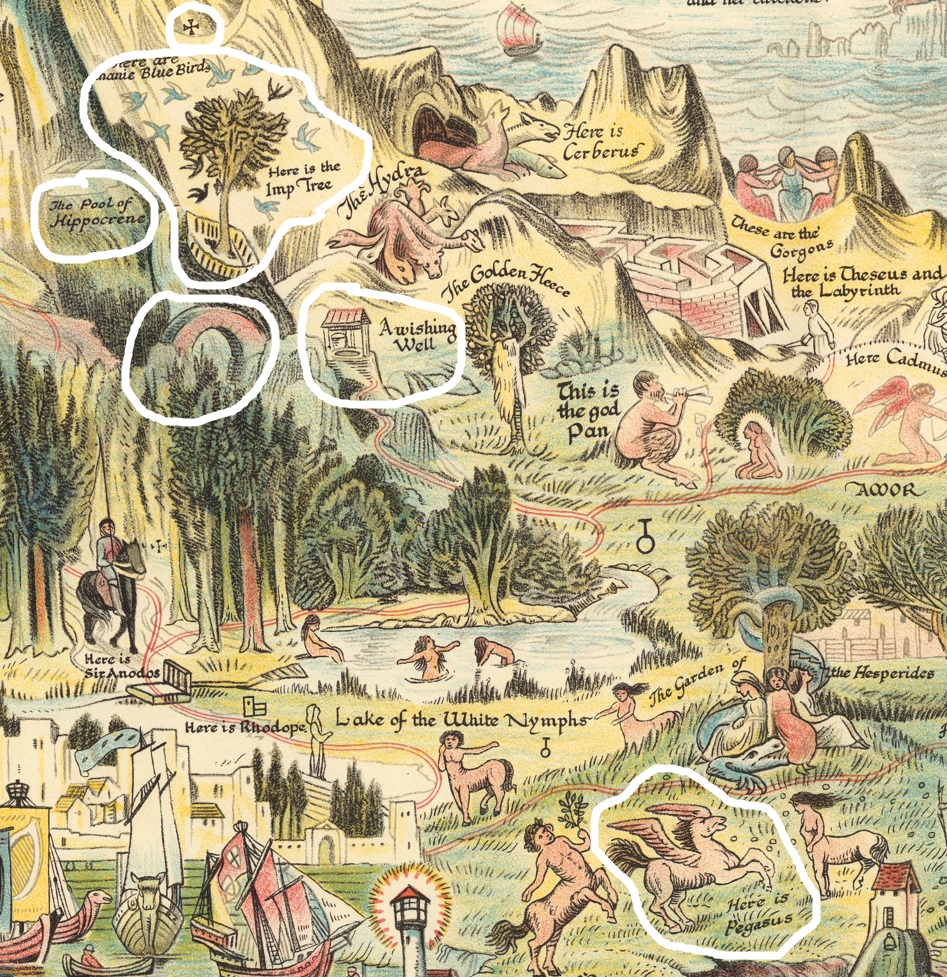
Gladdens the whole region round,
Strengthening all who drink its waters,
While it soothes them with its sound."
- Wordsworth
This "wishing well" which is found next to the archway (near the "imp tree" portal) connects directly to the following "wishing well" that is found once you have made it beyond the gates:
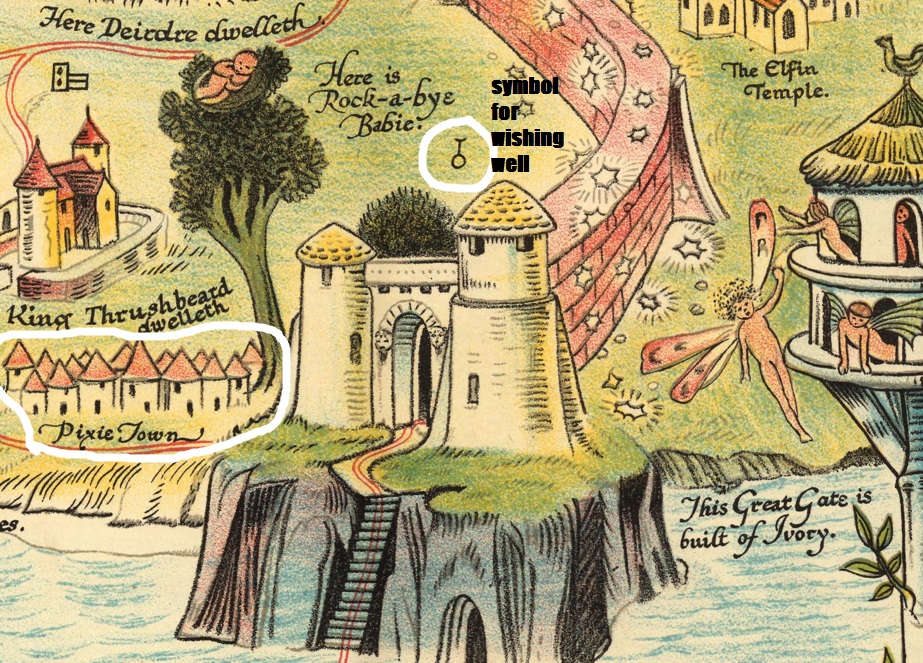
Without realizing what I was writing at the time - it appears I was tapping in to this fact that Pegasus is an opener of portals between the different realms - and that his coming forth into the Fire Realms is one of the ways a doorway was created between the two different realms.
"O for a beaker full of the warm South
Full of the true, the blushful Hippocrene,
With beaded bubbles winking at the brim,
And purple-stained mouth;
That I might drink, and leave the world unseen,
And with thee fade away into the forest dim..."
- John Keats, Ode to a Nightingale
This finally solves the mystery as to why Bernard Sleigh has clearly depicted him within the Fire Realms, rather than where he really lives in the Air Realms (where I expected him to be).
The following artwork of Pegasus is by "Noël Ill" and is in "The Book of Air". Click the picture to hear our song and teleport yourself on the back of Pegasus to hidden and magical realms!

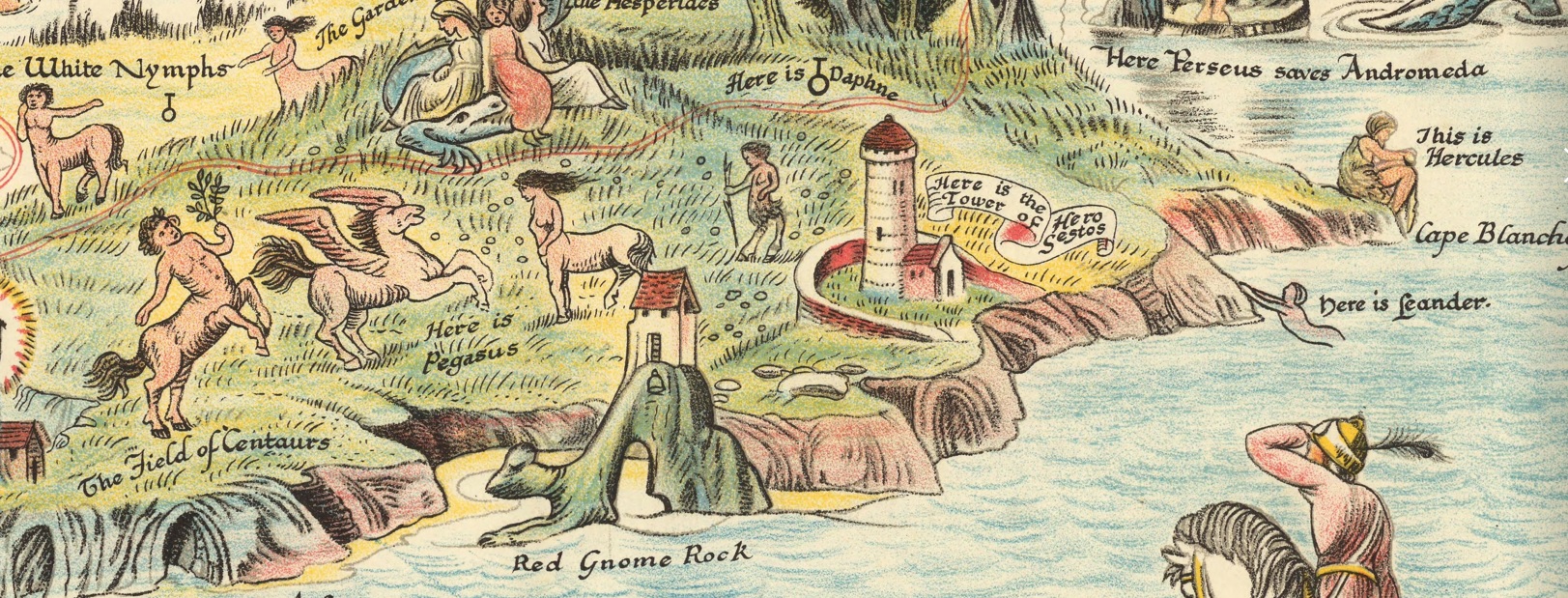
The name "Ahmid" sounds like one from the Fire Realm and it is of interest that Sagittarius is a Fire Sign, considering its core symbol is that of a Centaur. The being also told me one last thing before he left which was that his people are now quite "rare or obscure". Perhaps this could be why I never saw any centaurs while I was at the "Field of Centaurs" - though future adventures will no doubt explain more. Keeping in mind of course that all four elemental books were written many months prior to me ever learning of the existence of this map.
For more information and experiences with centaurs consult my Books of "Air" and "Water".
We also learn much of the water sprites and nixies which are featured on the faerieland map near to where the sun sets at the Sea of Dreams.
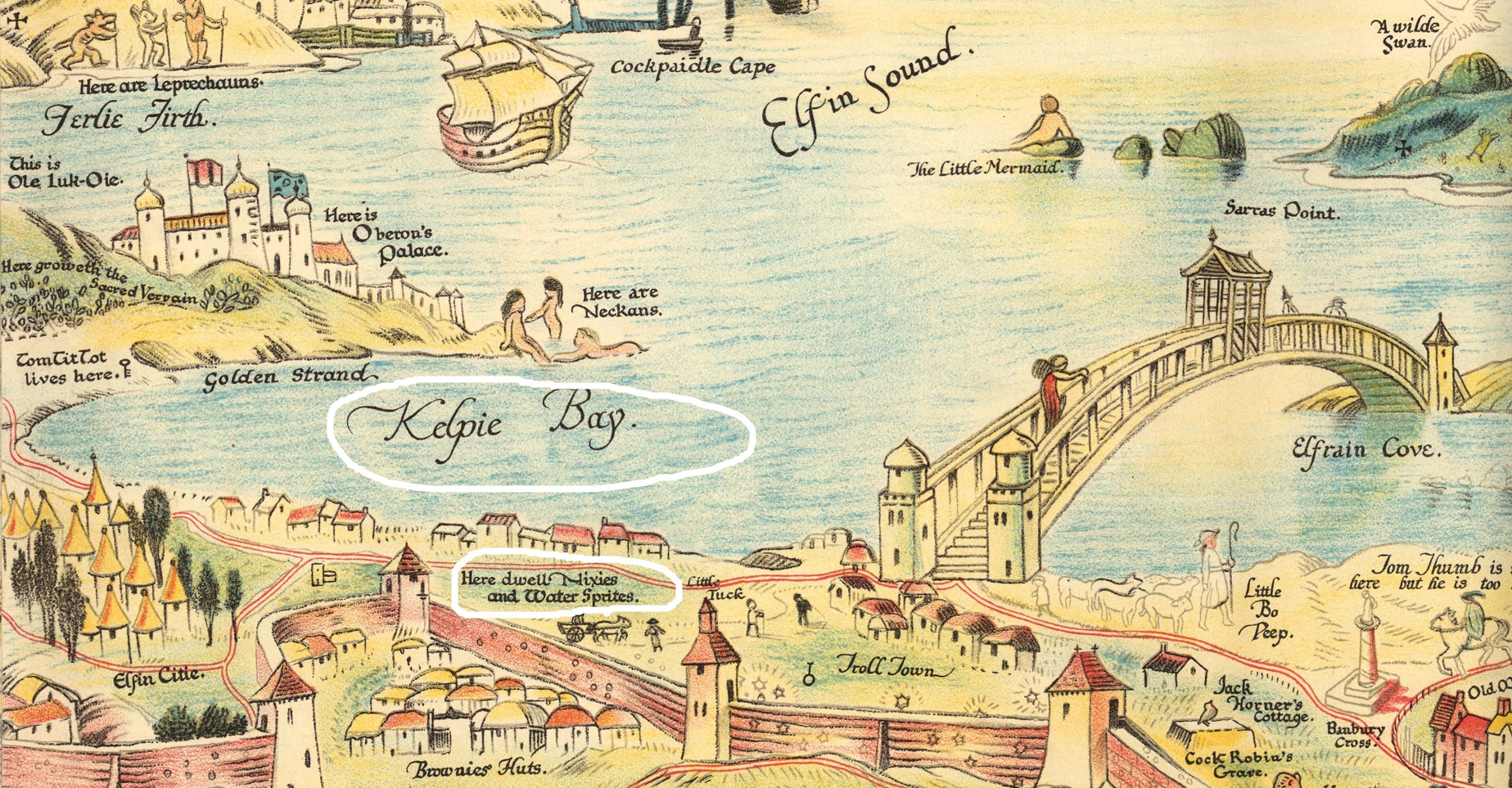
Sinks in the sea;
All fiery glows his ocean bed
There seek me;
For there, my floating tresses lave
In the golden fires of the crystal wave,
For ever free !"
- Song of the Water Sprite,
Elfin Music
I will go more into mermaids, nixies, sprites, etc, during our discussion on the water realms - for this too is a crossover point between the different realms. This is also where the Elves travel to on their boats - which periodically journey to the Fire Realms (among many other places no doubt), and which I speak of meeting in the woods in the "Book of Fire - Vol. I".
In "The Book of Fire", I explain that: "I continue to follow the Elves to the water edge where I saw the other Elves yesterday. I now see several boats coming in with other Elves on them and I am given an opportunity to go with them on the boat but I know that if I go with them I will probably be gone all the way until the morning and I am not yet able to commit to this, as I have several things I have to attend to before bed. I knew I would have many other opportunities however, as the Elves go back and forth from this location on a regular basis..."
During the 40-Day Journey, I never did go back to take a ride on an Elven boat - but it appears I was somehow either near - or potentially going to be taken towards either "Elfin Sound", "Elfin City" and/or "Elfrain Cove".
It is also of great interest that the "Leprechauns" are depicted on the map - at the shore of "Elfin Sound" - as if to await the elves - for I wrote of these too in "The Book of Fire - Vol. I":
"Soon a very beautiful Elven-like boat begins to glide close toward us along the lake, looking very much like those seen depicted with the Elves of Lothlorien in Tolkien's works. There are also a few cloaked elves standing in the boat. I watch as the leprechaun exchanges the ostrich egg to the elves for a large brown material bag filled with gold coins."
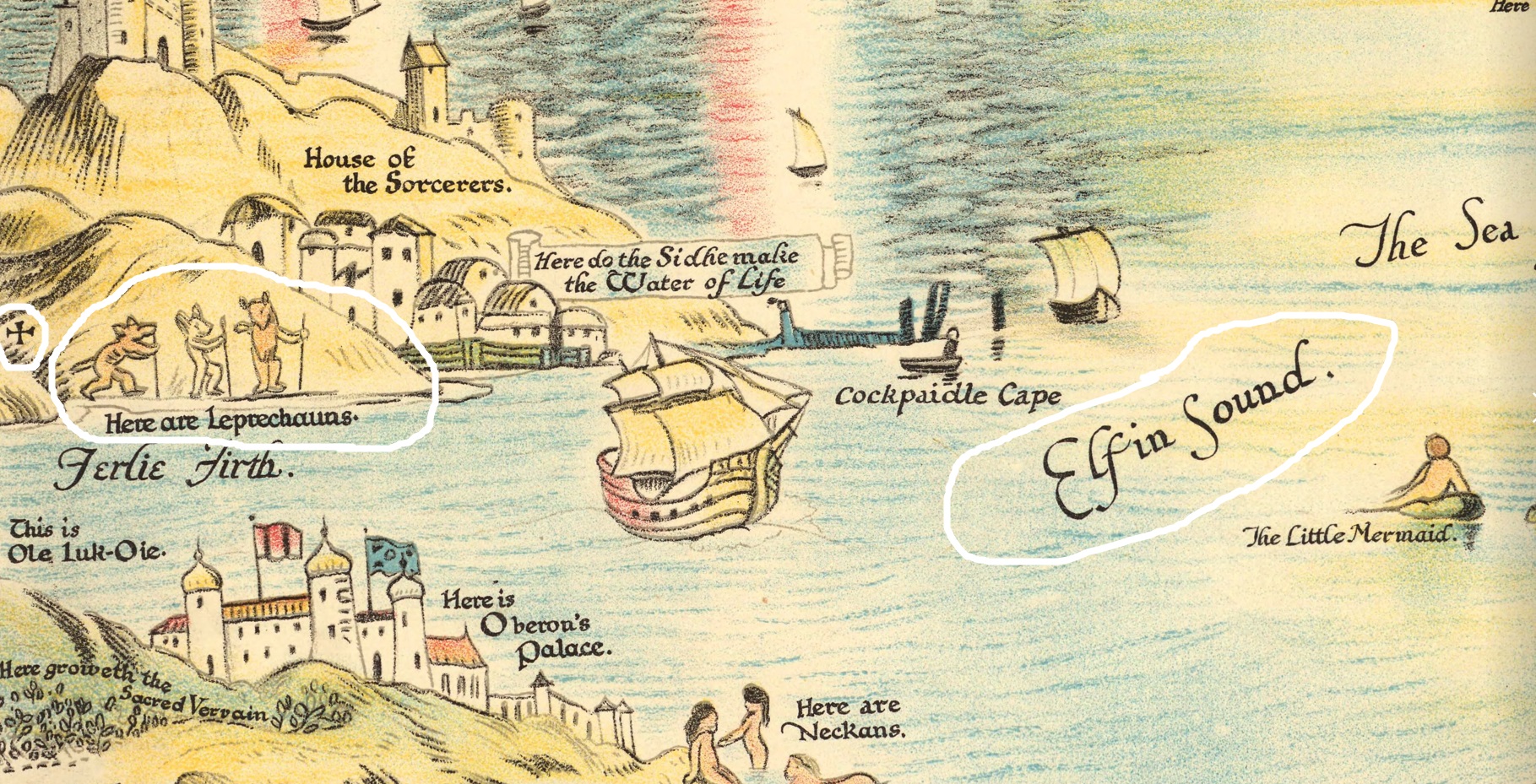
While I thought that I was actually to the right of the entrance city at the South (in the Realm of Fire) when I met with these Elves and the Leprechaun - there is a slight possibility that I was somehow teleported or transported to this location - considering that right next to these leprechauns is the "Faerie Shrine" cross symbol - which we have already seen utilized at other such faerie portals between the realms.
It is also said that leprechaun's are to be at the end of the rainbow with their pots of gold.
The Leprechaun I met had a family of farmers - which is why they had the ostrich eggs.
It is also quite possible that these beings lived in the entryway forests to Avalon - as I would have been closer to these landscapes on the map in my estimation, but whatever the case - the link between the leprechauns awaiting on the elves - appears to line up on this map with what I have shared in the books.
When I first began to explore the "Air World", I wrote in the Book of Fire that: "the Air World appears to be its own energetic “enclosure”." Further describing it as "Hermetically Sealed", and "self-contained". I have pictured this as some kind of giant dome-like structure which has been represented by the impenetrable wall which goes right around the outside of these paradise gardens - but also from high above (as Pegasus and others will fly to great heights). I have also explained that it does not have the actual appearance of a brick wall as in the art - but rather more see-through - though a large deal of the inside is invisible from the outside.
This seems to be well represented in the poem regarding "Kilmeny" - who is also depicted within the fence on the Map of Faerieland:
"The sky was a dome of crystal bright,
The fountain of vision and fountain of light;
The emerant fields were of dazzling glow,
And the flowers of everlasting blow."
She is depicted next to the "Well of Youth" on the map:
"Deep in the stream her body they laid,
That her youth and her beauty never might fade ;
And they smil'd on Heaven when they saw her lie
In the stream of life that wandered by."
It is clear why she is depicted within the Air Realms:
"Long, long after both night and day
When the sun and the world have fled away;
When the sinner has gone to his waesome doom,
Kilmeny shall smile in eternal bloom !"
The following passages also remind us of what we read earlier about how the "The Elysian fields have a sun and stars of its own.", for the Kilmeny poem also goes on to explain that:
"She looked, and she saw nor sun nor skies,
But a crystal dome of a thousand dyes :
She looked, and she saw nae land aright,
But an endless whirl of glory and light..."
Kilmeny is perfectly representative of a pure maiden whose fate it is to live forever in the land of thought and dreams - having conquered death in the sense that she lives on here.
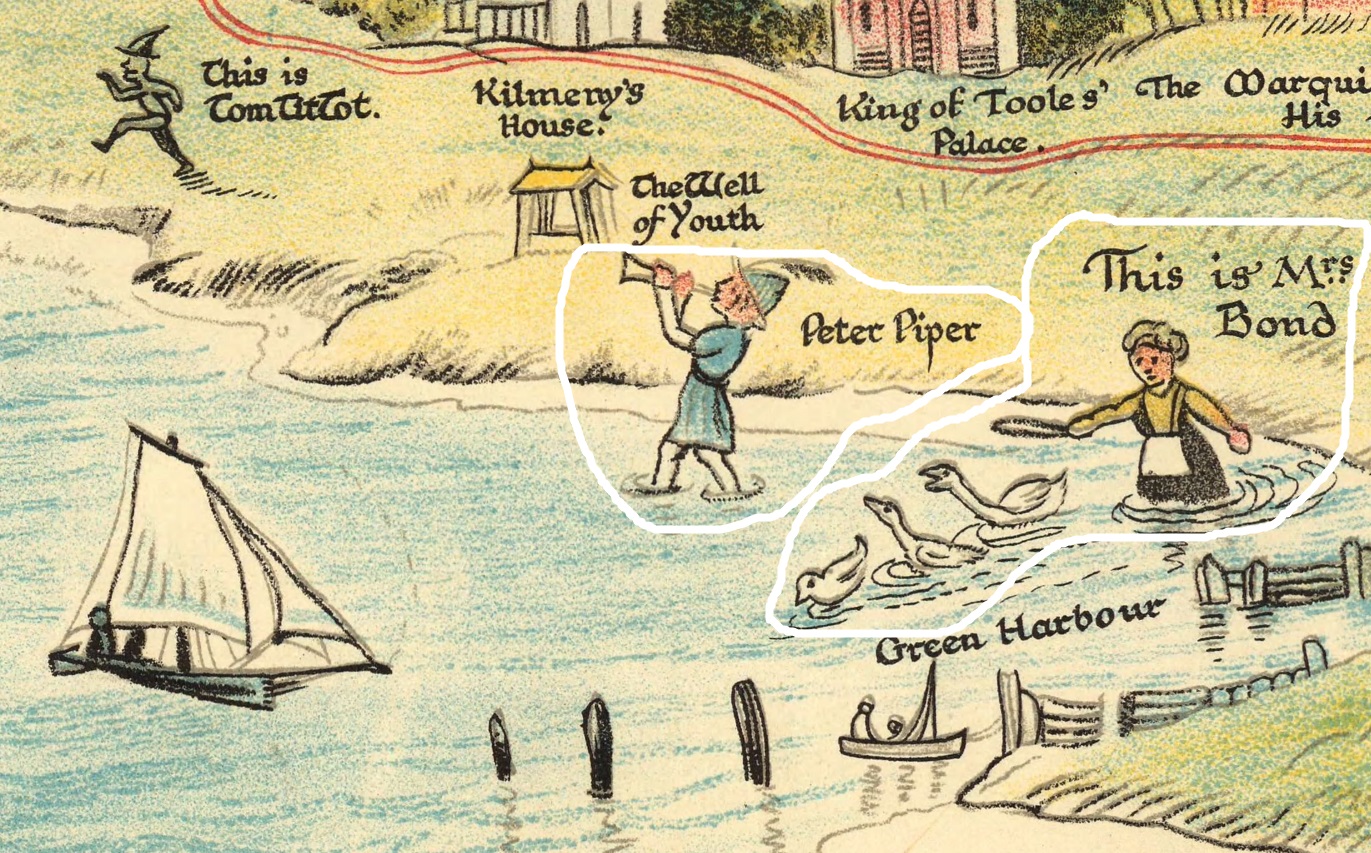
""Oh, what have you got for dinner, Mrs. Bond?"
"There's beef in the larder, and ducks in the pond;"
"Dilly, dilly, dilly, dilly, come to be killed,
For you must be stuffed, and my customers filled!"
"John Ostler, go fetch me a duckling or two,
John Ostler go fetch me a duckling or two;
Cry dilly, dilly, dilly, dilly, come and be killed,
For you must be stuffed, and my customers filled!"
"I have been to the ducks that are swimming in the pond,
And they won't come to be killed, Mrs. Bond;"
I cried, "Dilly, dilly, dilly, dilly, come and be killed,
For you must be stuffed, and the customers filled!"
Mrs. Bond she went down to the pond in a rage,
With plenty of onions, and plenty of sage;
She cried, "Come, little wag-tails, come, and be killed.
For you shall be stuffed, and my customers filled!""
Initially I looked into the fact that a "Dill" is a herb (which is very good for ducks I might add), and which they love. It is also used as a "Pickle" - funnily enough, so I felt that there might be a key in this to comprehend where the peck of pickled peppers that Peter Piper picked went.
I also found that a "piper" can be a baby pigeon - which seemed of interest due to the "peck". And the fact that "King O'Toole's" house is near the two of them - whose story also revolves around a goose. So there would be a pigeon, ducks, and a goose.
If Mrs Bond were referring to the "Dill" herb though - then how would they be stuffed (besides having had a long day), and who would Mrs Bond's "customers" be?
At first I wondered if she could be stuffing the herb into her bag - and her customers in this case would be the ducks - who love the herb! But this did not seem very on point either.
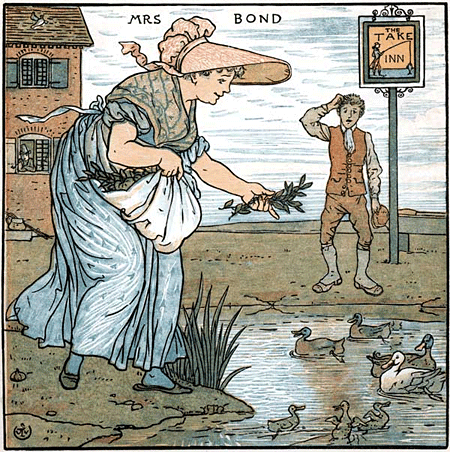
The word "Ostler" refers to an "Innkeeper" which is why in the above picture there is a sign saying the "Take Inn". It is also related to horses or hospitality.
It is interesting that the "Take Inn" has a picture of someone fishing, because another term for a "male duck" is a "drake". This is intriguing due to "drake" also being Middle English for "dragon" or "satan". For example "draca" is a sea serpent/monster. It is also a term for a "mayfly" which can be imitated for fishing.
"Like those that copy gems, I'm thinking,
They all were given to die-sinking!"
- T.H.
Thomas Hood wrote his own analysis-like poem about Mrs. Bond, which goes into more details surrounding some of the themes - mentioning that she has a "drake" with a curly tail, but no ducklings, which she tries to breed, but which keep sinking to the bottom of the pond. He also draws attention to the word "Daffo-dillies" as though to associate the word "dilly" with plants also.
Mrs Bond perhaps also represents a "bind", or a "tie" like Humpty Dumpty wore - just as we might be when trying to comprehend such confusing complexities.
In fact no matter how I brooded upon this dilemma - and the dilemma of "King O' Toole" and his goose - or Peter Piper picking a peck of pickled peppers, or why "Puss 'n "Boots" too is in this area - each possible idea also appeared to sink to the ground and fall into just confusion.
This is because I had become quite used to the answers of these dilemmas being given in very specific order on the outside of the Great Wall, and forgetting that when you begin again from this state of purity and innocence from within the wall, that you must then relearn how to look at these things and to see them just the way they are.
"No peccant humor in a gander
Brought havoc on her little folks, -
No poaching cook - a frying pander
To appetite, - destroyed their yolks, -
Beneath her very eyes, Od rot 'em!
They went, like plummets, to the bottom."
- Thomas Hood
Each thing here must be left to its own and not tampered with or even more interpreted - (even if we think we are improving upon it), for then we shall meet with the very same fate as King Thrushbeard's wife - who found many imperfections in things and criticized them, as we may have done with the last line of Humpty Dumpty.
The Air World is a return to innocence, where everything just is exactly the way that it is.
"Great Johnson, it bewildered him!
To hear of ducks that could not swim."
"At last quite out of heart and ducks,
She gave her pond up, and desponded..."
- Thomas Hood
And indeed, I did the same - giving up on the dilemma and skipping the equation to return to later - without realizing that the "Pixie Town" being so close to the entrance of the Air World, had led me astray yet again, as of course happened to me when I wrote the "Book of Air" - though I had not suspected this to happen while interpreting the map.
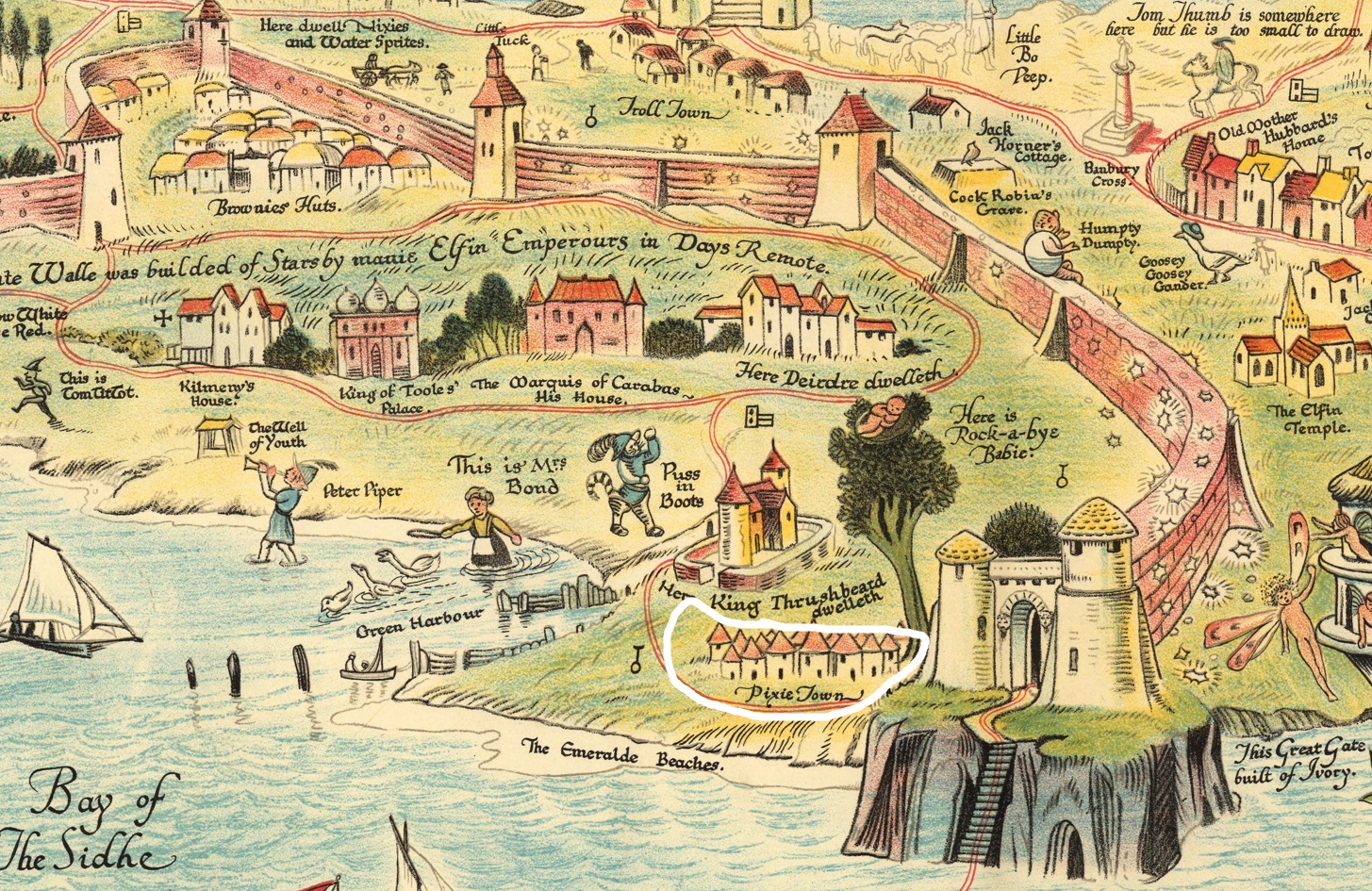
She brooded often on this riddle -
Alas! 'twas darker than before!
At last about the summer's middle,
What Johnson, Mrs. Bond, or none did,
To clear the matter up the Sun did!
The thirsty Sirius dog-like drank
So deep, his furious tongue to cool,
The shallow waters sank and sank,
And lo, from out the wasted pool,
Too hot to hold them any longer,
There crawled some eels as big as conger!" - T.H.
The Neverending Story says the following:
“Whatever comes your way you must never interfere, because from this moment on your own opinion ceases to count. For that same reason you must go unarmed. You must let what happens happen. Everything must be equal in your eyes, good and evil, beautiful and ugly, foolish and wise, just as it is in the eyes of the Childlike Empress. You may only search and inquire, never judge. Always remember that, Atreyu!”
I write the following about "Pixies" in "The Book of Air - Vol. I":
Pixies particularly thrive in the Air World because this is one of the more “enclosed” paradisiacal environments, free from intrusion. The story of The Three Little Pigs is a good symbol for the flight of the pixies from a world of danger and into security. The house of bricks being the equivalent of the “enclosed” garden of the Air World. And in fact, the earliest published version of The Three Little Pigs from 1853 did actually have three little “pixies” in place of the pigs.
These pixies are chased by a fox, and rather than a house of bricks, the third pixy has a house of iron which prevents the fox from breaking in. However, eventually the fox does sneak in while the door is open and catch the pixy in a box, but the pixy uses his own magic to trick the fox into switching places with him, and later the fox dies.
This connection of pigs to pixies is not a new one. It is thought for example that hedgehogs (or urchins) can be secretly pixies/pigsies in disguise – and another word for “hog” is of course “pig”."
Some of the earliest known printed references to pixies are connected to this concept of leading others astray such as in words like “pixy-path” which meant “bewilderment” or literally a “path on which one is led astray by pixies”. Also “pixie-led” which means “lost” and “bewildered”.
The word “pick” comes from “picken” which is “to peck” - or “to work with a pick, to dig up”. Also potentially connected to “prick” (implied by picung “a piercing/pricking”). Pique is sometimes connected to a slight irritation or annoyance which “stings”, “pierces”, or “pricks”."
And so in this way the pixies are represented by these various rhymes and stories of Peter picking pickled peppers and Mrs Bond and the ducks which seem to carry deeper meanings to dig for only to show the flickering and deceptive traps and lights of the playful pixies.
Unlike everywhere else on the map - we have to relearn how we view things at the entry into the Faerie Worlds, and it is very easy to forget this no matter how many times it happens.
Novalis explains it thus: "The more confused a person is - confused people are called block-heads - the more he can make of himself by diligent study of the self. On the other hand, orderly minds must strive to become true scholars - thorough encyclopedists. At first the confused ones must struggle with massive obstacles - they gain insight slowly. They learn to work laboriously - but then they are lords and masters forever. The orderly person swiftly gains insight - but also loses it swiftly. He soon reaches the second stage - but usually he stops there. The last steps are laborious for him, and he can rarely succeed at placing himself in the position of a beginner again once he has attained a certain degree of mastery. Confusion points to excess of strength and capacity - but deficient equilibrium - precision points to good equilibrium - but meager capacity and strength. That is why the confused person is so progressive - so perfectible - and why on the other hand the orderly one comes to a halt so early as a Philistine. To be orderly and precise alone is not to be clear. Through working on himself the confused person arrives at that heavenly transparency - at that self-illumination - which the orderly person so seldom attains. True genius combines these extremes. It shares swiftness with the last and fullness with the first."
The story "Deirdre" also represented on the map near the Pixie Town has similar themes: "what happened but that he missed the trail of the hunt, and lost his course and companions..."
John Keats perfectly explains the nature of pixies in the following verses from Endymion, and it is worth considering the silences that are spoken of throughout the story of "Kilmeny" also:
"All courts and passages, where silence dead
Rous’d by his whispering footsteps murmured faint:
And long he travers’d to and fro, to acquaint
Himself with every mystery, and awe;
Till, weary, he sat down before the maw
Of a wide outlet, fathomless and dim
To wild uncertainty and shadows grim.
There, when new wonders ceas’d to float before,
And thoughts of self came on, how crude and sore
The journey homeward to habitual self!
A mad-pursuing of the fog-born elf,
Whose flitting lantern, through rude nettle-briar,
Cheats us into a swamp, into a fire,
Into the bosom of a hated thing."
The Book of Air - Vol. I
"Under every grief & pine
Runs a joy with silken twine..."
- Auguries of Innocence, William Blake
This secret "gift" from the Pixies which is hidden among the rest of these "magic socks", is represented on the map among them, but just as the hunter in that book explains to the king who asks him who this beauty is and where she is to be seen, I repeat here: "I did see her, but, if I did, no man else can see her unless he gets directions from me as to where she is dwelling."
"And will you direct me to where she dwells? and the reward of your directing will be as good as the reward of your message?" said the king.
"Well, I will direct you, O King, although it is likely that this will not be what they want..."
▄ ▄ ▄ ▄▄▄ ▄▄▄ ▄▄▄ ▄ ▄ ▄
Note: Avalon and the Mountain of the Holy Grail is a land that I am not yet familiar with enough in personal experience to either study or discuss here. I do not wish to familiarize myself with the stories from that land too much until I can first visit it in trance visions, and later verify my findings. It is my believe that the "Underworld" is found beneath the Avalon / Holy Grail Mountain - through the Cerberus/Hydra entries. Sir Anodos (whose name means "pathless") appears to guard the way to the Mountain of Avalon. He is from the beautiful faerie book: "Phantastes" by George Macdonald.
Interestingly, while writing my "Book of Hermes - Vol. I", I was guided by Hermes to two separate locations within New Zealand, where he told me there are hidden portals and underground cave systems that can lead a person into other dimensions, among other such things. I shall reserve discussion of that for the book itself - but I was able to later track down and discover a map of this tangibly physical location which extends 5 miles under the earth via these hidden cave tunnels. The main areas are strictly forbidden to the general public - as is another one he taught me about (for they carry deep secrets).
Speaking of Hidden and Underground Treasures - today being November 23rd 2022 marks the day that the Gates of Faerieland are being newly reopened to this world.
There are some truly wonderful treasures found in Bernard Sleigh's Map of Faerieland - not the least of which is craftily hidden in the "Simele Mountain".
I will share some of those treasures with you now...
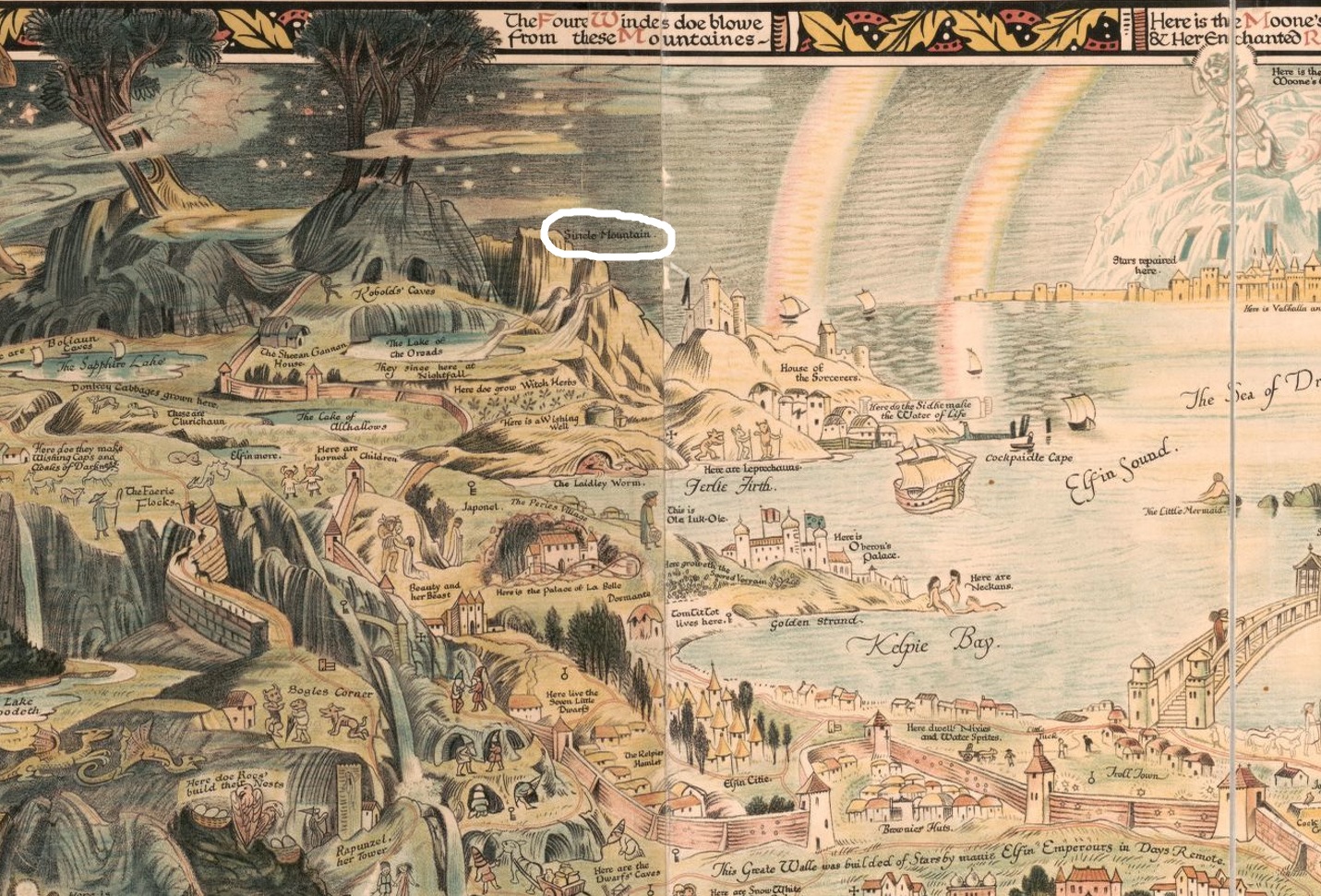
One day he was pushing his cart through the forest when he suddenly noticed a large and bare mountain which he had never noticed before...
While he was watching he saw twelve wild men approaching, and believing them to be robbers, he hid himself and the cart in the trees and waited to see what would happen. The twelve men went to the side of the mountain and said "Mount Semsi, Mount Semsi - Open Up!"
The mountain then opened a secret doorway through the middle, and the twelve men went inside and it shut behind them.
A little while later, the same men returned with sacks on their shoulders and they said "Mount Semsi, Mount Semsi, Close!" and the doorway in the mountain vanished.
The men then went away and once they were completely out of sight - the man thought he would test if it would work for him to, so he went to the side of the mountain and said "Mount Semsi, Mount Semsi, Open Up!"
Indeed the mountain opened up and as he entered he found a cavern filled with gold and treasures and jewels. The man did not know what he should do, but at least he decided to fill just his pockets with the gold - leaving the pearls and precious stones where they were.
Upon leaving, he also told the mountain to close and it did.
He no longer had any cares for he could easily buy enough food with the gold and he lived happily and honestly. He gave to the poor and did good for everyone. Then when he began to run out of money, he borrowed a bushel/container from his brother - and went to get some more. He did this again a third time when he ran out, but his brother who had long been envious of his wealth and not knowing where it could possibly all be coming from - set a trap to find out. So he covered the bushel with pitch, and when his brother returned it to him there was still a gold coin stuck to it. So he asked his brother what he had been measuring in the bushel - and he told him "wheat and barley".
Then the man showed him the gold coin and threatened his brother that if he did not show him where the treasure was coming from - he would involve the courts. So the poor man told him everything that happened to him.
The rich man being greedy for more wealth then went to find the mountain for himself - taking a whole wagon this time and intending on getting even more than his brother. He got to the mountain and cried "Mount Semsi, Mount Semsi, Open Up!"
And the mountain opened and closed once he was inside, and he spent a great deal of time gathering all the many treasures he wished to take. He wanted to carry what he had found outside - but suddenly realized that due to his preoccupation with all of the treasure he had entirely forgotten the password. He said "Mount Simeli, Mount Simeli, Open Up!" - but the mountain remained closed.
None of the treasures were of any use to him as he remain trapped in the mountain.
In the evening, the mountain opened up and the twelve men returned - and knowing that their treasures had been taken from and believing they had finally found the culprit they set to kill him. He begged and pleaded, telling them that it was his brother who had stolen the treasures - but despite all of his begging they chopped off his head.
So clearly there is a message in this story about having the right intentions and purity with given treasures, and using them for the good of all people and not only oneself.
It was only once I decided to start releasing all of this information at this website for free online that the fairies began to reveal many of these secret treasures to me - and so now I wish to share some of them with you...
So near to the "Simele Mountain" is a "similar" or "connected/interlinked" story - and it was given to me in a dream this morning that "Simele" meant "Simile" and that it would make me "smile" if I traced a line from Simele Mountain to its "Similar" connection.
I awoke from this dream in great wonder and immediately consulted the Faerie Map.
Remembering that the night before I had read the story of "Japonel" - about a girl who goes into the woods and loses her reflection in a lake to an old witch - who is then later put to sleep when flocks of birds drop "poppy seeds" all through the lake to put the witch to sleep - after which the reflection rises to the surface to return to its owner.
It suddenly dawned on me that Poppy Seeds are very much like "Sesame Seeds" - and that the Story of Simele Mountain is very similar to the "Open Sesame" story from the Arabian Nights.
Upon realizing this, I also remembered that there was a little "key" symbol drawn next to "Japonel" which represents "Dwarf Treasures" on the map. The "Oreads" or nymphs of the mountain also appear to be pointing upward to this direction as if to hint at the line to be drawn.
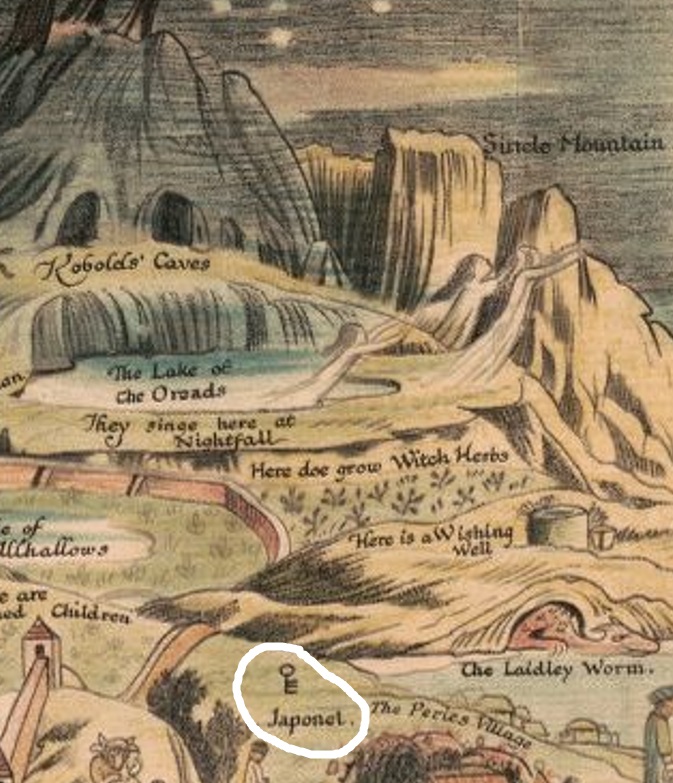


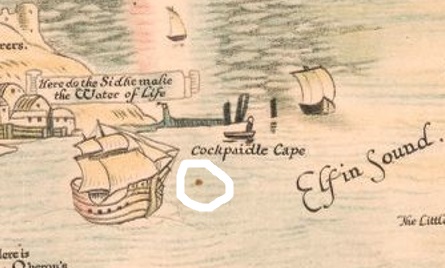
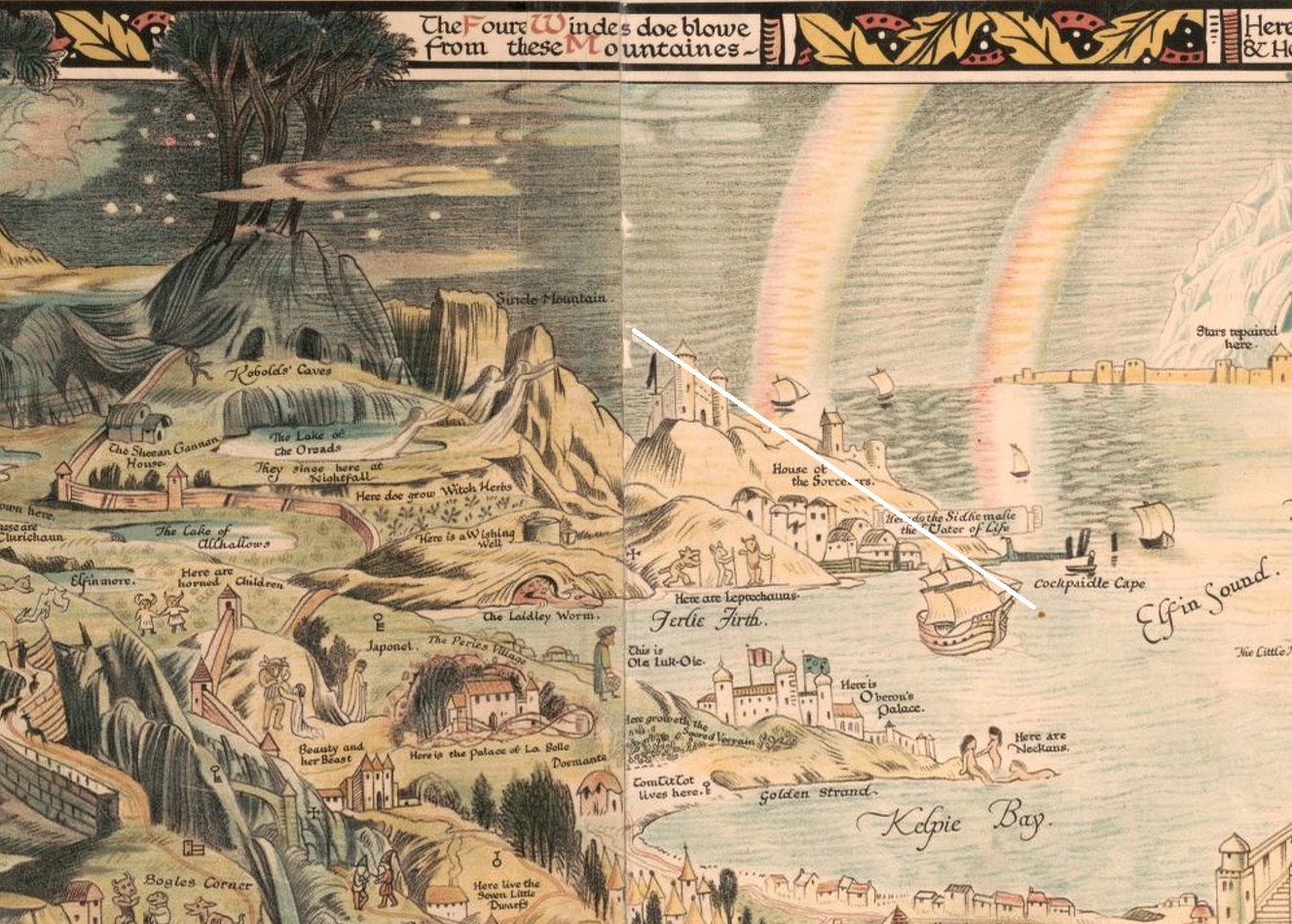
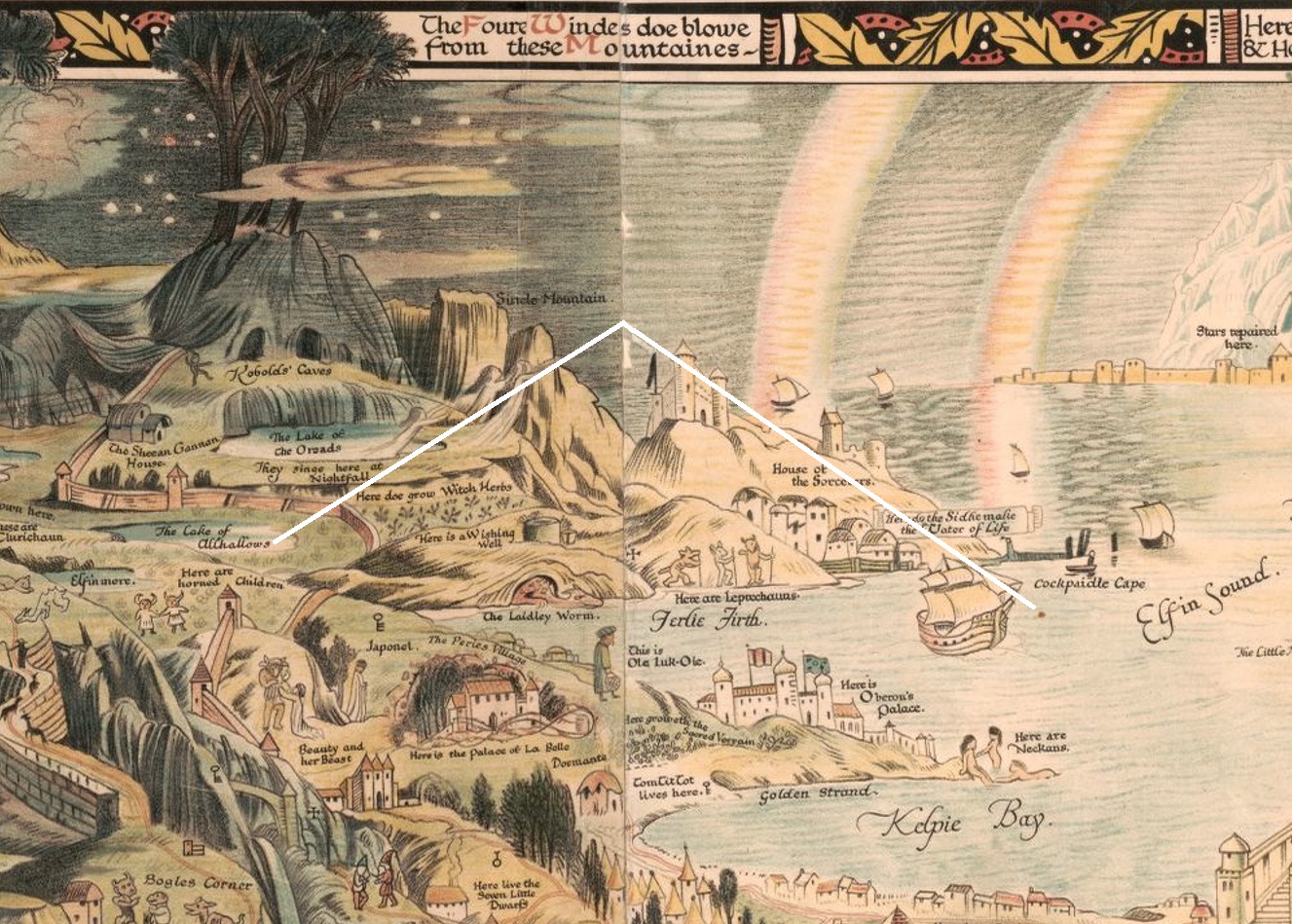
When I first contacted fairies and accessed Faerieland - they channeled through me what I have always referred to as the "Faerie Emblem". I saw it superimposed over the "Southern Cross" which is particularly prevalent in New Zealand and on the flag itself. The imagery of a serpent rising along the sword as a cross in the center of a kite-shape was with me from the earliest faerie drawings and experiences that I was ever given. Therefore it did not take long to discover the other little key hidden by the dwarf caves:
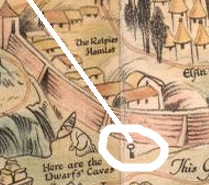
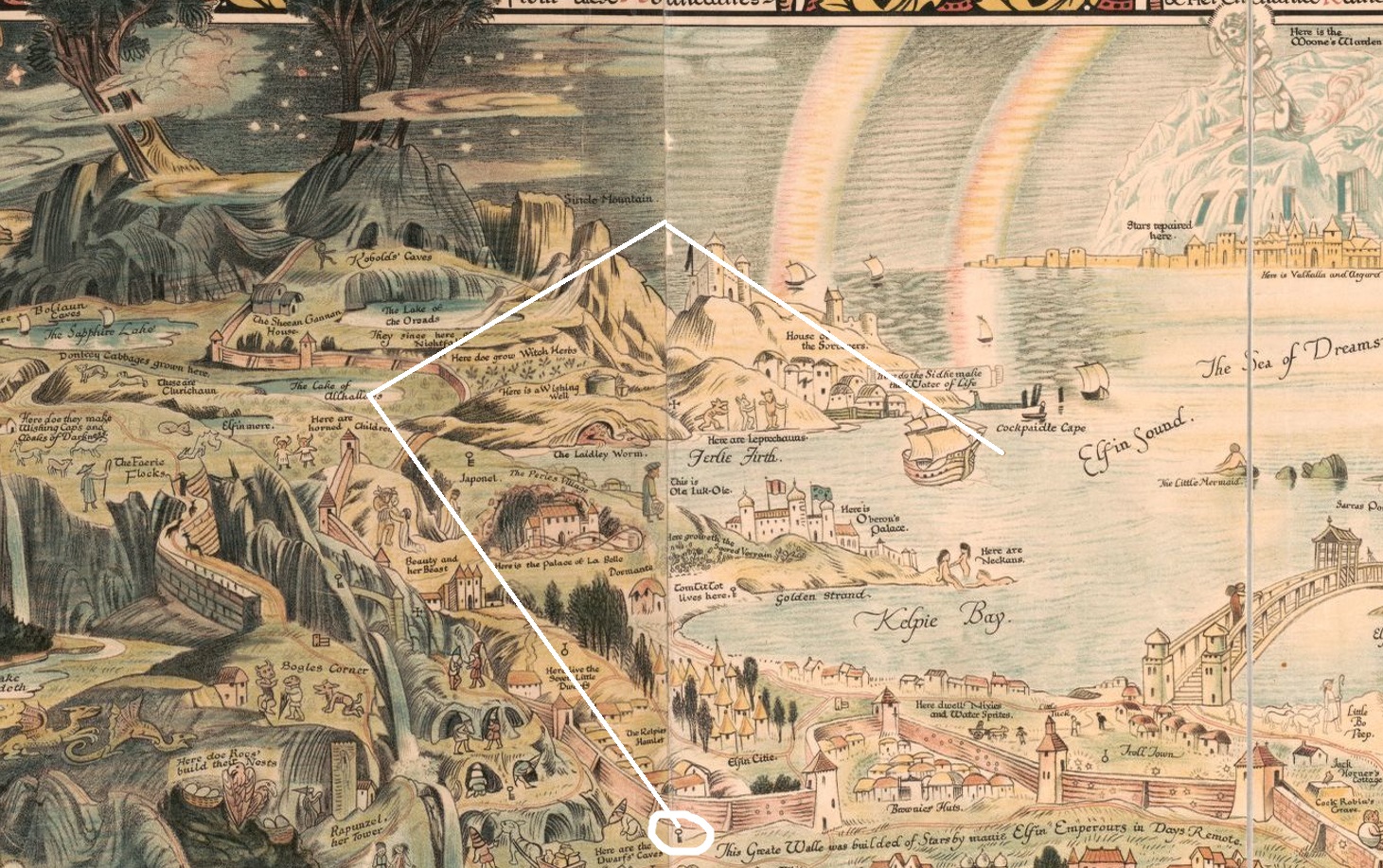
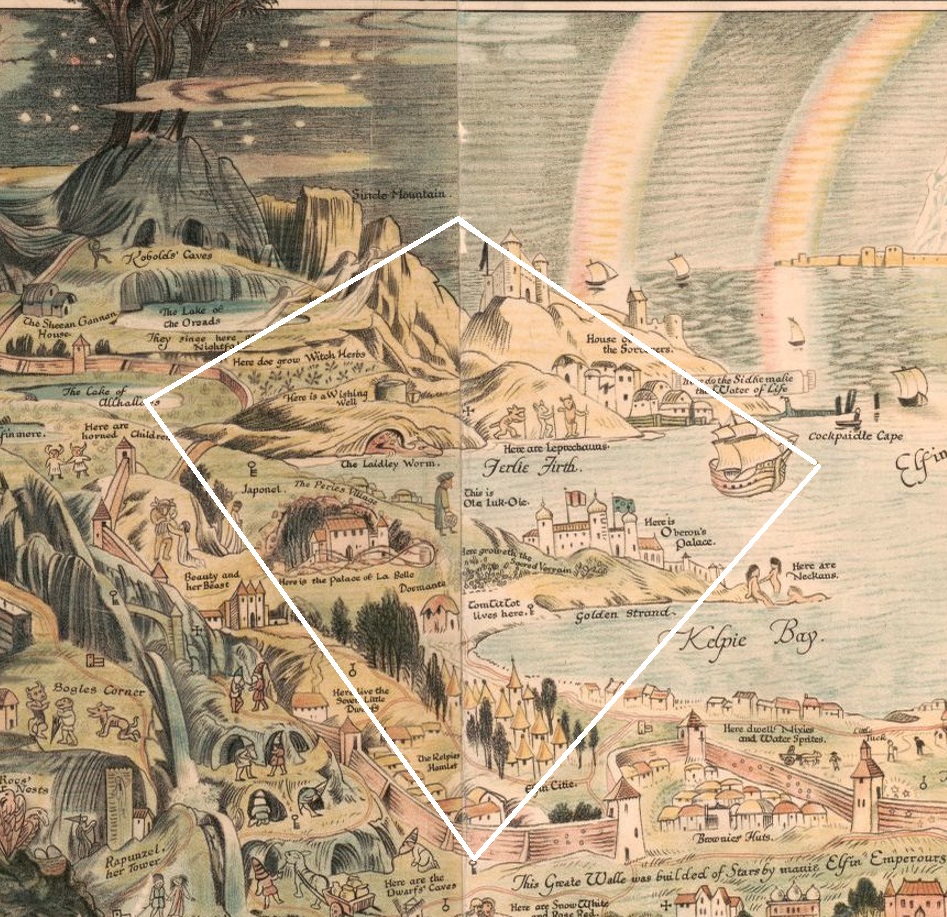
The crease down the center of the map then provides the middle line (where the sword goes through - while the center piece is implied by the "cross" associated to the Lake of "All Hallow's Eve" (or "All Saints Day") - as well as the "Faerie Shrine" cross key shown right above the center of the cross piece next to the leprechauns. Meaning that here we have found a "pot of gold" at the end of the rainbow - the secret dwarf gold - and the Hidden Key to the Gates and Treasures of Faerieland.
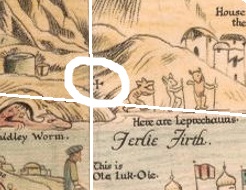
I will discuss "Ole-Luk-Oie" in future chapters, but suffice it to say that he is clearly also representative of Hermes/Lucifer (hence the name "LUK" and being a dream traveler - bringer of dreams). He is very strategically and intentionally placed next to this dragon here because of the quote in Revelation 20:2 that says "And he laid hold on the dragon, THAT OLD SERPENT, which is the Devil, and Satan, and bound him a thousand years."

